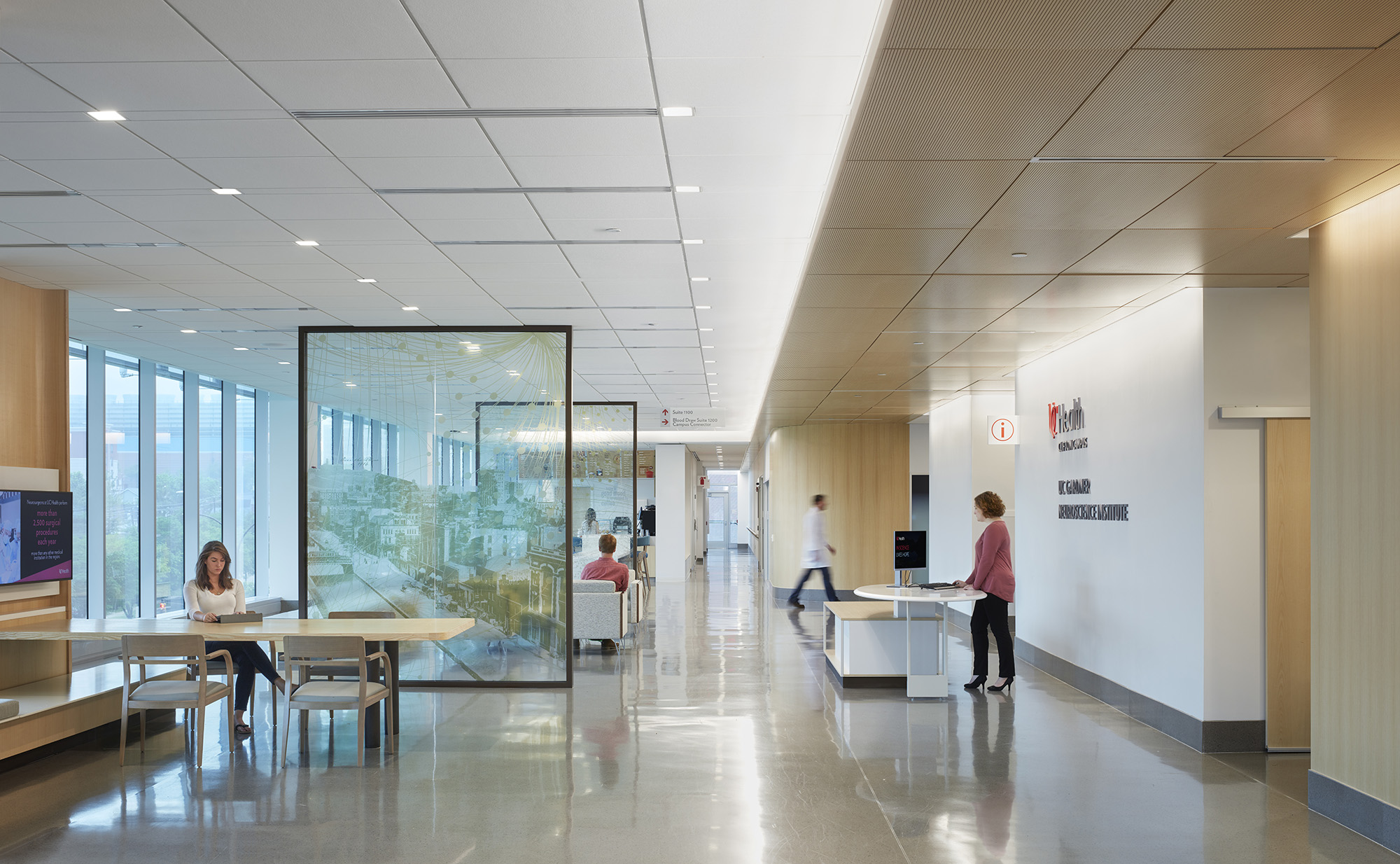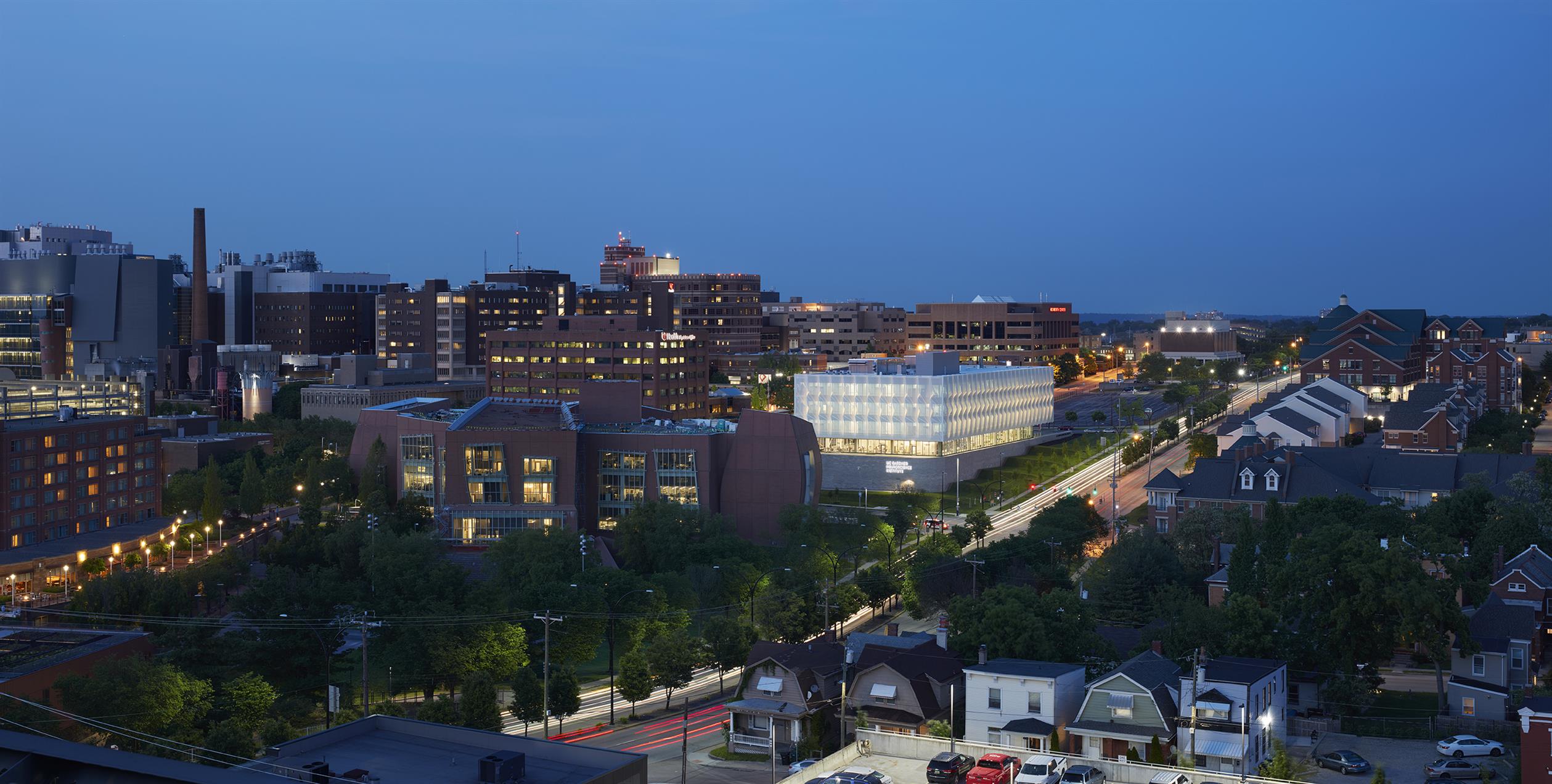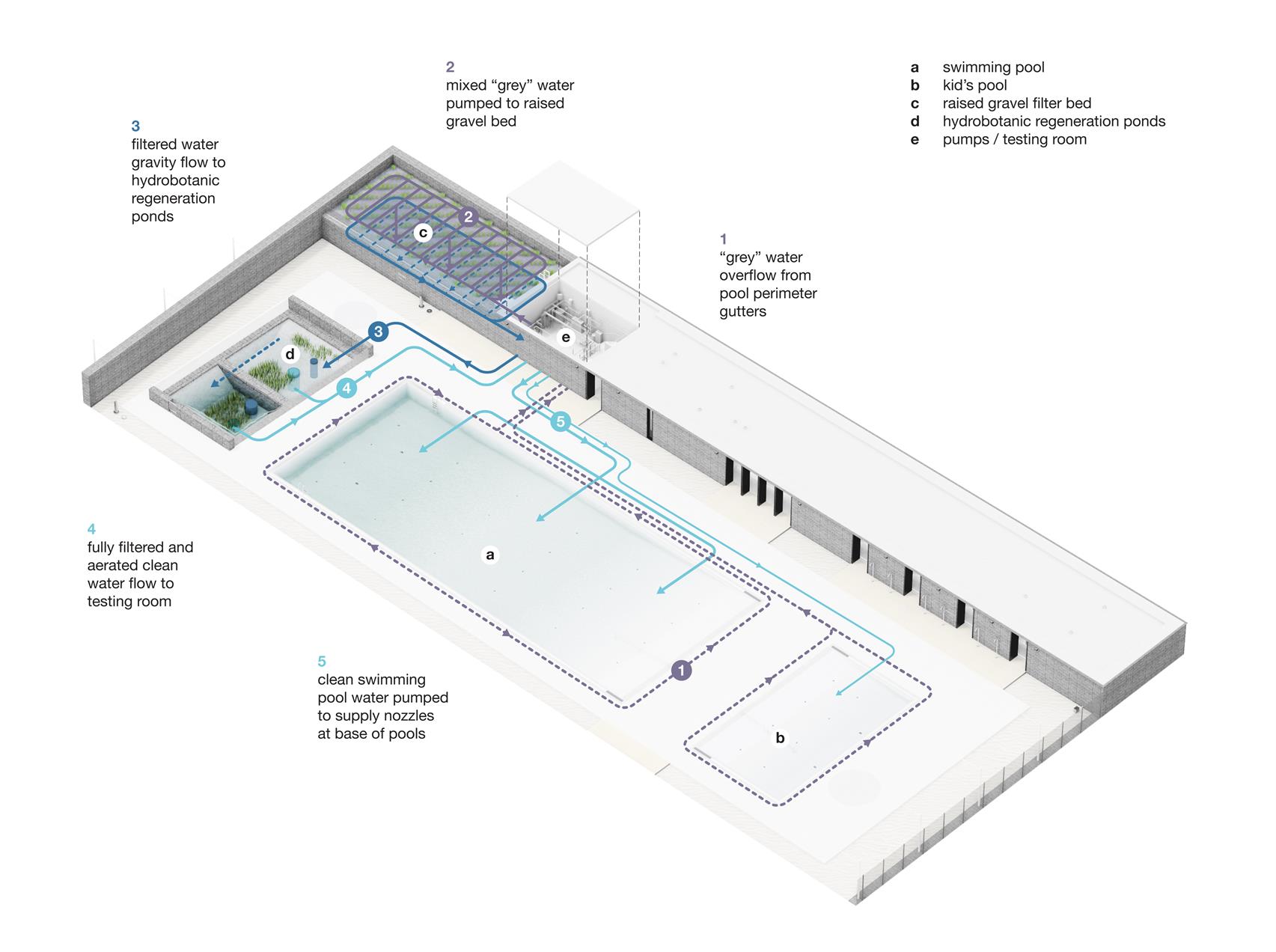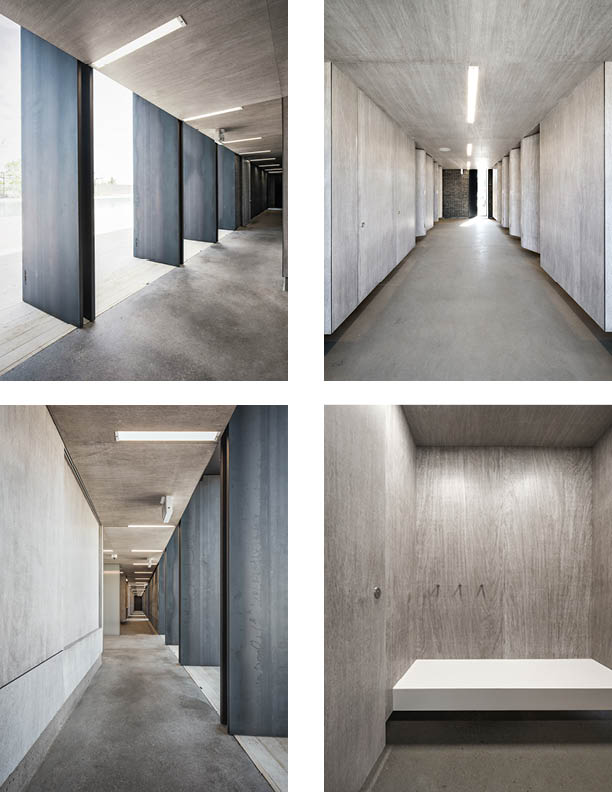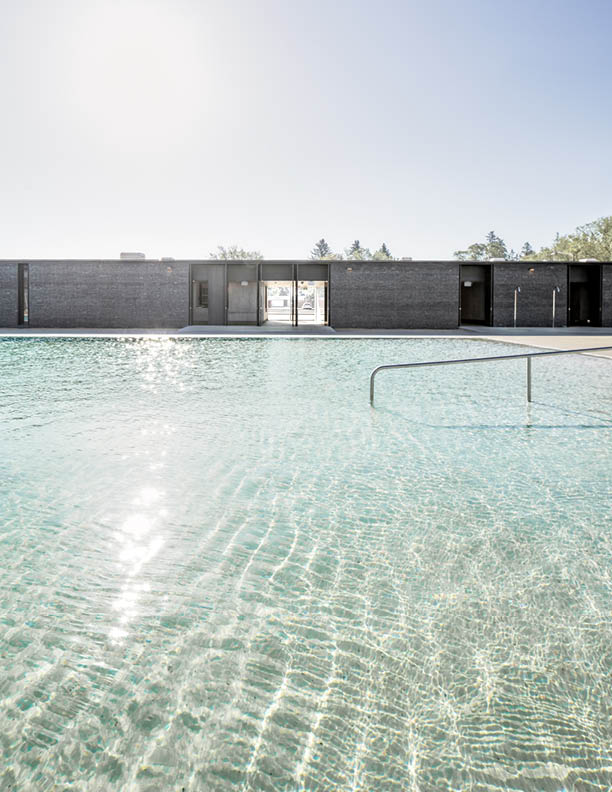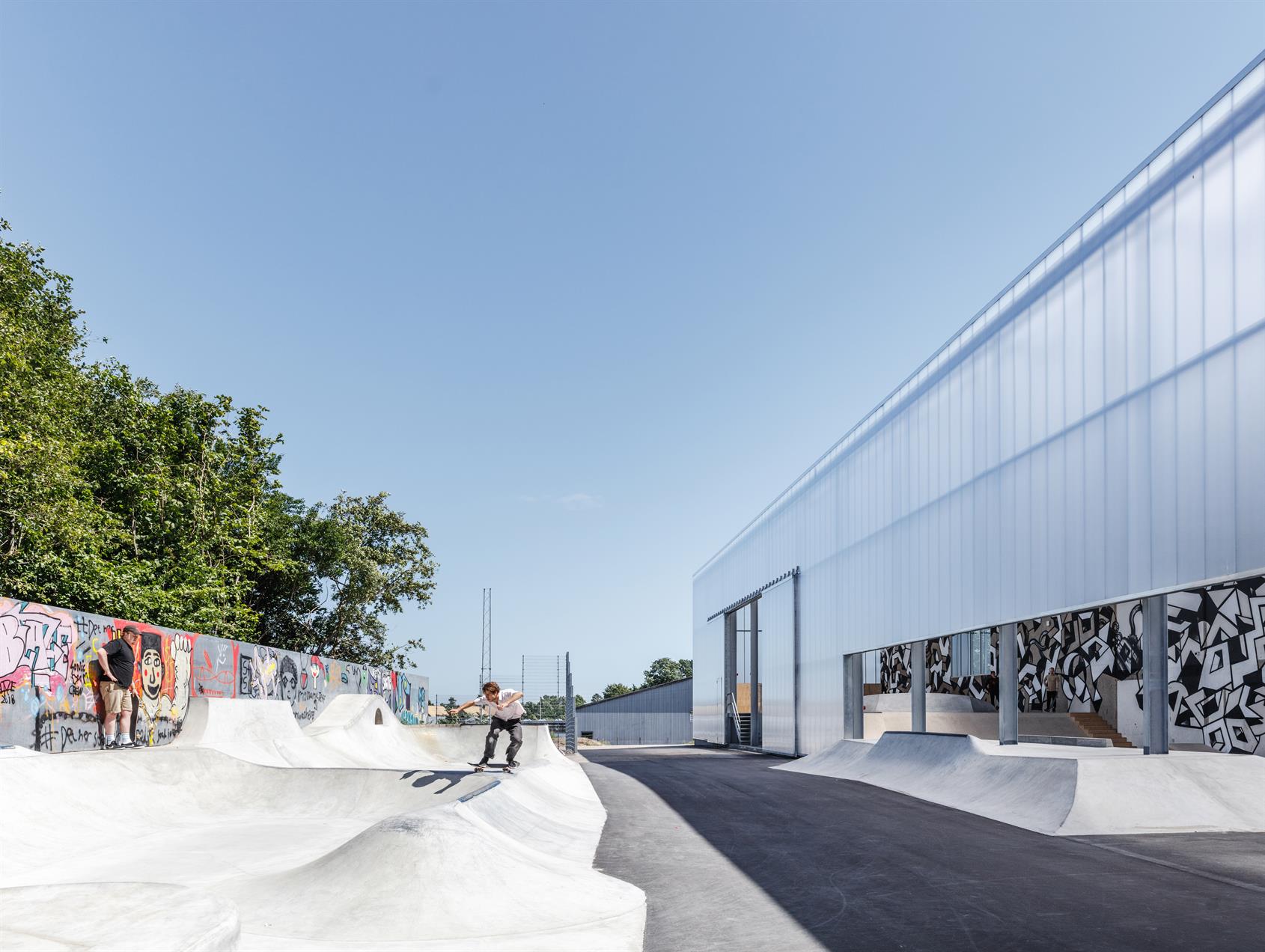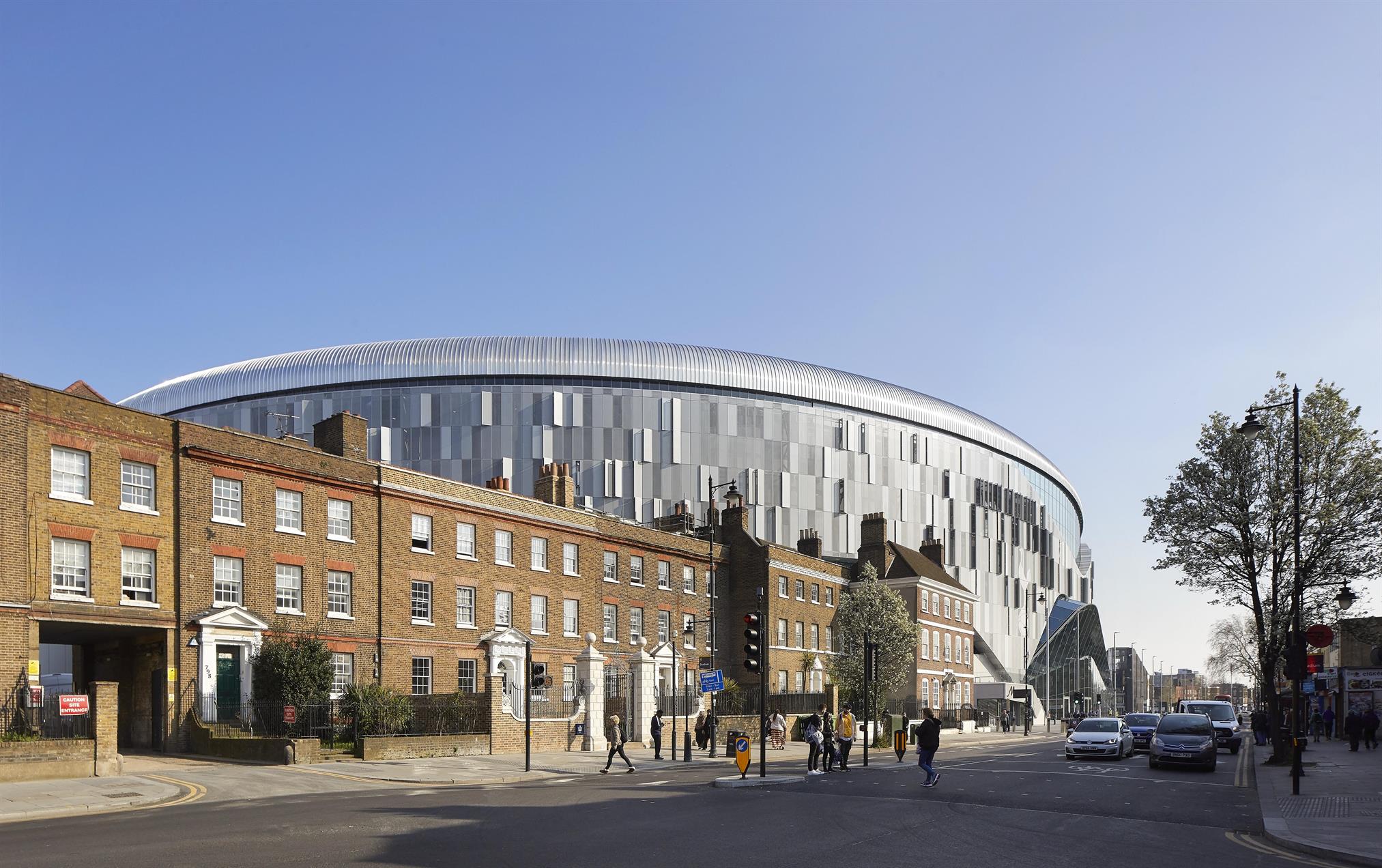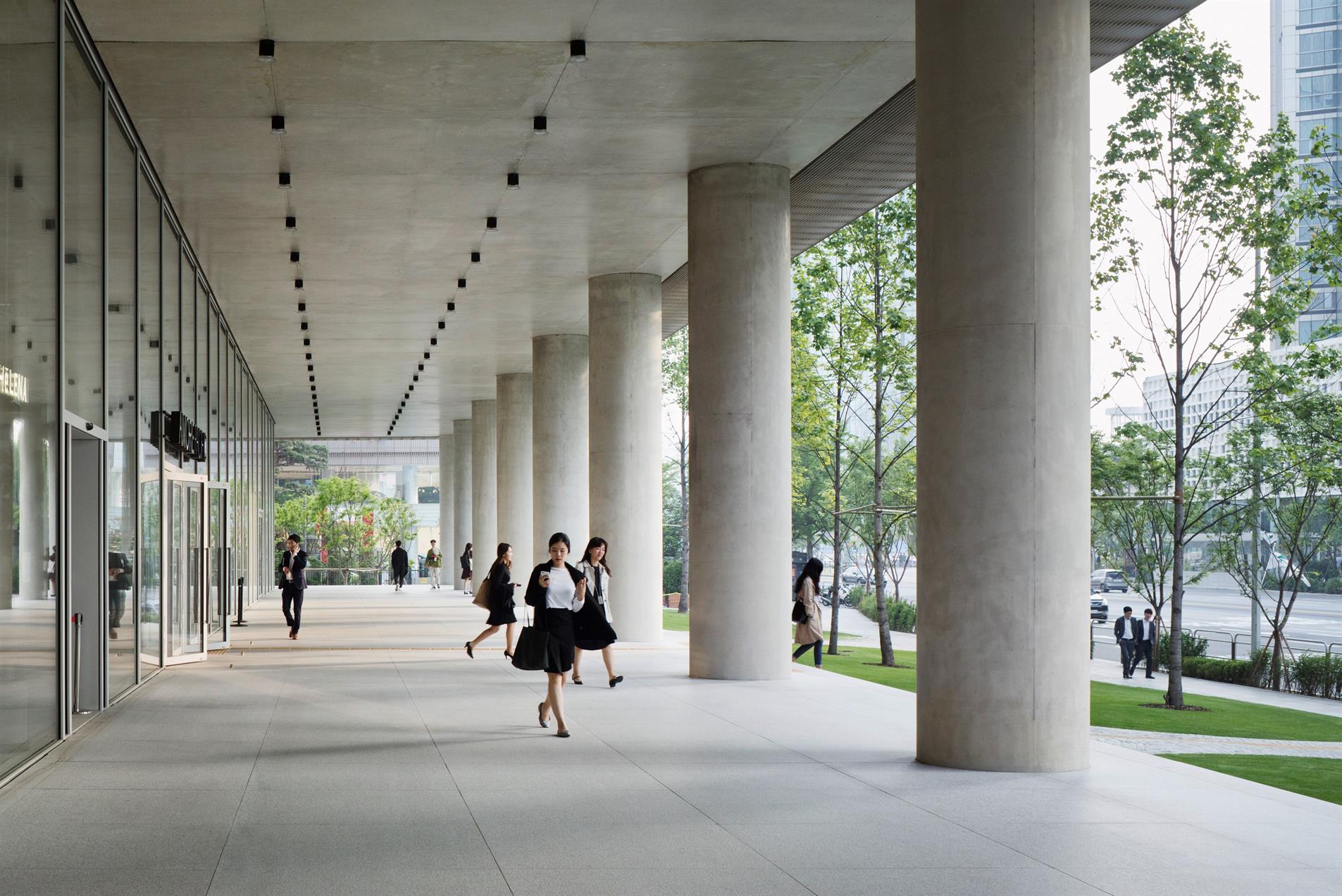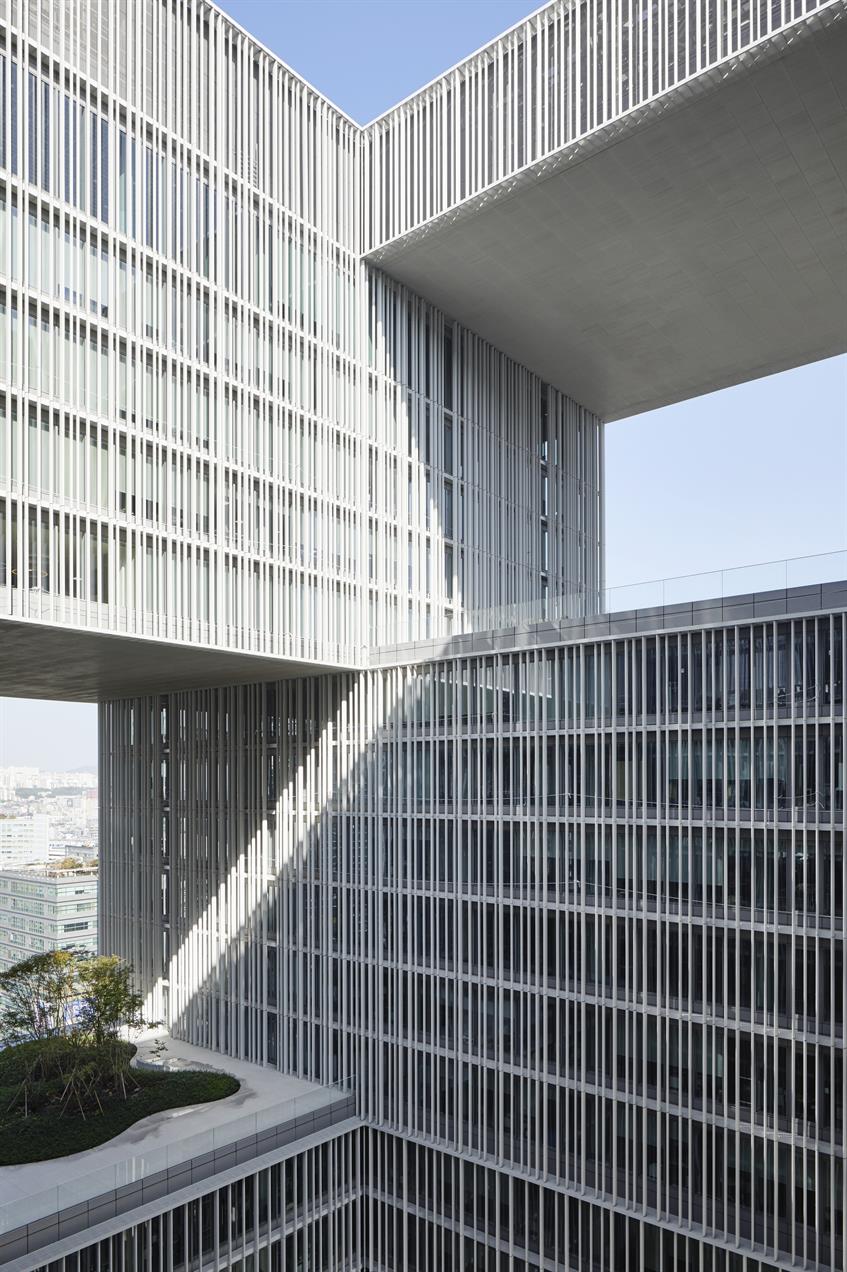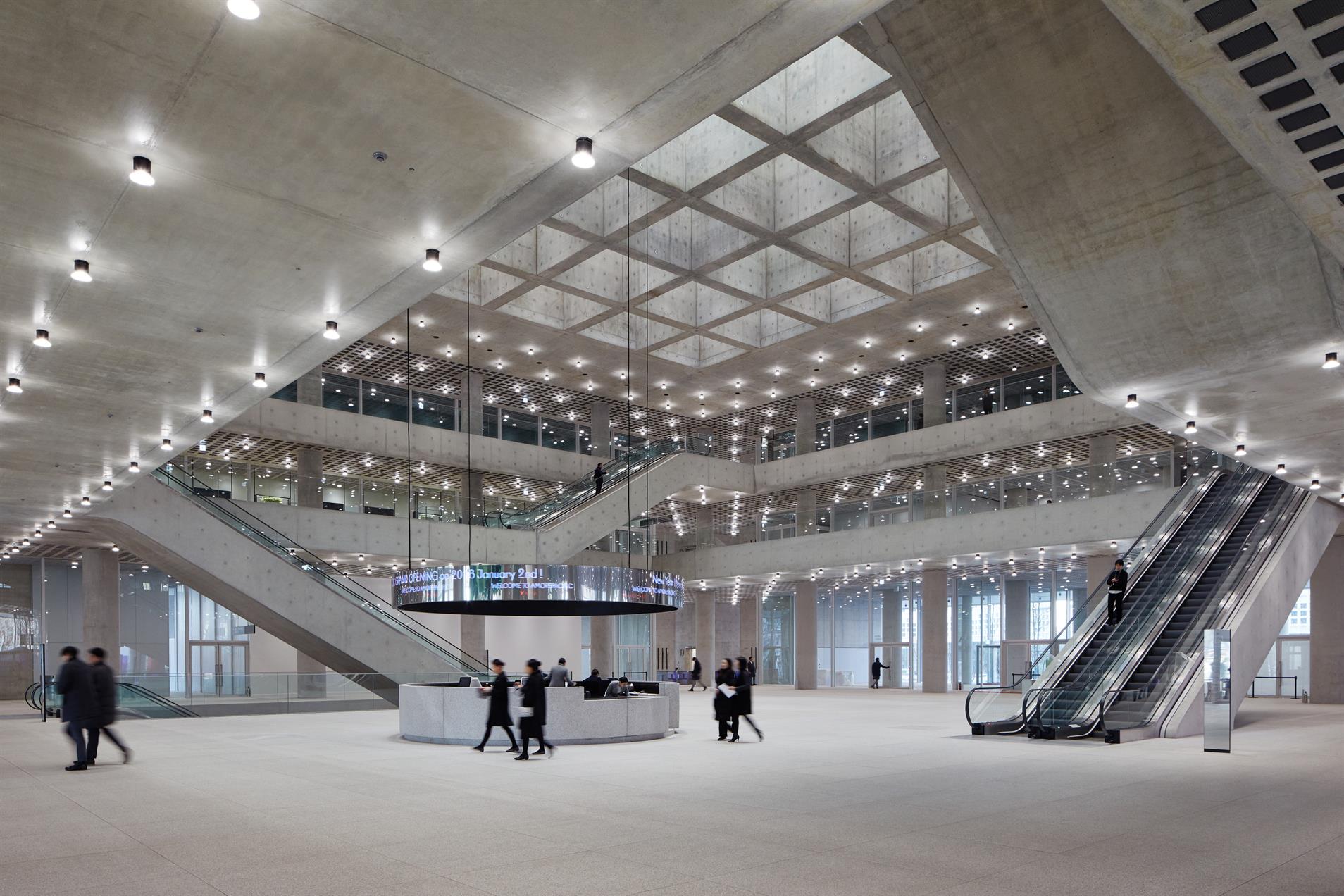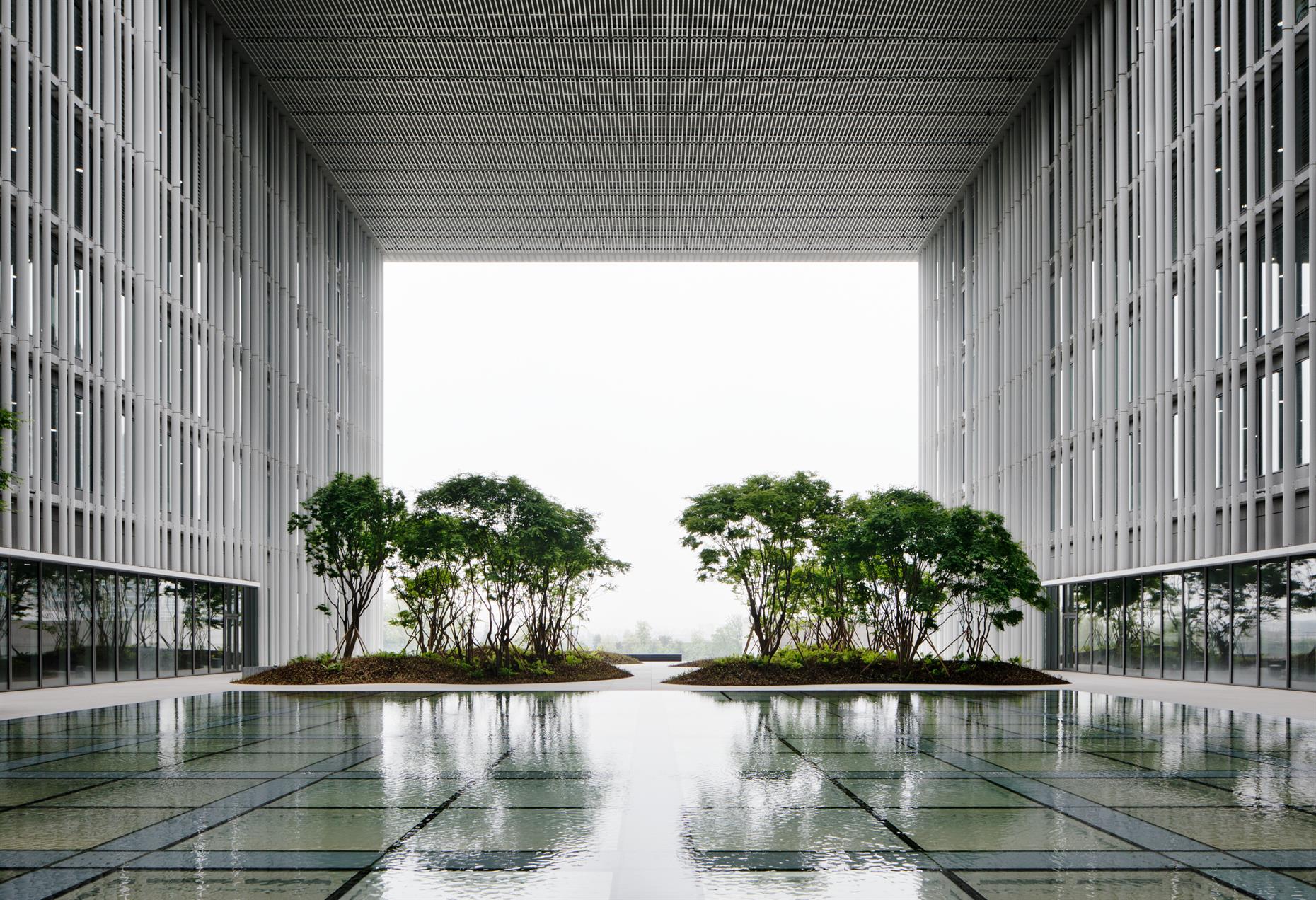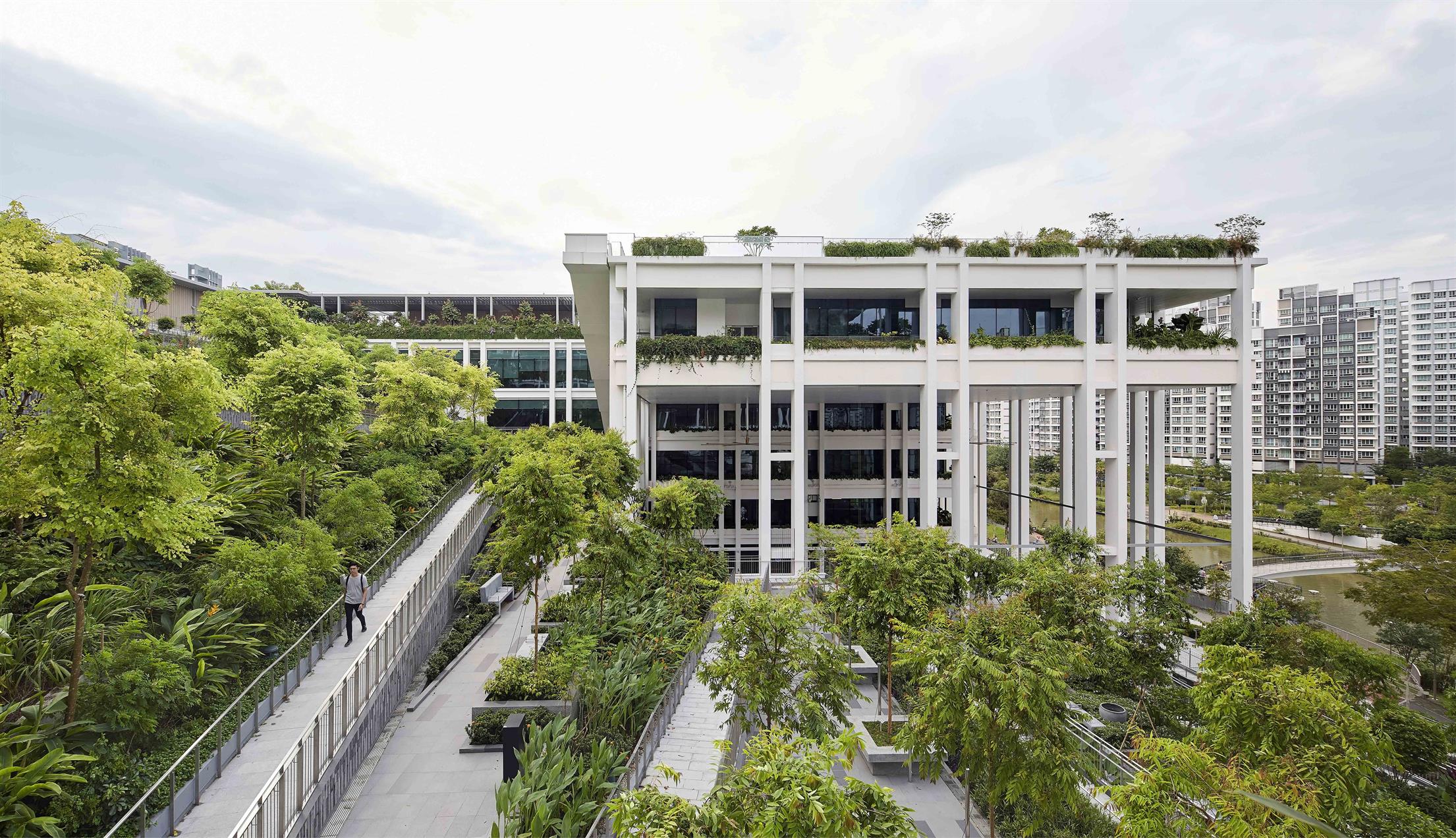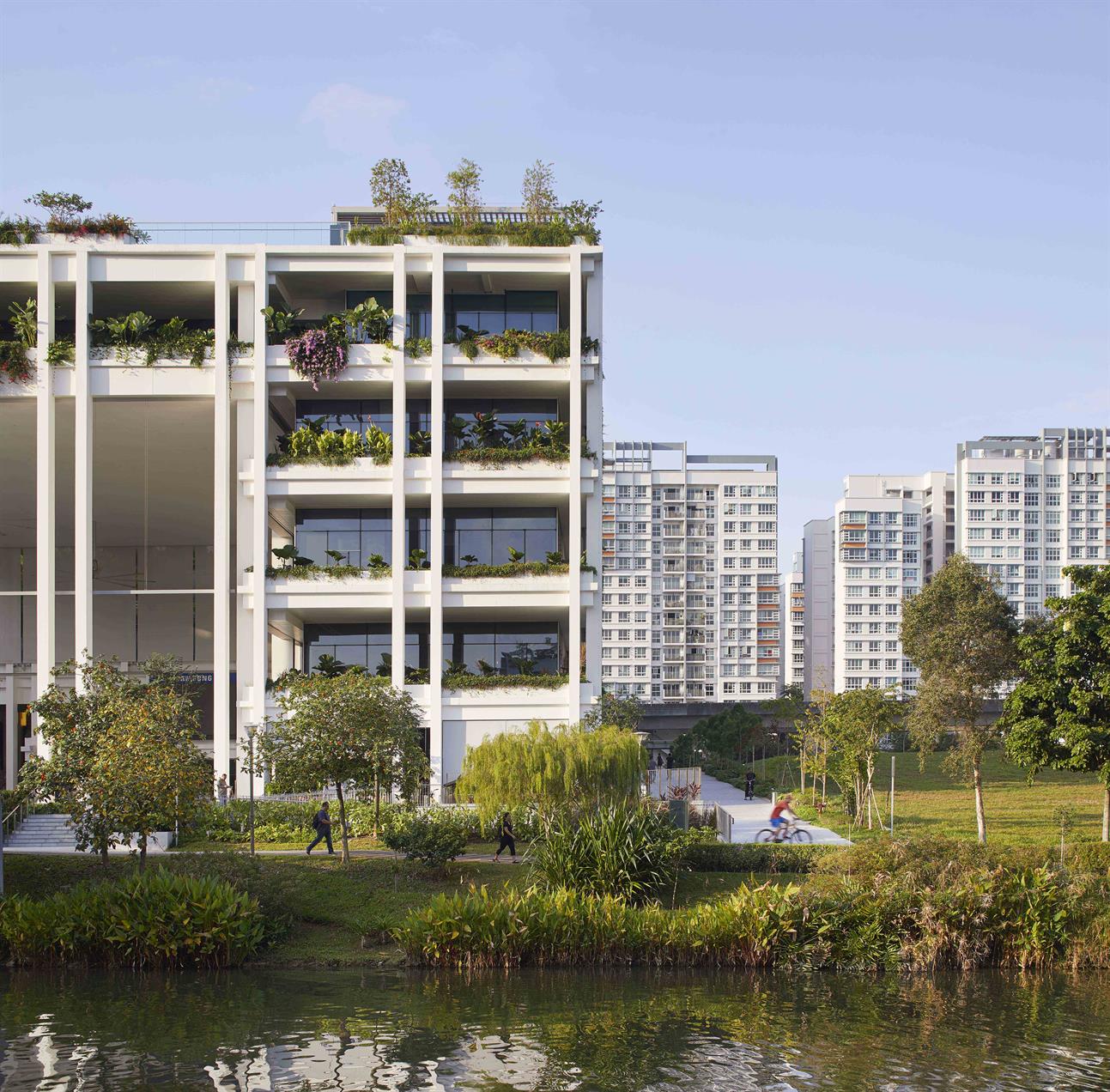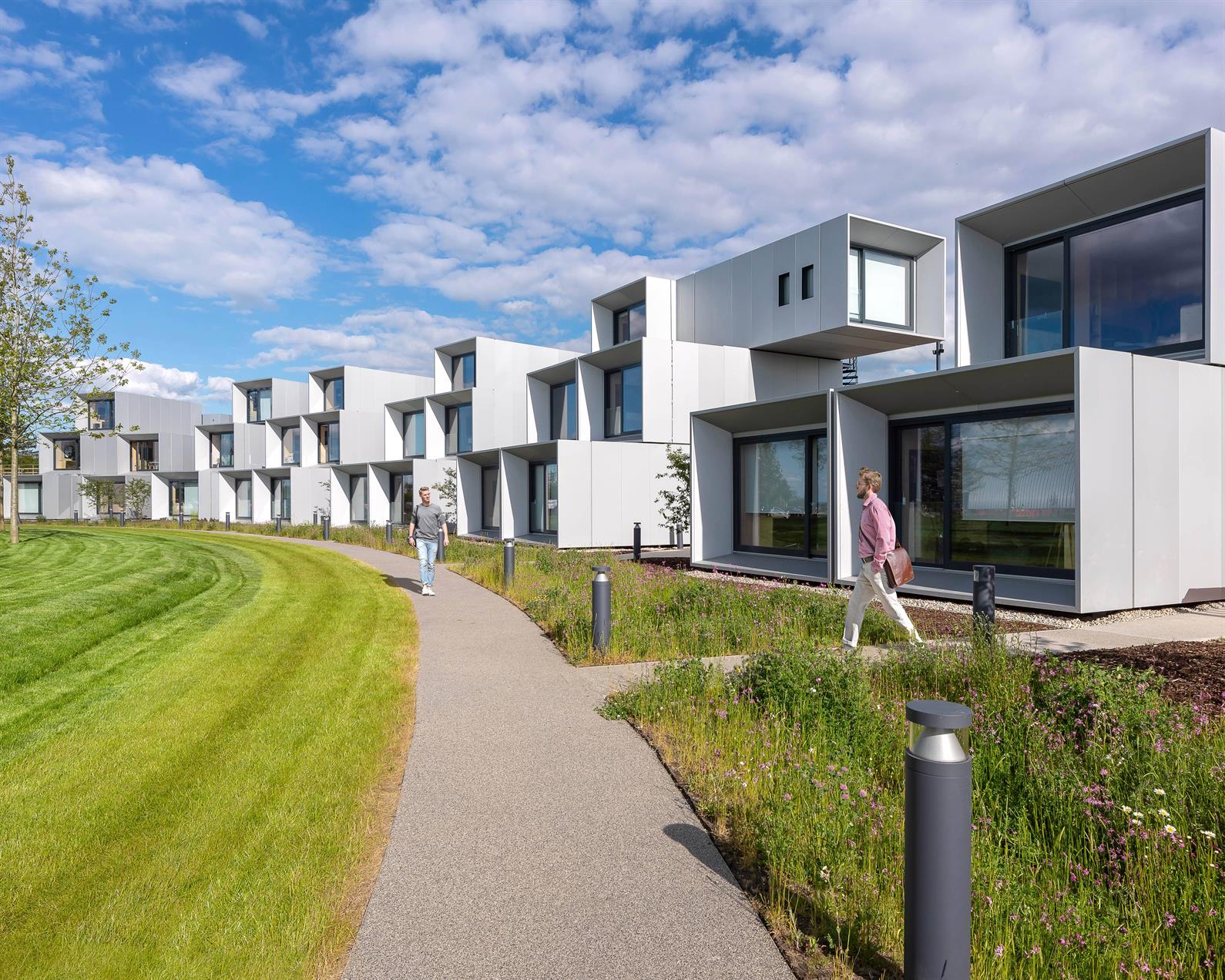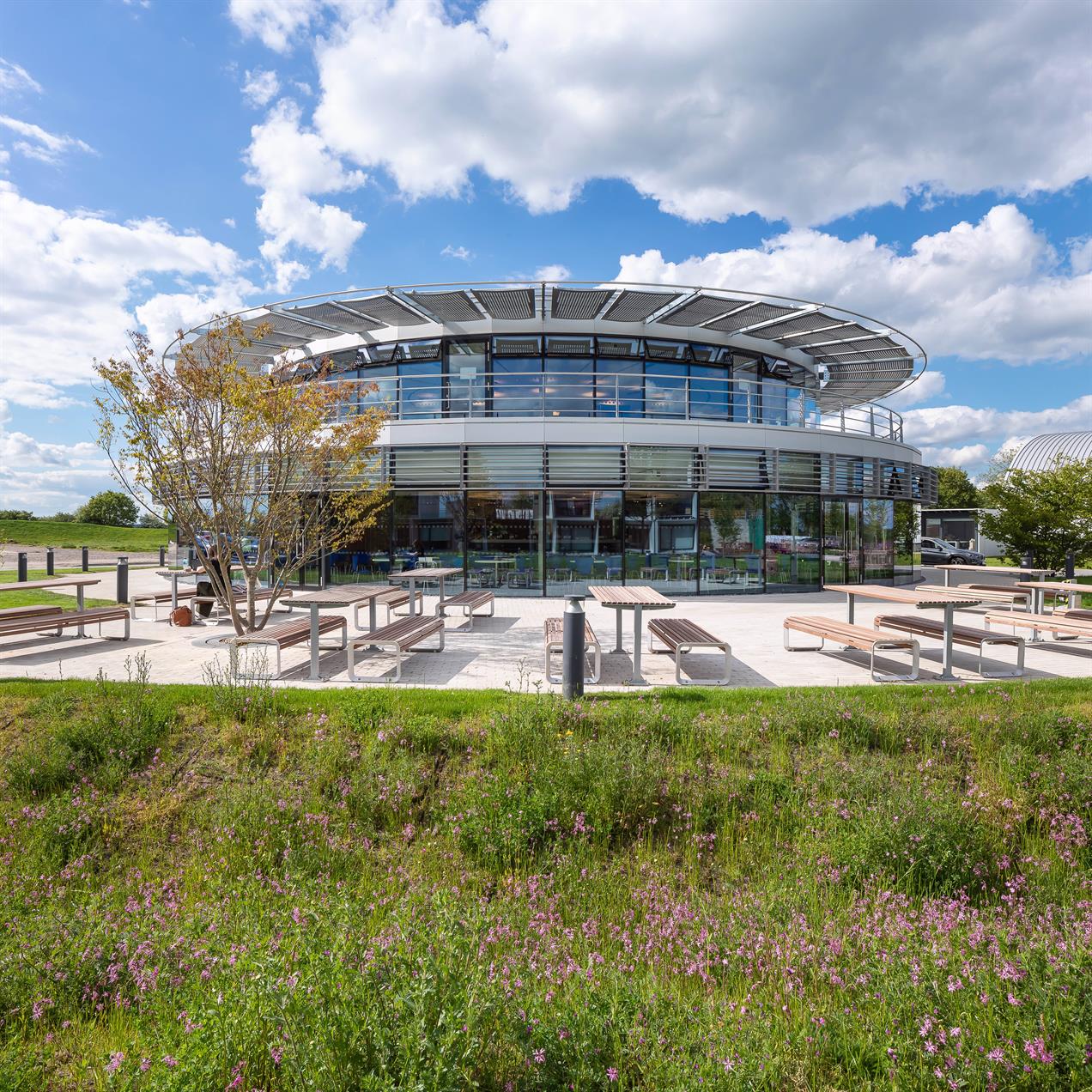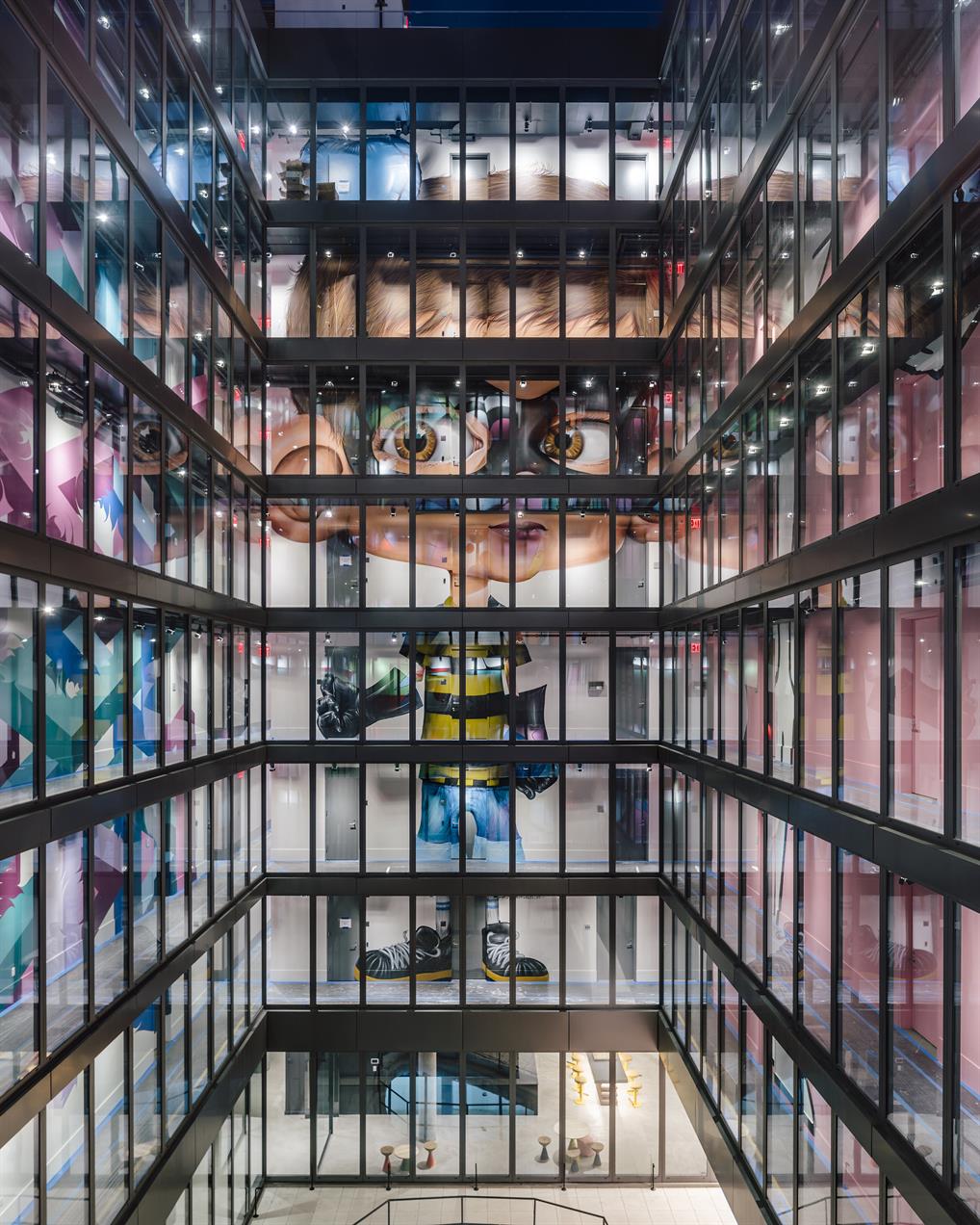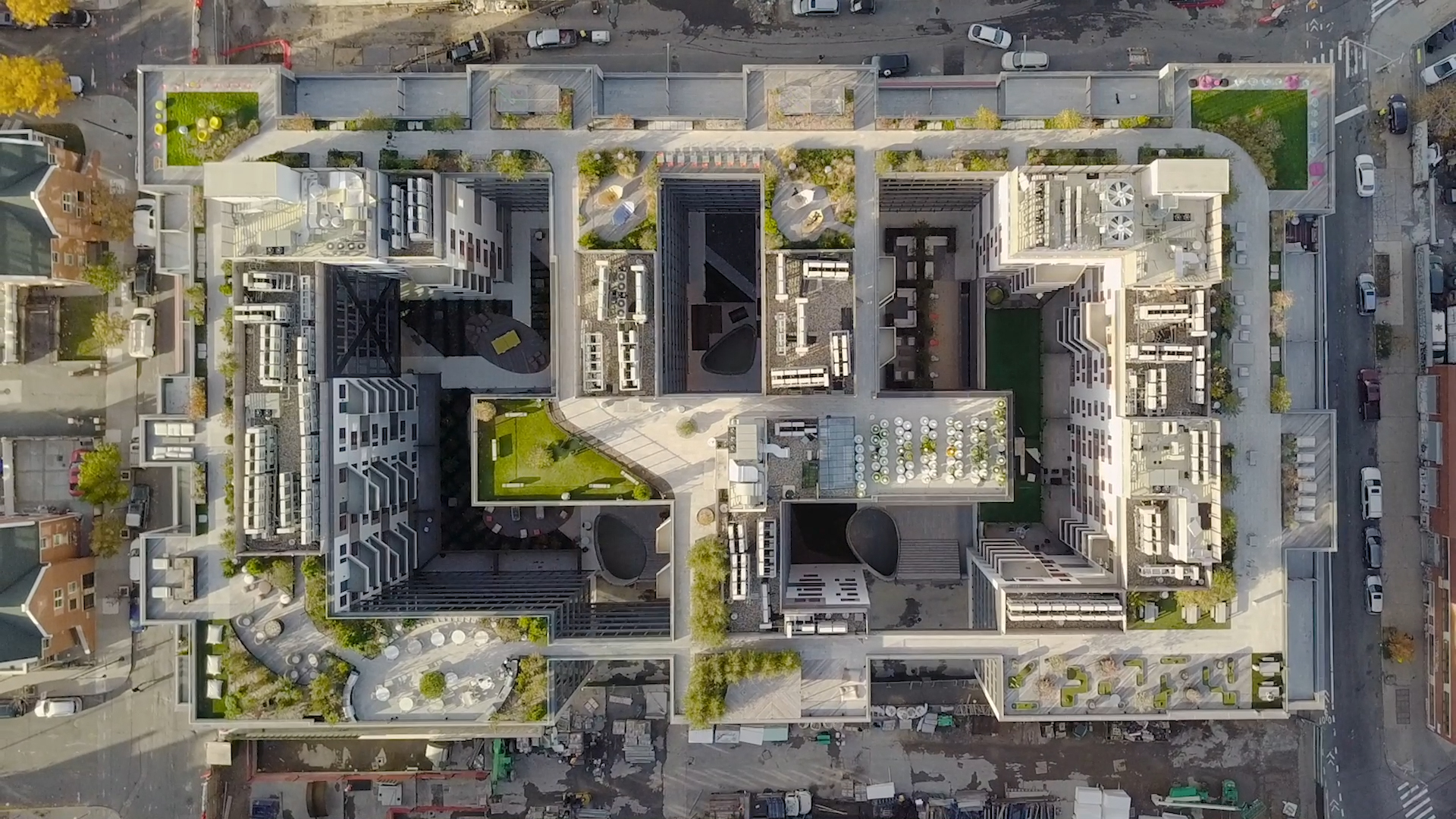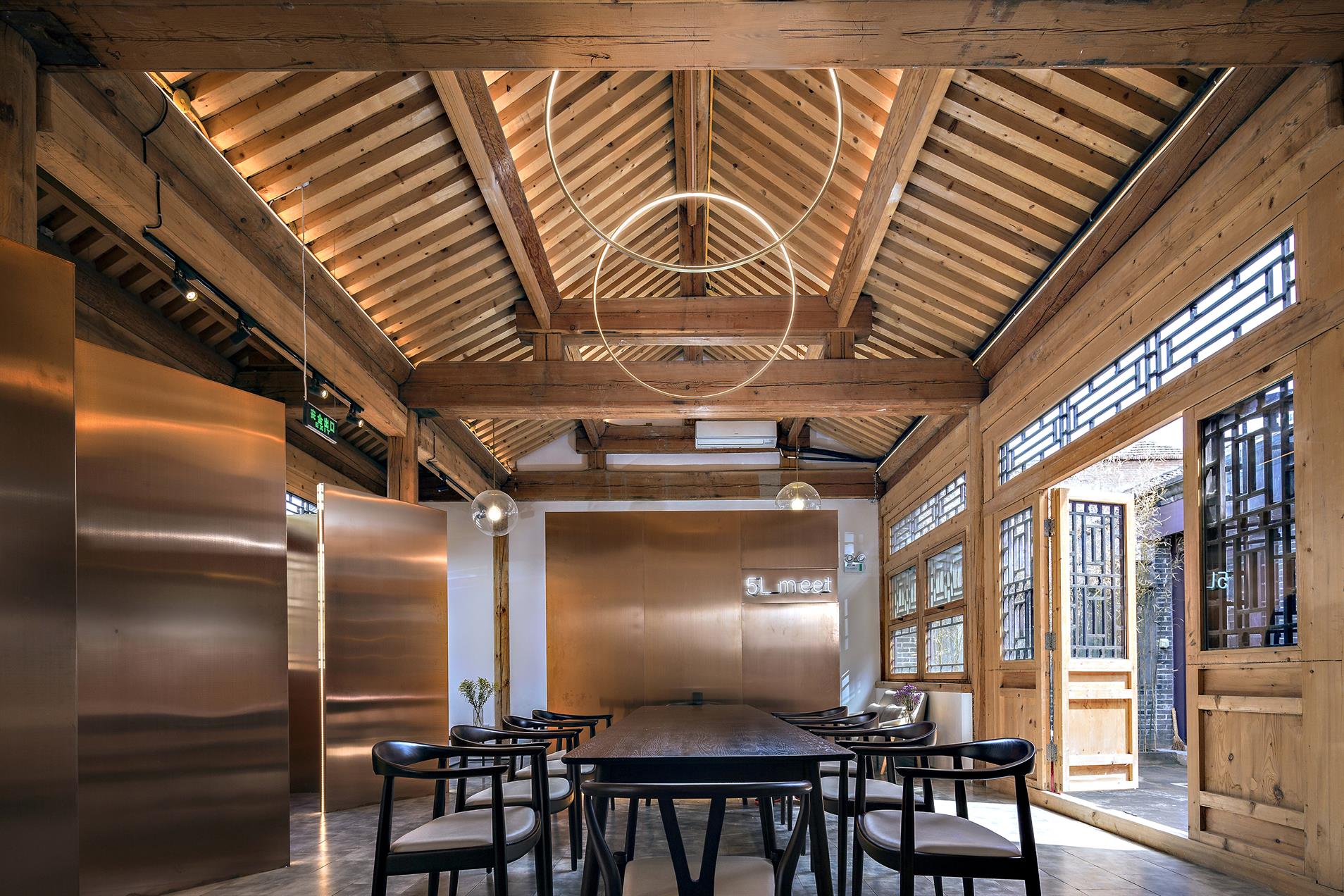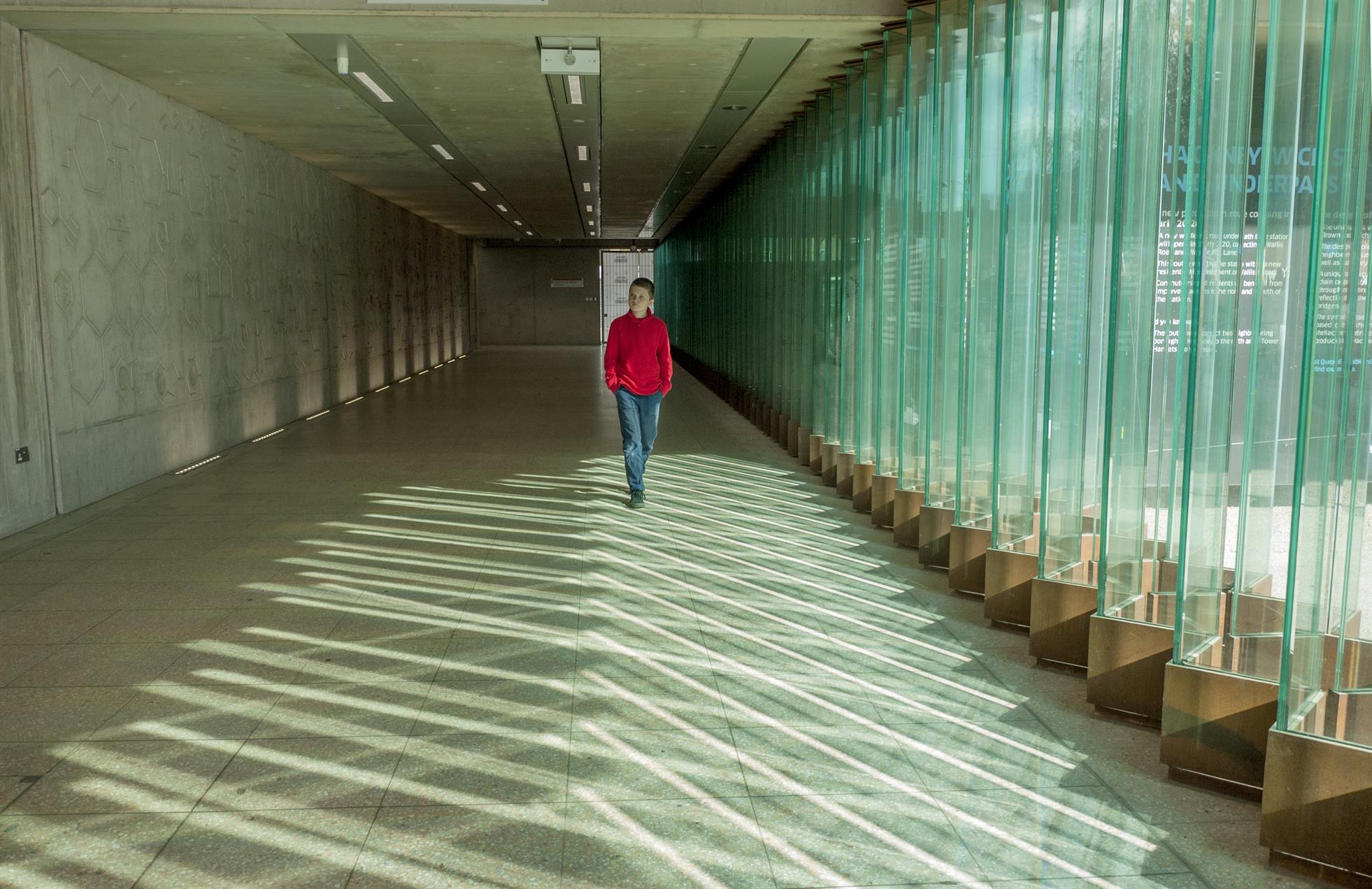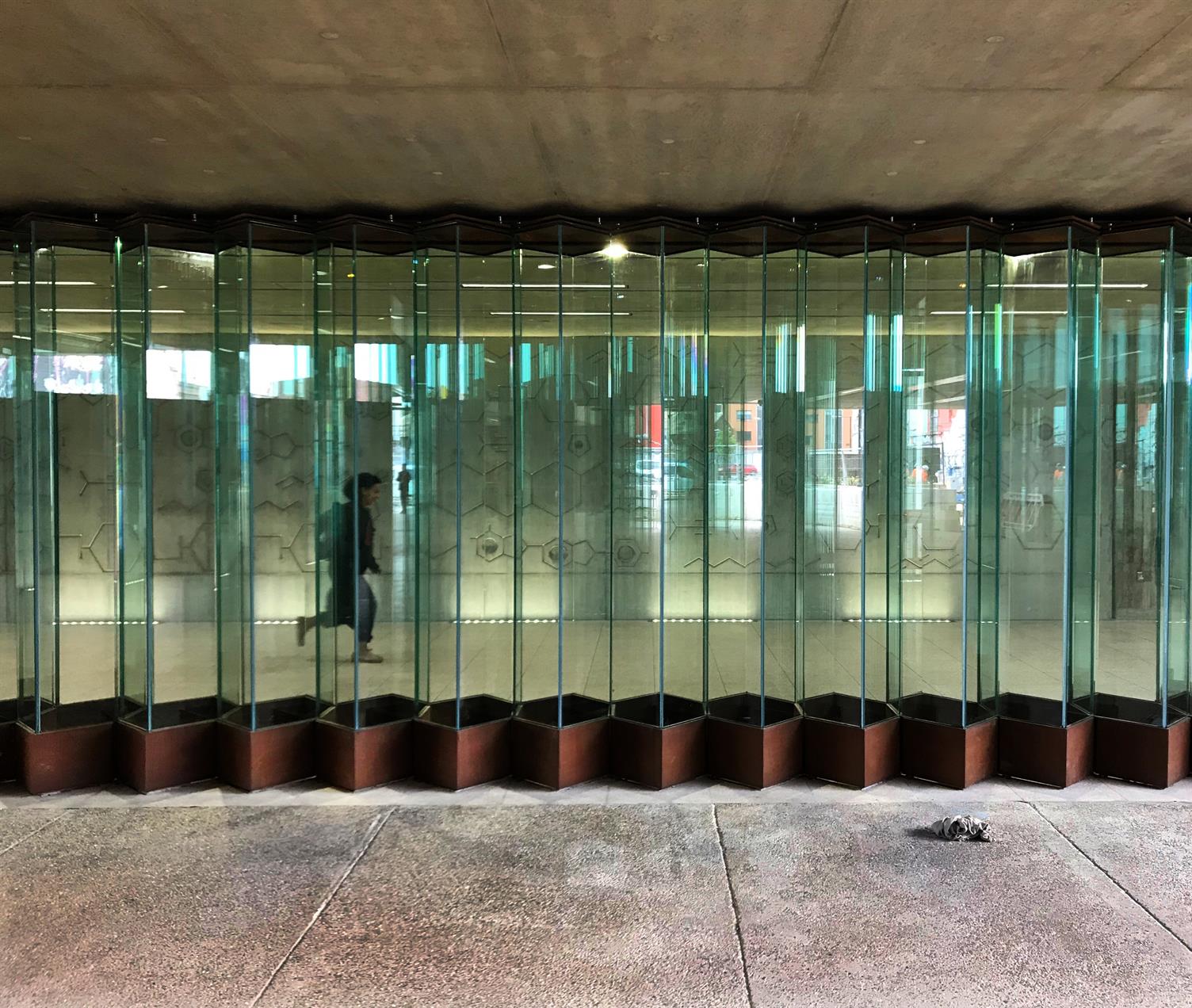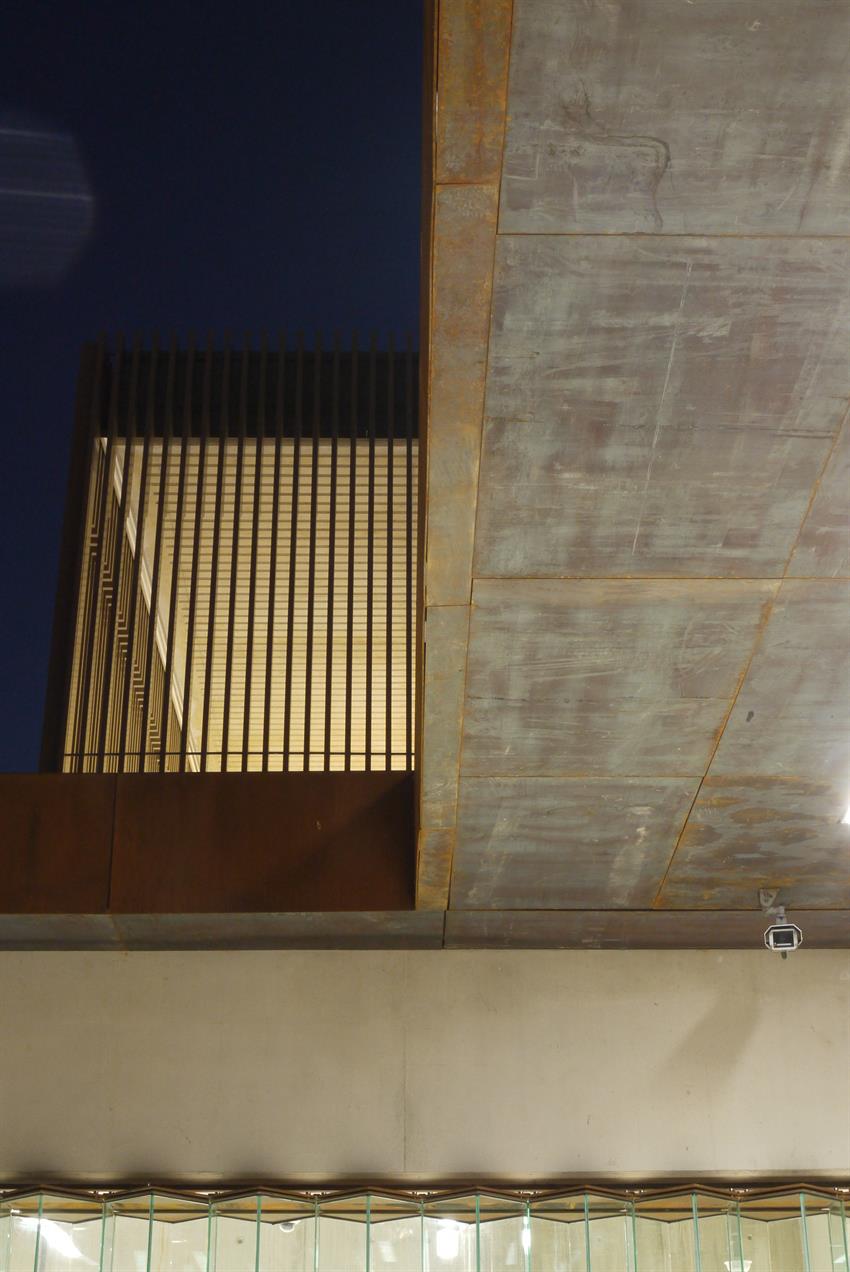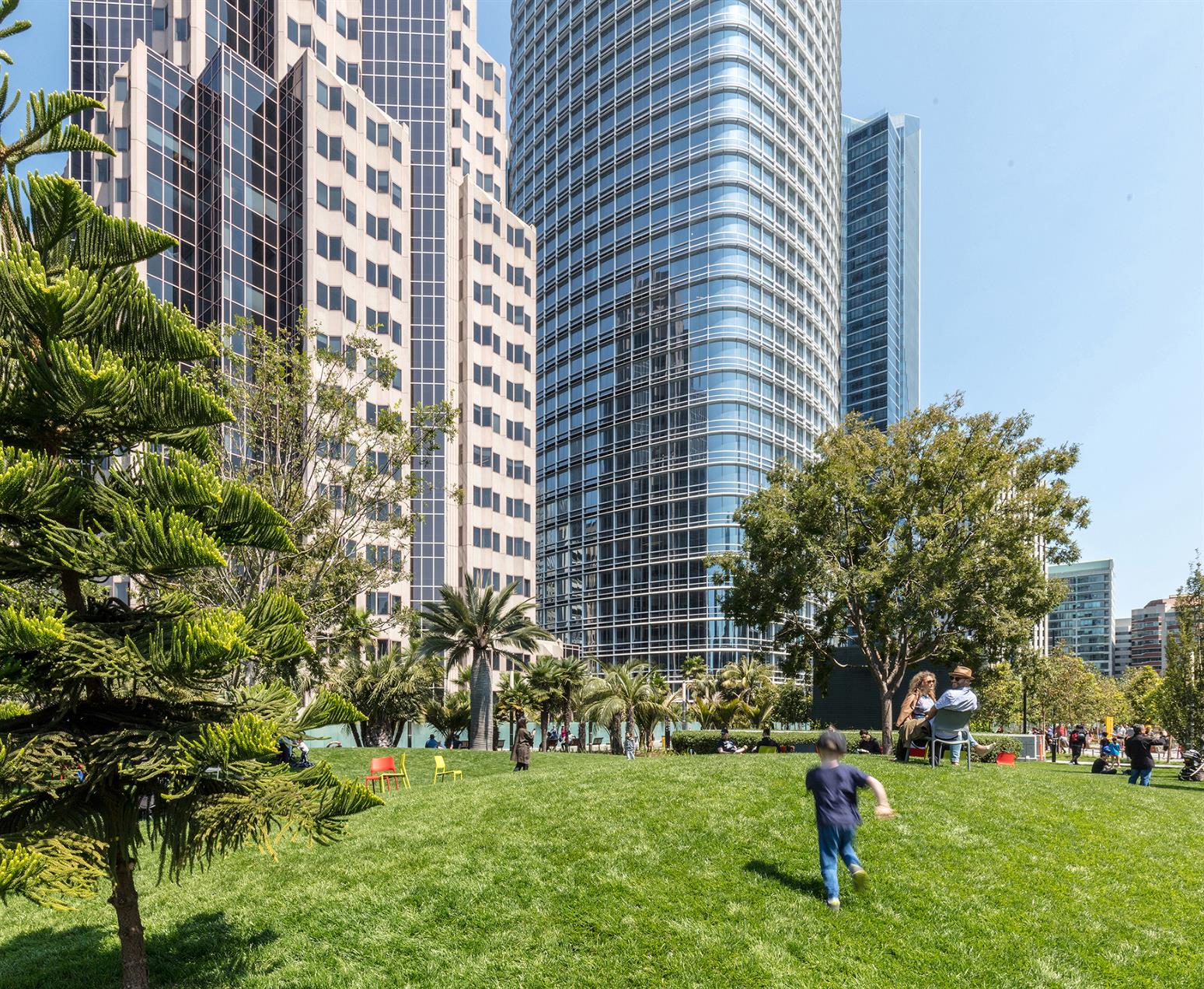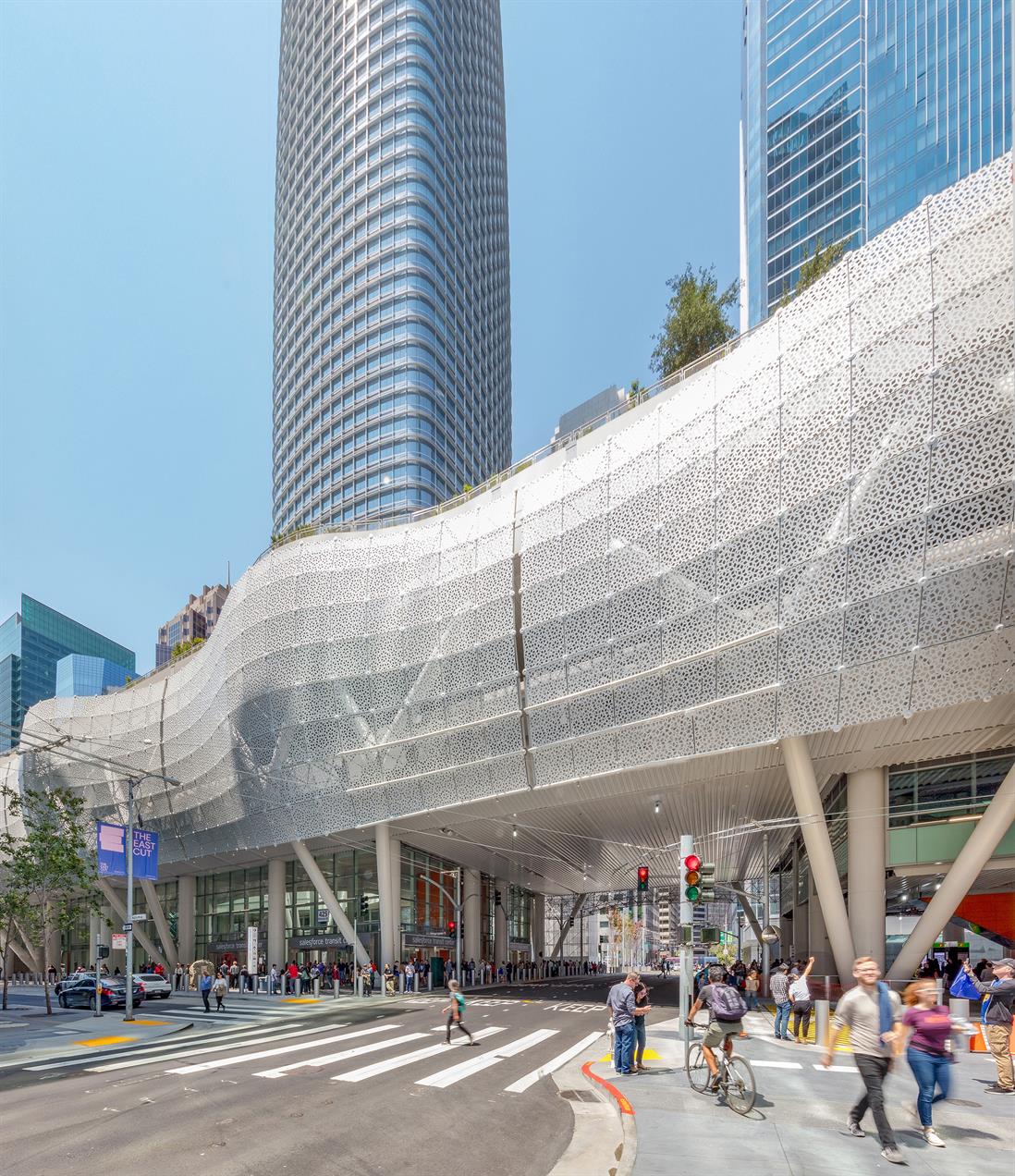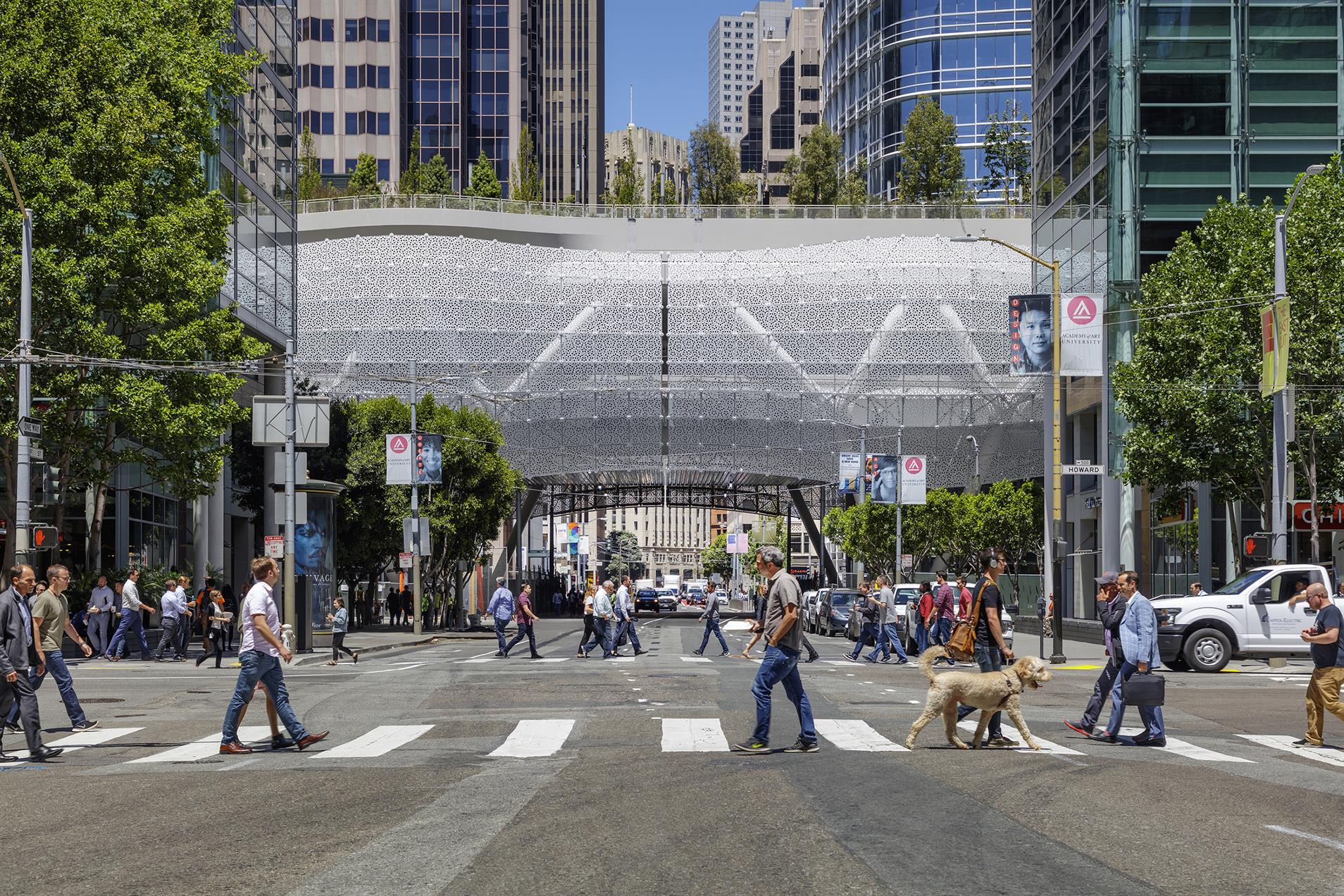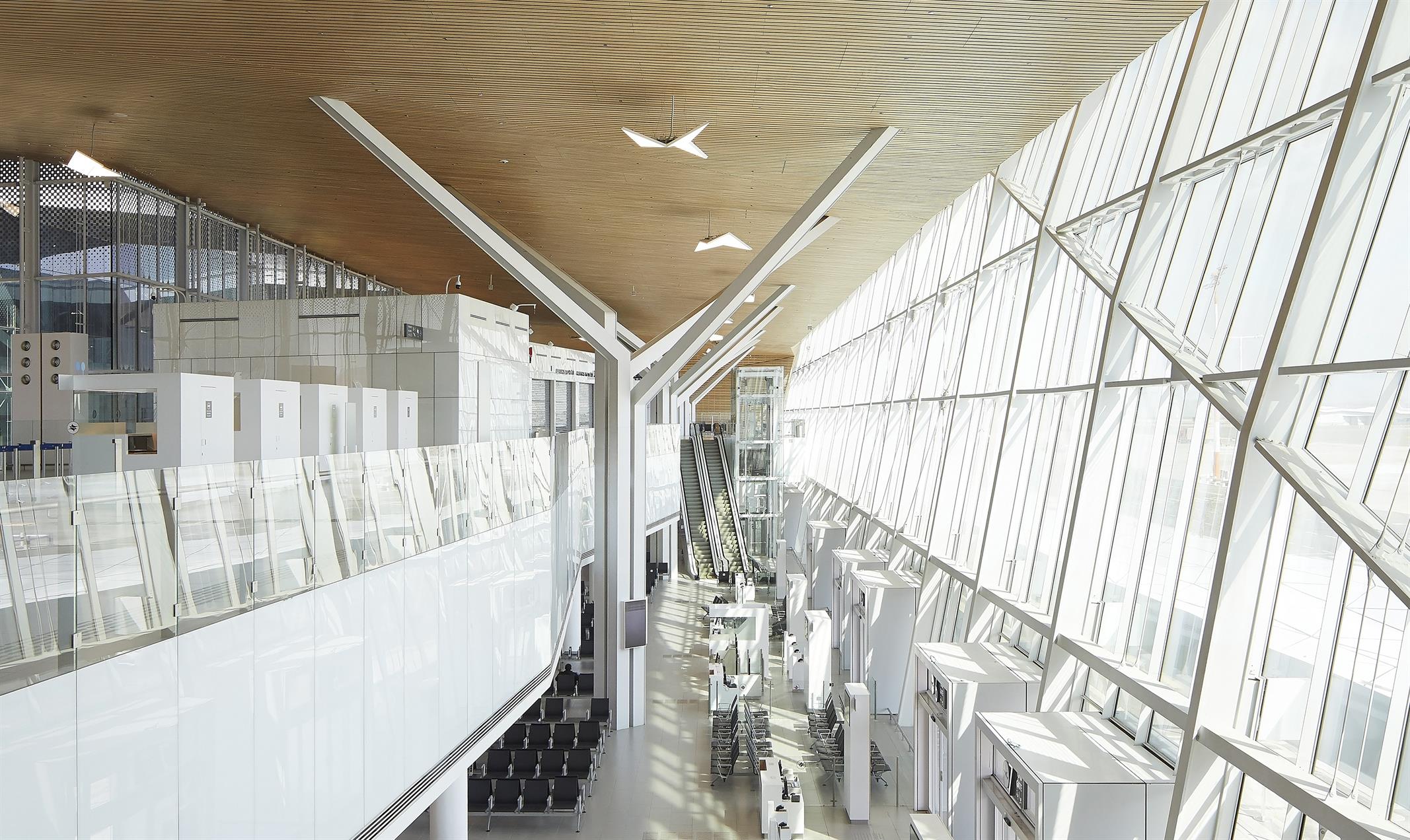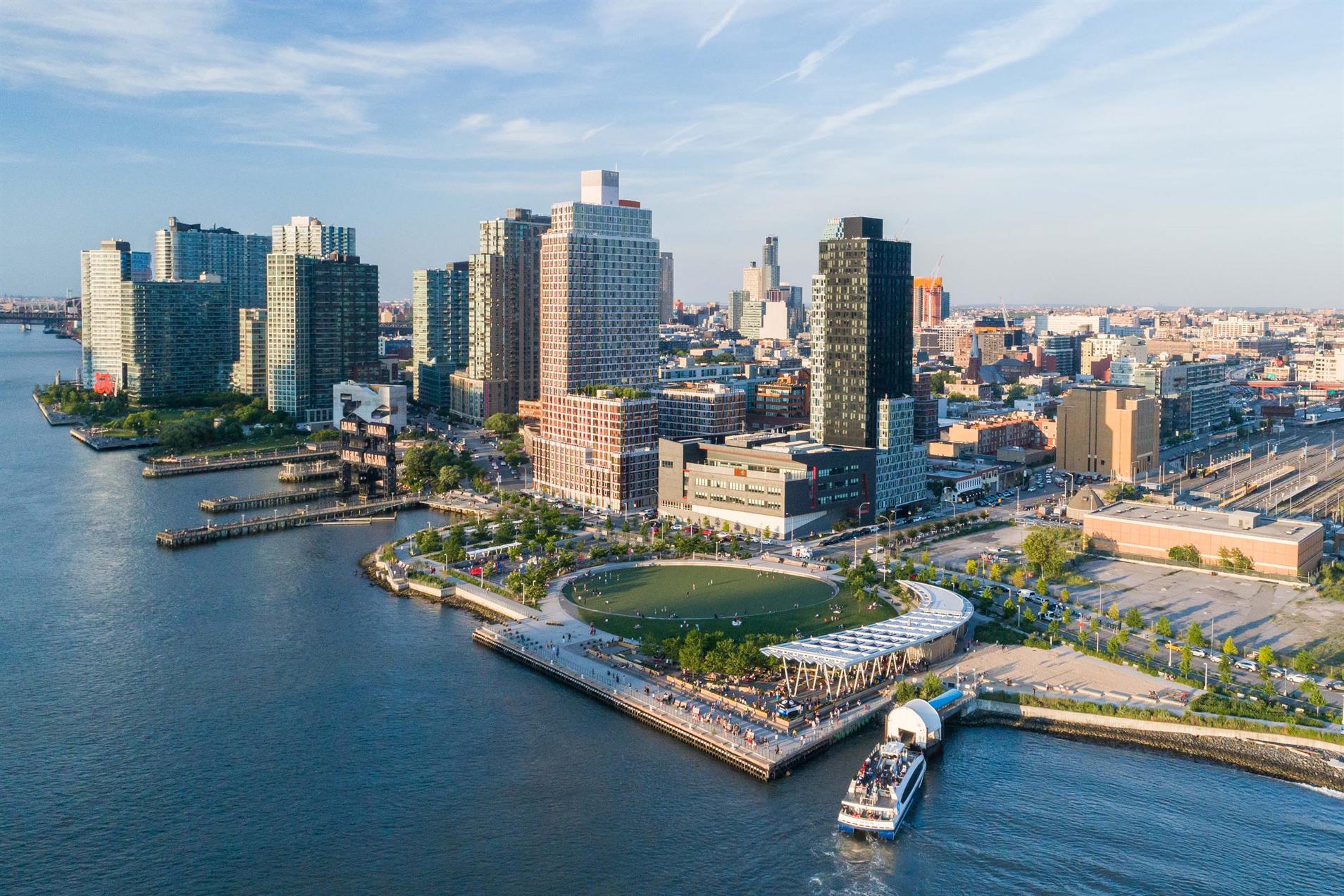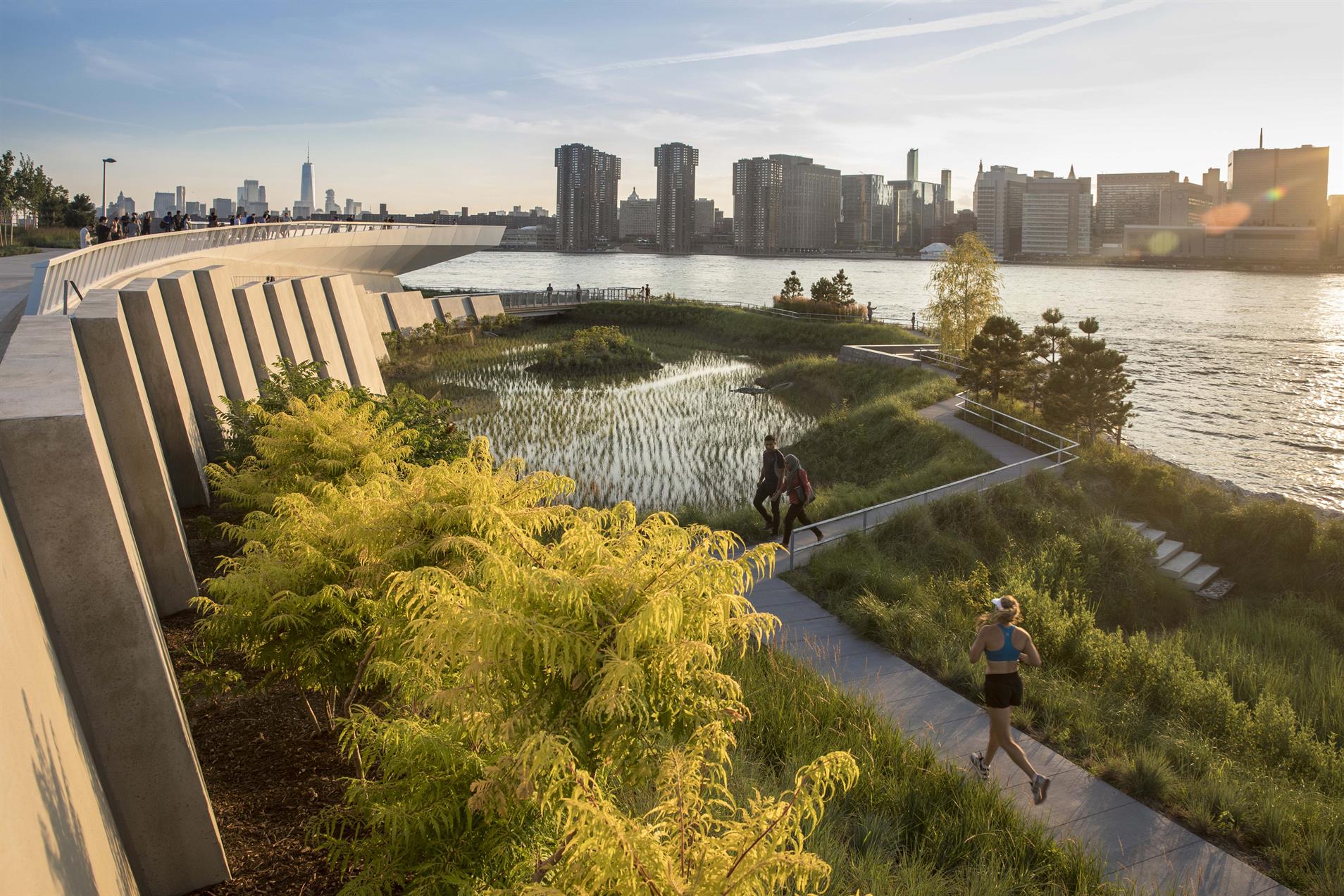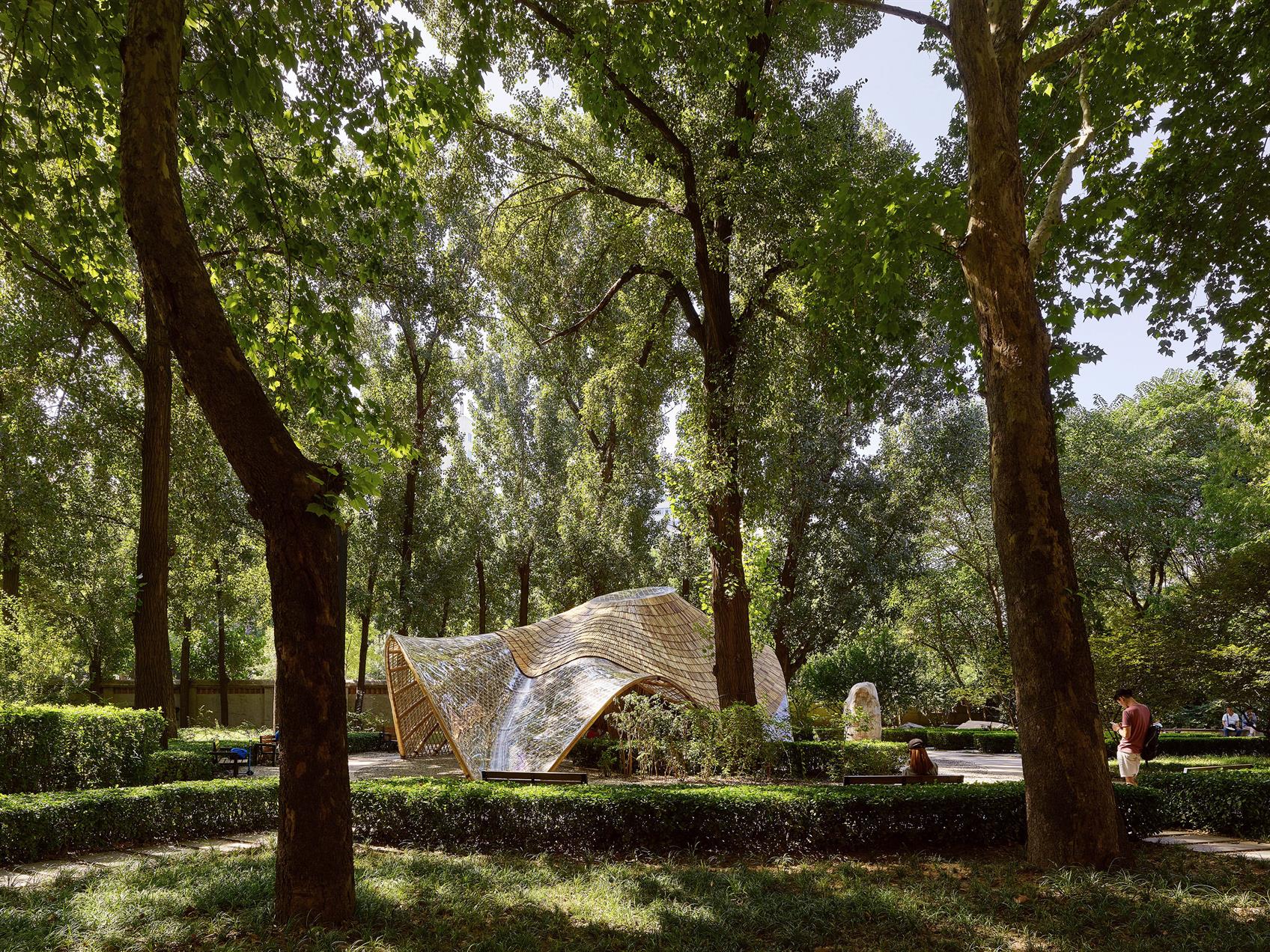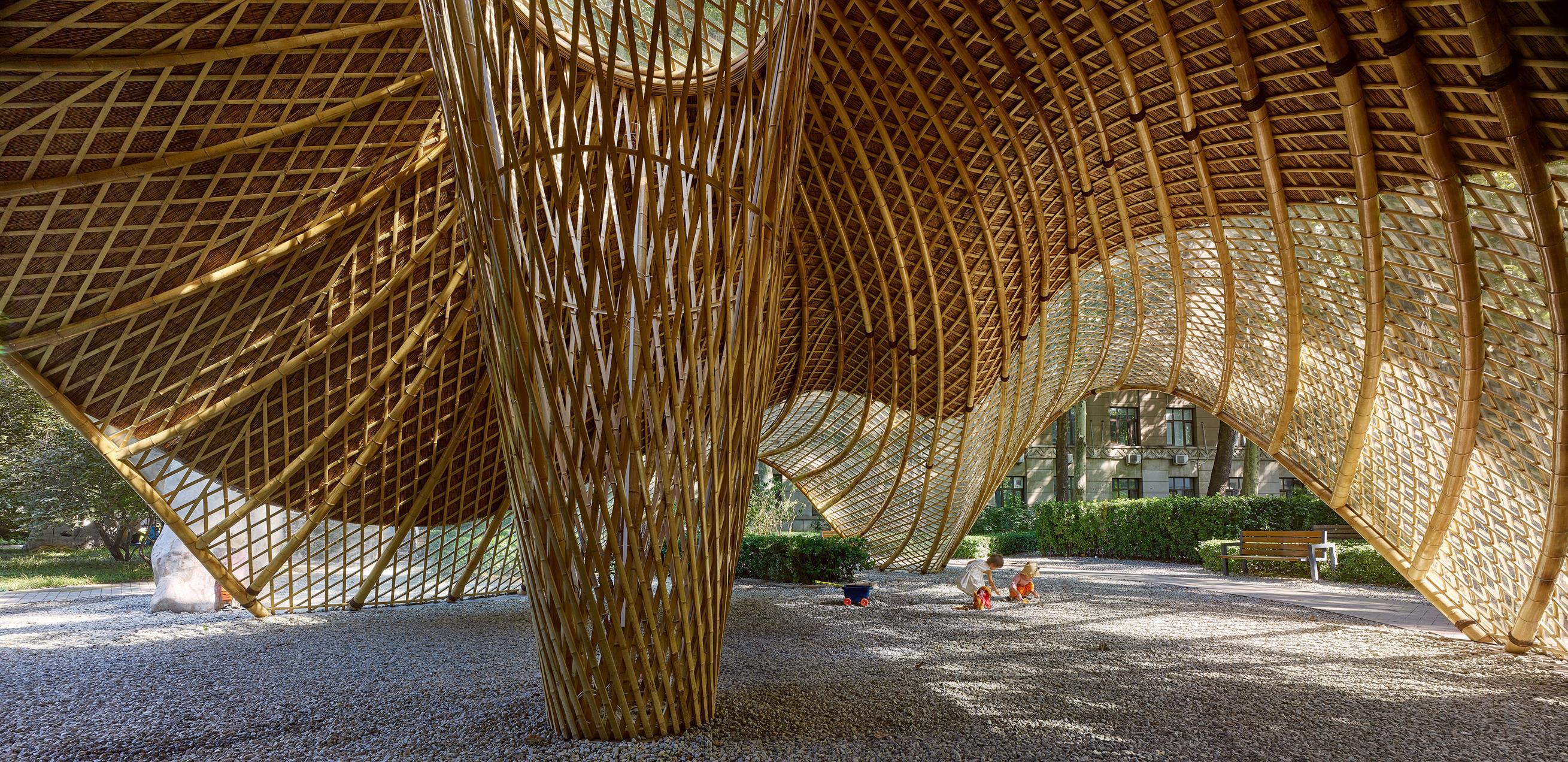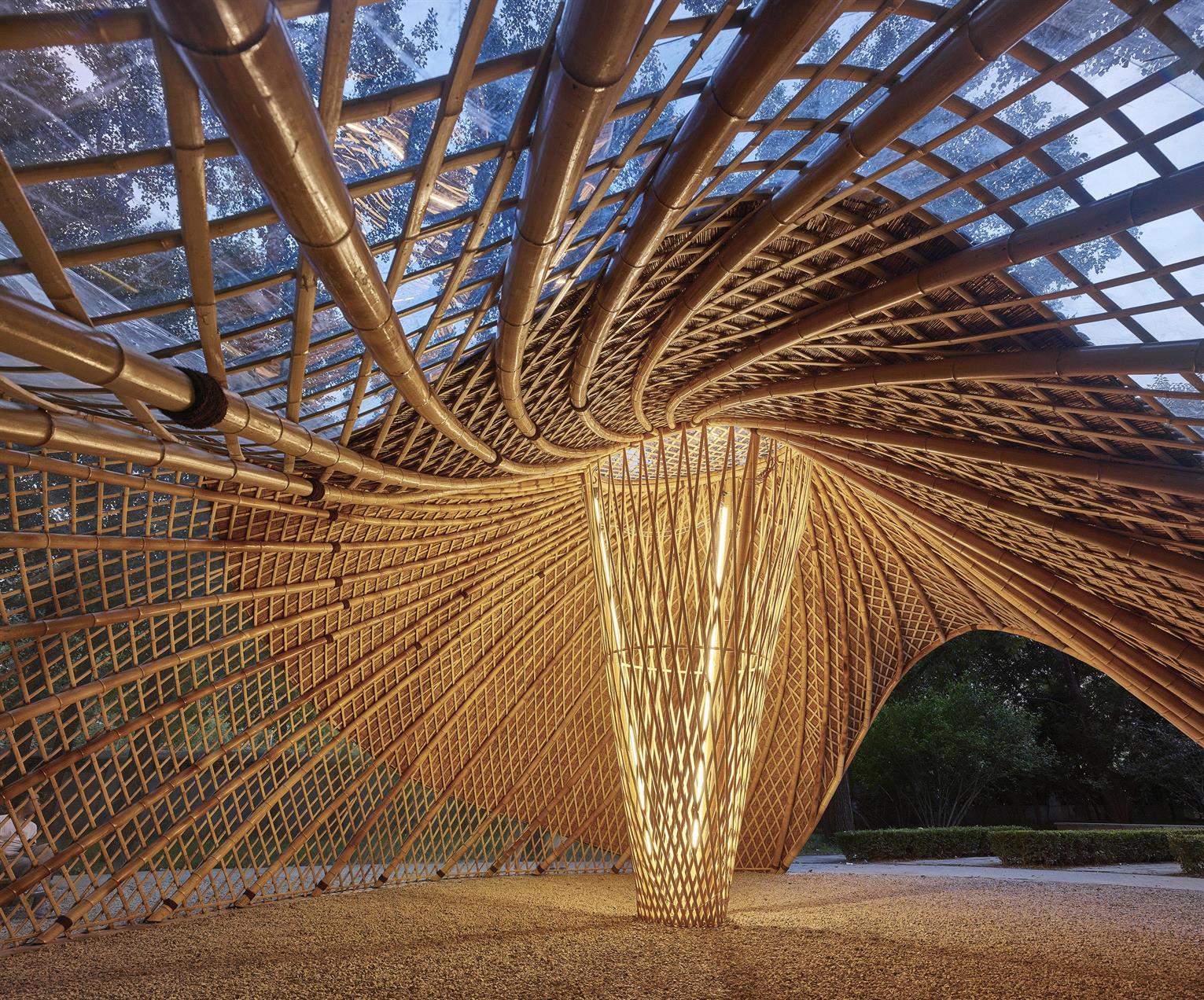Civic
Gold: Mario Cucinella Architects, ARPAE Headquarter for the Regional Agency for Prevention, Environment and Energy
ARPAE project is the result of an international design competition for a new building complex that hosts house offices and laboratories. It covers an area of 5,000sqm. The customer required a property to be allocated to its offices that would meet the highest standards of architectural and environmental quality, and was characterized by a maximum level of environmental sustainability.
The new building surrounds a central courtyard, that’s the hub of the complex. The roof of the building, the so-called fifth facade, is the strongest design feature of the project. A series of chimneys give the building a strong architectural identity while satisfying the technological requirements of the brief. The chimneys are skylights that filter natural light, promote natural ventilation and reduce the need for mechanical cooling.
Overall, the entire building works proactively with the local microclimate meeting the technological needs manifested in the briefing. All workspaces are open to the outside by the inclusion of green courtyards creating an alteration of solid- void – indoor‑outdoor micro‑environments that break up and define the building volumes.
Silver: Mozhao Architects, The planting terrace and the experience pavilion
The geographical advantage of Shajing had seen it flourished into a lower end manufacturing base for Shenzhen in the past three decades. The mass construction of industrial parks not only destroyed the scenery wetland and farmland, but also brought chaos to the nearby suburbs.
In recent years, many residential quarters and schools were built around the industrial parks, which stirred up the initial intentions of this project, to offer a vibrant public space for workers, residents, students and for the plant lovers, a green and cultural place to enjoy. Various experiential activities in the traditional planting culture of the Shajing has been passed down in a new form, this has also encouraged community building.In order to meet the demand for parking, and to improve the spatial quality of the courtyard, a large landscaped terrace was created. This space can also provide seating for spectators when outdoor activities are held. Concrete planting troughs are randomly placed on the terrace, so people can plant various crops and shrubs, depending on their individual preferences. In the northeast of the terrace, there is a planting pavilion made of exposed concrete, which brings plant lovers together to learn from one another. The first floor is a public space for exhibition, communication and lectures, while the second floor acts as a planting and training space for the plant lovers. Overhead staircases and floor slabs make the little building looks ingenious.
Bronze: Woods Bagot, Rockhampton Riverside Precinct
The Rockhampton Riverside Precinct was redeveloped to provide the people of Rockhampton with a world-class civic and recreation space that celebrates the city’s unique character. The long and linear site consists of nearly 19 hectares of parkland spanning from Fitzroy Bridge to the north and the new playground to the south.
The centrepiece of the precinct is the pier building and lift structure. The pier structure is centred on the site, with the lift structure located south of the pier and external grand staircase. The pier structure is tenanted by the Boathouse restaurant. The restaurant’s central location within the Riverside precinct provides a strong connection to the retail and business heart of the city.
The corten steel clad pier and lift structures both use a natural material palette of stone, timber and glass. The striking russet-toned exterior echoes the rich colours of the natural and farmed landscape and use of metal nods to the region’s mining history. The pier structure’s crisp, linear shape and industrial aesthetic is borrowed from the steel Fitzroy Bridge to the north.
Drawing a direct relationship with the ‘Queenslander’ housing typology of the city, the large overhanging roof provides refuge from the sun while the large wrap around balcony with floor to ceiling glass walls provides uninterrupted, sweeping views of the natural landscape, waterplay park and landscaped gardens.
The Rockhampton Riverside Precinct has revitalised the previously neglected riverside site and returned the city centre to its place as the vibrant and dynamic heart of the region.
Commercial (under 50,000sqm)
Gold: Ennead Architects, Apple Scottsdale Fashion Square
Located in a bustling shopping square in Scottsdale, Arizona, this transparent, human-scaled massing of retail space provides a welcoming contrast to the surrounding two-story volumes. The form of the building reduces the existing overall scale along North Scottsdale Road while also introducing a unique threshold experience into the mall.
The main design features of the store include a split-level store layout, a terraced public plaza, and a heroic cantilevered shade trellis. Unifying the building massing and providing for a unique architectural feature, the perforated horizontal trellis extends from the store’s interior to cover the exterior walk and southern public plaza. Furthermore, material consistency spanning between the interior and exterior of the design emphasizes the blurring of the boundary between the interior retail experience and exterior public outdoor spaces transcending the function of the space beyond its primary use.
Silver: Tzannes, International House Sydney
International House’ forms a new public place for Sydney, and a pivotal connection between the newly formed precinct of Barangaroo and the historic heart of Sydney central business district. The building manifestly demonstrates leadership in environmentally sustainable design and fosters good health and wellbeing for the office users of the building through the comprehensive and integral use of structural engineered mass timber construction throughout. The concept for the architecture is underpinned by place-making considerations, including: establishing a pedestrian orientated scale; reinforcement of the urban form of the street and pedestrian networks; the creation of special conditions at corners to enhance pedestrian experience; establishment of an understated aesthetic character as a memorable counterpoint to architecture in the precinct enhancing legibility; and a unique, desirable internal office experience. The feeling of natural warmth of timber has been proven to reduce stress and anxiety, and when coupled with improved indoor air quality and beautiful aesthetics delivers a healthy and satisfying working environment within International House Sydney through biophilic design, calling on our human innate connection with nature. Australian hardwood timber has been reclaimed from demolished wharfs and piers from the site and re-used for external cladding to the building, extending its lifecycle by another 100 years. Detailing throughout is direct and refined, with no superfluous items for decoration or unnecessary diversion.
Bronze: Henry J Lyons, One Molesworth Street
One Molesworth Street is a new mixed-use office and retail development located at the corner of Dawson Street and Molesworth Street in Dublin, Ireland. The building is six storeys high with a restaurant, café, retail unit and main office entrance located at ground floor level and office accommodation on the levels above. The form of the building has been carefully modulated to sit comfortably within the historic context while at the same time presenting a strong modern identity. The building is finished with a range of natural, durable materials which include Portland stone, bronze, travertine and onyx. The office spaces are designed for efficiency and flexibility with compact central cores and bright, open column-free floor-plates.
Commercial (over 50,000sqm)
Gold: Pelli Clarke Pelli Architects, Salesforce Tower
Salesforce Tower is the tallest building in San Francisco, joining the Golden Gate Bridge and the Transamerica Building as one of the skyline’s defining elements. Standing 326 meters tall, the tower has the simple, timeless form of the obelisk, giving the 61-story tower a slender, tapering silhouette. The walls are composed of clear glass with pearlescent metal accents. These horizontal and vertical accents gradually taper in depth to accentuate the curved glass corners. The walls rise past the top floor to form a transparent crown that appears to dissolve into the sky. Carved into the tower top is a vertical facet that is lit at night.
At its base, Salesforce Tower connects directly to the Salesforce Transit Center, which will house 11 Bay Area transit systems. On top of the transit center and linked directly to the tower is a 5.4-acre public park, which will offer recreational, educational, and nature activities. The park has two roles: the future anchor of the neighborhood and a key element of the project’s sustainable design strategy.
Certified LEED Platinum, each floor of the tower has integrated metal sunshades, calibrated to maximize light and views while reducing solar gain. High performance, low-emissivity glass also helps to reduce the building’s cooling load. Cooling is provided in part by heat-exchanging coils wrapped around the tower’s foundations. The tower also has the largest blackwater recycling system in a commercial high-rise in the United States. High efficiency air-handlers take in fresh air on every floor.
Silver: Haeahn Architecture, Inc + H Architecture, The Nexen Univer-City: New Nexen R&D Center
The building is a new research and development Center for Nexen, a leading tire company in South Korea, located at the western edge of Metropolitan Seoul that is currently under development as a hub of cutting-edge industries, hosting many research facilities for South Korea’s leading corporations. The building is equipped with a series of multidisciplinary research and development labs covering all aspects of the company’s technology. It also houses supporting offices, various types of meeting areas and welfare facilities for workers.
The design began with the goal of reinventing a new type of urban research facility suitable in a dense urban context. It proposes the building to be organized into four programmatic zones while maximizing connectivity and interactivity. All required spaces are shaped and enwreathed by a dual-helix form which integrates a roof garden and a courtyard together. It creates various communicative spaces for workers, and completes a unique prototype of an urban research facility with green spaces. The heart of the building is the courtyard, a sun-filled and fluid green, which provides outdoor areas for gathering, rest and events. The unique dual-helix form with the courtyard promotes use of outdoor space as a communicative space while it provides a more efficient and cooperative work experience. The building is also designed for responding to the environment to achieve maximum energy efficiency. The southern and eastern façades feature a shading-louver system, inspir
Bronze: Buro Ole Scheeren, DUO
The Duo towers are an act of urban reconciliation. Conceived to knit together a previously disparate part of the city, Duo integrates the surrounding context around a 24-hour accessible public plaza, forming a new civic nexus for Singapore.
Singapore consistently ranks as one of Asia’s most livable cities. However, it’s increasingly dominated by isolated towers that favor exclusion over social connectivity. Rather than functioning as a piece of individual and self-referential architecture, Duo is a sensitive insertion into Singapore’s urban fabric that unites a group of existing buildings through spatial integration and establishes a coherent overall urban figure. It repairs a broken piece of the city and celebrates public life as the central quality of a socially responsible urban environment.
The project comprises two expressive sculptural towers that have been dynamically carved to create a series of circular urban spaces – a kind of “urban poché” that co-opts adjacent buildings and symbiotically inscribes the two towers into their context. A series of vertical offsets and cantilevers further articulate the towers’ silhouette and generate a series of elevated public spaces.
Duo integrates living, working and retail with public gardens, cultural happenings, and a diverse urban context. While Duo’s two towers contain the main functional elements – one tower accommodates 660 residences and the other corporate offices and a five-star hotel operated by Andaz – the structures dematerialize as they reach the ground, opening out into a porous public landscape.
Education
Gold: Montgomery Sisam Architects + Feilden Clegg Bradley Studios, University of Toronto Myhal Centre for Engineering Innovation & Entrepreneurship
The Myhal Centre for Engineering Innovation and Entrepreneurship heralds a new era in engineering education, designed to break down barriers between disciplines, facilitate collaboration, encourage active learning, accelerate innovation, and develop entrepreneurial talent. The building includes a 468-seat lecture theatre, state-of-the-art collaborative classrooms, workshops, makerspaces and light fabrication facilities as well as several multidisciplinary research centres and institutes. It balances these 7,500sqm of net project-based program space with an additional 7,500sqm of shared social learning spaces. Program spaces are standardized and flexible to meet current learning needs and respond to changing technology and methods of teaching. Social spaces are designed to encourage informal and spontaneous interaction.
The elegance and simplicity of the design respond to the building’s privileged place on the main campus thoroughfare while respecting adjacencies to major heritage buildings, the integrity of the campus master plan, and the larger urban realm. The attention to detail, rich material quality, abundance of daylight, and curated views serve to enrich the experience of those within.
True to its pedagogical mission, the Myhal Centre advances and advocates for sustainable development in accordance with the triple bottom line. The building targets a useful service life of 100 years premised on the durability of materials and assemblies, the flexibility of structure and systems and a high performance, bioclimatic envelope that supports passive lighting and ventilation. It opens as the most energy efficient building on the St. George Campus and one of the three most energy-efficient academic buildings in Canada.
Silver: Architectural Design & Research Institute of Tsinghua University Co., Library Cluster Design for the New Campus of Yan’an University
In Yan'an, a famous historic city, it is indeed challenging to design the most important building complex for the new campus of a university with profound heritage. We have to ponder on how to include the past and turn to the future, incorporate regional features and reflect the spirit of the times.
Our design fully taps the cultural features of Yan'an and the humanistic intention of the university, and makes culture, building and landscape of the campus echo with the Loess Plateau features in Yan'an, presenting a warm and unadorned campus with strong cultural presence. By such design, we distinguish the campus from the remaining stereotyped new campuses in current Chinese universities.
Following the student-centered idea, we designed public squares, courtyards, corridors and platforms as the public space to serve teachers and students. So we make the space more accessible to facilitate communication.
After an in-depth study of local architecture, we interpret set-back, cave, cross-shaped brick hole and loess color, the most representative elements, with contemporary language. We also improve local building materials and techniques with modern means and employ local craftsmen to exhibit the primitive aesthetics of local building.
The new campus design would jump out from the design paradigm of its kind to explore a campus with regional characteristics, cultural atmosphere and spirit of the times, which specifically is to tally with the unique historical, cultural and regional context of Yan'an University, accommodate future development of the university, promote exchanges between teachers and students, and spark innovation.
Bronze: Architectural Design Institute of South China University of Technology Co., Raleigh Campsite in Guizhou
Raleigh campsite is residing in a mountain village of the ethnic minority group of 'Buyi and ’Miao', a non-profit youth development campsite combining with rural community center. The design implements a symbiosis concept in its intervention with the site and employs lightweight assembly and local craft in construction. Mountain landscape, rural custom and youth-growth experience are bridged to provide an interactive place for both urban and rural children to grow in natural experience and public service practice. The project attracted donation by design proposal and was built by Raleigh companions and local craftsmen in cooperation.
The site is an abandoned primary school. Taking the renovated teaching building as the anchor, the multifunctional lodge, service facilities and a variety of outdoor venues are extended. A village library opened to local community is set up on the junction of the campsite entrance and the village road. The multifunctional lodge (integrating training, leisure, camping and dining functions) topped with undulating membrane, provides a continuous sharing space with a good view and ventilation. A series of open space facing the mountain and village are defined by translucent bamboo interface. The renovated school building is used as a headquarter, volunteer dormitory, medical room, material warehouse and overlooking platform. The kitchen, washroom and library are built with bamboo-mold concrete and local masonry craft whose volumes are carefully defined to structure dynamic connection with the lodge and border.
The village library’s wooden reading-room becomes the favorite place for children to read, play and seek help for their homework.
Healthcare
Gold: Architectus, Royal Far West Centre for Country Kids
The Royal Far West (RFW) Centre for Country Kids is a compact six-storey building located in Manly, near Sydney Harbour. The Centre provides a fully integrated model of healthcare for over 8,000 children and families from rural and remote areas of New South Wales, Australia, a legacy that has been undertaken on this significant and iconic site for over 90 years.
Through a combined urban design, architectural and landscape design response, the new centre supports RFW’s unified model of health, education and disability services, caringly blurring the line between learning and consultation. Creating a light-filled and engaging place with active spaces, passive spaces and smaller consultation spaces, the centre is the physical embodiment of care for country kids.
Beneath a landscape-screened façade, the centre entrance leads visitors into the reception area, glimpses to the first level and courtyard to the adjoining Drummond House reveal the building’s function and provide clear legibility for clients, parents, visitors and clinical staff. Oral health, meeting and administration are located on the ground floor, large flexible areas adjacent to the courtyard provide opportunities for recreation and public interface. A large stair and void links the first three levels. Levels 1 and 2 consist of group therapy rooms, recreational room, operable walls for flexibility and observation, and consulting rooms. Level 3 locates learning spaces to the south with a terrace to the north doubling as recreational space for primary-aged children. Levels 4 and 5 are designated for management, administration and tele-health services.
Silver: SAA Architects, St Joseph's Home
St Joseph’s Home is a 412-bed nursing home located at Jurong West Street 24. For almost 40 years, the Catholic Welfare Services has been caring for our elderly and staying true to their philosophy of regarding every resident as a person, not a patient.
The design embodies the philosophy of the Catholic Welfare Services in providing ‘A Person-Centred Home which Values Human Dignity’. In designing for this philosophy, three design responses were identified, designing for community, mobility and dignity.
Each aspect of the design of St Joseph’s Home places residents’ wellbeing at heart, providing for their movement, engagement, and comfort levels; enhancing the total quality of care that the sisters and staff.
Bronze: Perkins and Will, UC Gardner Neuroscience Institute
With the need to consolidate and expand neuroscience services and improve the patient experience, UC Health embarked on providing a state-of-the-art outpatient facility that provides innovative care to neurological patients.
The facility’s exterior is made of a specialized polyester fiber mesh that controls light and heat, and prevents glare while allowing natural light to enter the interior. This is critical for many neurological patients, as glare can be visually disorienting. Wrapping the east, west, and south sides of the building, the angular, pleated, polyester planes, which are 10ft wide and three stories tall, suggest origami, and make the building stand out on a campus known for classical and modern architecture.
The Gardner Neuroscience Institute, a 113,000 sq ft facility, brings together 125 faculty from 15 centers of excellence into a new home for neurological care, education, and research for complex neurological conditions. As a patient centered facility, each component of the design was developed with patient, family, and caregiver input. The team also drew on input from a ‘neuro-architect’ who studies and practices both architecture and clinical neuroscience, which influences how specific design elements can help improve the patient experience. The design accommodates the needs of patients with susceptibility to nausea, dizziness, fatigue, or movement disorders and responds to those needs along every step of the patient’s journey.
The building includes 172 interior parking spaces on two partially below grade flat levels, allowing patients to park in the building and go directly from parking to their appointments on any floor.
Leisure
Gold: gh3 Architecture, Borden Park Natural Swimming Pool
The Borden Park Natural Swimming Pool is the first chemical-free public outdoor pool to be built in Canada. The project replaced an existing pool, and includes a seasonal pavilion and landscaped pool precinct for 400 swimmers.
The challenge was to create a large-scale pool with high-quality water control while also achieving an environmentally healthy and natural filtration process. The design process began with developing a pool technology that cleanses the water through stone, gravel, sand, and botanic filtering processes. This inspired a materials-oriented concept for the change room facility to achieve a technically rigorous and aesthetically integrated design whose gabion basket stone walls visually evokes the idea of filtration.
The pool involves a balanced ecosystem where plant materials, microorganisms, and nutrients come together within a gravel and sand filtering process to create “living water”. Filtration is achieved in two ways: through a biological-mechanical system or the constructed wetland and gravel filter, and in situ, with Zooplankton.
The seasonal building houses universal change rooms, showers, wash- rooms, staff areas and the water filtration mechanisms. The swimming program includes a children’s pool, a deep pool, on-deck outdoor showers, a sandy beach, picnic areas, and spaces for other pool related recreational activities.
The project’s materiality creates a fundamental conceptual connection between the technical demands of the pool and the design of the built enclosure and landscape elements. The elemental form and reductive materials ease the user experience and enriches the narrative of bathing in the landscape.
Silver: EFFEKT Architects, GAME Streetmekka Viborg
Streetmekka is a renovation project that transformed an abandoned windmill factory into a vibrant hub for street sports and street culture, offering various facilities for self-organized sports and social spaces for the local youth of Viborg, Denmark. Situated in the outskirts, the old industrial building was vacant and abandoned.
Instead of demolishing, the focus was on how to take this introverted typology and give it a new life with a very limited budget?
Despite the generic appearance, these typologies often contain an impressive interior space and the idea was to expose it.
By removing the walls at both ends of the building and placing all the office and workshop spaces on one side and skating on the other, the interiors are kept as free as possible.
The existing concrete facade is wrapped in a new translucent polycarbonate skin that gives the appearance of a light and welcoming building, dynamically changing from day to night.
Last, the building is filled with functions aimed to meet the increasing demand for self-organized alternatives to the established sports and cultural activities, supporting the client mission to attract local youth and create lasting social change through sports and culture, enabling integration and empowerment.
The program includes facilities for parkour, skate, bouldering, basketball, trial as well as a series of workshop areas for music production, DJ’ing, an animation studio, fab lab, various artist studios and wood and metal workshops.
Social spaces are distributed throughout the building and strategically interwoven in-between primary functions to foster participation.
Bronze: Populous, Tottenham Hotspur Stadium
Tottenham Hotspur Stadium heralds a new era for stadium design, delivering an unrivalled fan experience and significant community benefits, creating a world-class sports and entertainment destination for all.
With a fully retractable pitch, the 62,062-seat stadium becomes a custom-designed home for NFL in the UK complete with bespoke locker rooms and media centre.
Fan spaces across every level at the stadium deliver incomparable levels of quality and choice, while a new visitors centre drives year-round community engagement.
The stadium is part of a major area-wide development scheme led by Tottenham Hotspur. Once complete, it will support 3,500 jobs and includes 222 affordable homes and a primary school.
Mixed Use
Gold: Brisac Gonzales, Lot O4 - Batignolles
Situated in central Paris in the 17th district, the site is part of a new neighbourhood built over a former rail yard and around a new park. The site itself stretches between the park and an artificial street, and consists of 144 social housing units, a 15-classroom primary school and a regional level sports centre.
We took on the challenge of ensuring that the density would not be felt, either at the city level, or by its users, by creating a sense of lightness and openness.
The project stands as a moment of respite within its busy surroundings, extending the presence of the park to the city. This is achieved by stacking the three components of the brief, and splitting the towering volumes, creating a defined yet open corner; one that allows light to flood into the block. The result is an elevated quality of living spaces, basking in the sunlight, with balconies wrapped around all sides
The exterior of the building is a modern variation on a typical Hausmanian façade. Materials are woven into a landscape of diamond-shaped patterns, a unifying and identifiable motif featured in the handrails, wall cladding, and brickwork.
The sports centre emerges on both the street and park sides, to capture light through clerestory windows. Inside, the interior glass partitions transform the circulation spaces from what could have been an underground bunker into cathedral-like spaces. Light is guided across the various rooms, piercing through hallways and shimmering along surfaces, creating a sense of brightness and airiness.
Silver: David Chipperfield Architects, Berlin Amorepacific Headquarters
The new headquarters for Amorepacific, Korea’s largest beauty company, is located in the centre of Seoul at a site which has been occupied by the company since 1956. It is situated next to a former US military zone that is being transformed into the spacious Yongsan Park and a business district, which was part of a masterplan representing the largest high-rise development in Korea that substantially altered the urban fabric of the district.
The form of the building is both abstract and gestural. Focusing on a single, clear volume, the proportions of the building have been carefully developed around a central courtyard to maximise the effectiveness of natural ventilation and daylight. Three large openings connect this central void with the exterior surroundings, providing both dramatic views over the city and the mountains in the distance. As ‘hanging gardens’, these openings allow nature to extend from the adjacent park into all parts of the building.
The design elaborates the social, cultural and professional ambitions of the company by combining the workplace with other communal activities. The building offers itself to the city by being elevated above its public entrance platform, creating a generous, public atrium entrance hall. The courtyard situated above represents the communal centre of the company workplace. A rich mixture of public amenities such as a museum, auditorium, library, restaurants and childcare facilities ensures that the building is not only an efficient headquarters but also the public face of a vital company embedded in the growing metropolis of Seoul.
Bronze: Serie + Multiply Architects, Oasis Terraces
Oasis Terraces stands to reinvent what a community centre is in a high-density city. Providing the primary public amenities for residents in the Punggol neighbourhood of Singapore, the 27,000sqm centre contains health, retail and communal facilities. An expansive sloping green space defines the scheme, allowing views, light and air to penetrate the building. Landscape acts as a connective element in which garden elements successively frame community space.
The design utilises a series of lush garden terraces that slope towards the waterway as one of the key elements to generate communal activities. These lush gardens act as communal spaces, children’s playgrounds and a natural amphitheatre. The roof is also heavily landscaped and features planting beds for urban farming. By bringing residents together to plant, maintain and enjoy them, the gardens help nourish community bonds.
A large sheltered plaza fronting the waterways creates the vibrant heart for the community. This plaza is used for a wide range of communal activities and events and sits at the crossing point of the east-west and north-south thoroughfares of the site. All circulation through the site and from the adjacent Oasis LRT station culminates at the plaza.
The design is informed by the open frames commonly found in the facades and corridors of HDB's housing blocks of the 1970s and 1980s but transformed into a light and open frame that captures and accommodates diverse programmes for the community in a landscape setting it is an architectural framework for communal life to unfold.
Residential
Gold: WilkinsonEyre, Dyson Institute of Engineering and Technology
While there have been decades of discussion in the housing industry about modern methods of construction, there are few actual examples of turning visions into reality. However, this pioneering project demonstrates the potential of a new approach to speed up housing delivery.
Students at the Dyson Institute of Engineering and Technology campus, are housed in a groundbreaking new undergraduate village of timber modular-housing pods, with communal facilities and a central social and learning hub.
This project is outstanding in many ways, in terms of the pod design and construction, the landscaped setting and the inclusion of a circular pavilion, called The Roundhouse, for social and educational events.
The high-quality, 8m x 4m pods were fabricated from cross-laminated timber (CLT) in a factory for rapid on-site assembly. Each pod has open-plan accommodation comprising an entrance zone with an adjacent shower and toilet, a central bedroom area and a work/living space. They have been arranged in units, two- to three-storeys high, to create a welcoming social space and an appealing addition to the campus. The pods are designed to harness CLT’s thermal massing, and provide high quality and energy-efficient living spaces. With wellbeing as a prime design consideration, each pod has natural ventilation and large, triple-glazed windows providing light and views.
The Roundhouse is conceived as a freestanding, transparent and outward-facing circular pavilion. The lightweight steel structure is formed of two stacked cylinders, surmounted by an oversailing brise soleil roof. Its facilities include a café, bar, lecture hall and study space.
Silver: ODA New York, Denizen Bushwick Phase 1
Situated on the former site of Brooklyn’s Rheingold Brewery the project will generate 1,000,000 sq ft of apartment units in Bushwick, 20% of which will be affordable. The project will host a multitude of communal spaces open to the neighborhood, while a 17,850 sq ft public park will bisect the development creating a green promenade and two 400ft by 200ft blocks. These masses are further perforated by a sequence of meandering, interconnected courtyards which ultimately lead to the promenade. Over the pair of these NY city blocks, ODA’s superimposed the layout of woven streets in a typical old town core.
Within the courtyard areas, lushly landscaped and partially covered walkways and corridors will give way to a parade of plazas, and accessible amenities designed to continue to promote a sense of community in this increasingly vibrant area. Complementing the structure and efficiency of a more typical grid, the layout will encourage both leisure and discovery, the guiding principles of the design. To support the vibrant local art scene, ODA will collaborate with local artists to commission all of the art in the complex.
The Rheingold Brewery site aims to become an integral part of the neighborhood by creating a highly porous architecture where the community can find a platform for activity and interaction. With ODA’s implementation of meandering, interconnected courtyards, a bisecting green promenade, and communal activities, 123 Melrose will be a veritable city within the city.
Bronze: DAGA Architects, Grinding Factory 5Lmeet
The project is located in the Hutong of the Beijing West Grinding Factory, a small courtyard originally known as Ruihua Dyestuff. This project is designed to transform the historic traditional courtyard into an attractive long-term rental apartment in Beijing.The apartment is connected by three yards, with the entrance made of an arched wooden gate leading into the courtyard, which is divided into the front reception area on the left and the central kitchen on the right. The kitchen faces the ancient trees in the courtyard. These ancient trees are deliberately kept out of the plane layout in order to keep them intact in the courtyard, and the kitchen is separated from the courtyard with the curved glass curtain wall. The dining room is a flexible space that can be used either as the dining area of the apartment’s residents or a public place for gatherings. There are five or six guest rooms divided based on the original architectural structure of the building. The transparency of the glass means that it will neither block the much-desired sunshine nor impair the original look of the building, creating a visually and spatially balance in relation to the old building. Therefore, the extended part of the whole yard is built in the form of a glass box. With light fluttering through and light and people moving around in it, the entire space is full of vitality. When sunlight pours through the transparent glass into the apartment, it brings warmth and energy in the apartment.
Transport
Gold: Landolt + Brown, Hackney Wick Train Station
Landolt + Brown were appointed by Network Rail and the LLDC to develop a new station and pedestrian connection beneath the railway at Hackney Wick.
The architects worked in collaboration with artist Wendy Hardie, developing a creative approach which explores overlapping themes drawn from the Lee River and Hackney Wick’s lost chemical industries. It embraces the massive concrete structures required to form the underpass and retaining walls, exploiting their weighty character to reflect the silty waters of the Lee.
The project incorporates a 2,000 tonne concrete portal which was lifted in place over Easter 2017 to form the underpass, connected by a pair of louvre-enclosed stair towers to the station platforms above. The new entrance is set beneath a weathering steel canopy and addresses a new public space on White Hart Lane. In the long-term a new connection will also be formed to the north. The underpass is divided by a wall of extruded glass hexagons which separate station circulation from the new public connection. The crystalline form of this wall reflects shards of daylight deep into the subway, evoking memories of the watery spaces under the Lee Navigation bridges.
Surfaces change from saw-tooth profile, drawing on the canal’s sheet piled edges, to board-cast concrete which echoes the bark of willows alongside the Lee. Cement mixes and terrazzo were hand-selected to reflect the gravel paths and concrete planks of the local towpaths and a frieze cast into the underpass wall abstracts chemical symbols taken from the Wick’s lost chemical industries.
Silver: Pelli Clarke Pelli Architects, Salesforce Transit Center
Salesforce Transit Center is a state-of-the-art transit station in San Francisco, linking 11 transit systems and connecting the city to the region, state, and nation. The innovative, sustainable design includes a 2.2-hectare (5.4-acre) rooftop park that anchors a new mixed-use neighborhood. In the spirit of New York’s Grand Central Terminal and London’s Victoria Station, the Transit Center’s soaring light-filled spaces give San Francisco a grand entrance that befits its status as a world-class city.
Salesforce Transit Center stretches four blocks along Mission Street, one block south of the Financial District. A gently undulating wall, inspired by the “Penrose Tiling” of famed mathematical physicist Sir Roger Penrose, floats above the street on angled steel columns, and is visible from afar, creating a graceful, luminous, and welcoming image. At street level, shops and cafes draw visitors and energize the surrounding neighborhood. Above, trees and flowers of the rooftop park invite people to visit for longer periods, transforming the area from a commuter hub to an urban destination.
The heart of the transit center is Salesforce Park, the rooftop park. Dense with nature and activities, it has 10 entry points, including bridges to surrounding buildings. Woven into the landscape are cafes, a 1,000-person amphitheater, children’s playground, Bay Area ecologies, and quiet areas for reading, picnicking or simply taking a break. The park’s annual energy consumption is 50% percent lower than the 2008 Title 24 Energy Efficiency Standards, and it is on track to receive a Gold certification under the LEED 2009 rating system.
Bronze: Amir Mann, Moshe Zur, Ami Shinar, Orna Zur Architects, Ilan and Asaf Ramon International Airport
The Ilan and Asaf Ramon International Airport, servicing the Red Sea resort city of Eilat and the surrounding region, is Israel’s first "greenfield”, built from scratch without existing infrastructures in the midst of the desert. The airport features a 45,000sqm passenger terminal building, a 3,600m long runway and taxiway, alongside 40 aprons, allowing for domestic and international traffic. The two support structures to the north and south of the terminal measure a combined 36,210sqm with a 45m high air-control tower.
A futuristic desert mirage: We developed a unique and minimal design language influenced by the futuristic world of aviation and its seemingly timeless natural desert surroundings. The decision of the IAA to appoint us, the architects, as design managers responsible for budget, program and planning schedule, allowed us to implement the design across the entire airport, from the various buildings to each individual check-in counter, unifying the airport under one unique holistic design, while maintaining the existing natural surroundings.
The terminal building is a self-shading volume, shaped by the movements of incoming and outgoing traffic, similar to the desert boulder shaped by the forces of nature. Its exterior cladding is continuous, from wall to roof, creating a unified whole, which is cut into by glass facades allowing for entrances and landscaped courtyards. These divide the building into airside and landside, departures and arrivals, all encased under one singular and continuous wooden cladded interior space.
Civic
Gold: SWA/Balsley and Weiss/Manfredi, Hunter's Point South Waterfront Park
An international model of urban ecology and a laboratory for innovative sustainable thinking, Hunter’s Point South Waterfront Park is an 11-acre public destination that initiated one of New York’s most ambitious, complex developments in decades, which also includes 5,000 units of affordable housing, two schools, and an expanded ferry stop. Surrounded by water on three sides, the design incorporates numerous green initiatives, transforming an underutilized site characterized by long-term disinvestment into a new urban ecological paradigm. The site is both waterfront and city, gateway and sanctuary, blank slate, and pentimento. Two hundred years ago, the area was a series of wetlands. The site’s more recent industrial identity reflects its strategic proximity to waterfront and rail exchange, all signs of its ecologically rich history were eliminated after decades of industrialization and subsequent abandonment. Today, the park design leverages its layered histories and spectacular views to establish a resilient, multi-layered recreational and cultural destination. Sited adjacent to a new school, public library, and an emerging residential development of 5,000 permanently affordable units, the park serves a rapidly-growing community as both a cultural destination and a protective force during times of flooding and extreme weather events.
Silver: LandLAB, Vaughans Stream Corridor Wetlands + Bridge
The Vaughan’s Stream Reserve is a new 20ha infrastructural park that provides the signature landscape experiences for a 162ha site that encompasses a new town centre, 2,500 houses and 28ha of parks. LandLAB were commissioned by Todd Properties Limited in 2014 to design a series of wetlands, associated open spaces and bridge structures.
The scope includes the design of three wetland areas forming part of an integrated low impact design network and storm-water treatment system for the wider development, a road bridge on the sites main north-south spine connecting the two sides of the stream and a series of secondary pedestrian bridges providing pedestrian connectivity between the stream corridor, neighbourhood and adjacent Long Bay Regional Park.
The design strategy stitches together the ecological restoration of an existing stream corridor with new stormwater and social infrastructure programs into a contemporary coastal parkland network. The organisational strategy introduces a family of design elements - boardwalks, bridges and pavilions, which facilitates circulation, navigation and occupation. A fundamental principle underlying all decisions was to build a new urban environment that struck the right balance between an efficient use of land, whilst maintaining and enhancing the natural environment.
Bridge and structures are articulated as a recessive yet sculptural family of steel elements set within the rejuvenated ecological network of the park. Theses features reveal and support wayfinding and connectivity of the park network and articulate an episodic experience for the park system.
Bronze: SUP Atelier, Swirling Cloud:Bulletin Pavilion for BJFU Garden Festiva
Inspired by this famous verse in an ancient Chinese poem, “a gale has risen and is sweeping the clouds across the sky”, the design team has presented a “pavilion of swirling clouds” for the garden festival of BJFU.
Covering an area of 120sqm, the pavilion will serve as a hub for information during the festival, and turn into a place for recreation and gathering after the event.
The design approach has taken full advantage of bamboo’s features, especially its malleability and bending resistance. The positions of curved openings on the pavilion were determined by the flow of people and the distribution of trees, bushes and stones on the site, so that people can easily walk across the square through the pavilion.
The pavilion stretches over the bushes in a light and graceful way. The top of the pavilion narrowed into a round skylight, merging the building with wind, sunlight and green plants, while presenting an image of swirling clouds.
With the help of the long-standing processing techniques of natural bamboo, the size, shape, structural from and details were confirmed through close collaboration by the architects, structural engineers and bamboo contractors. Modern building techniques, digital design technology and bamboo construction were integrated through pre-fabrication.
Through close collaboration, the architects and the bamboo contractors have discovered a practical prototype that can adapt to various site conditions and functions thanks to the great flexibility of bamboo design.




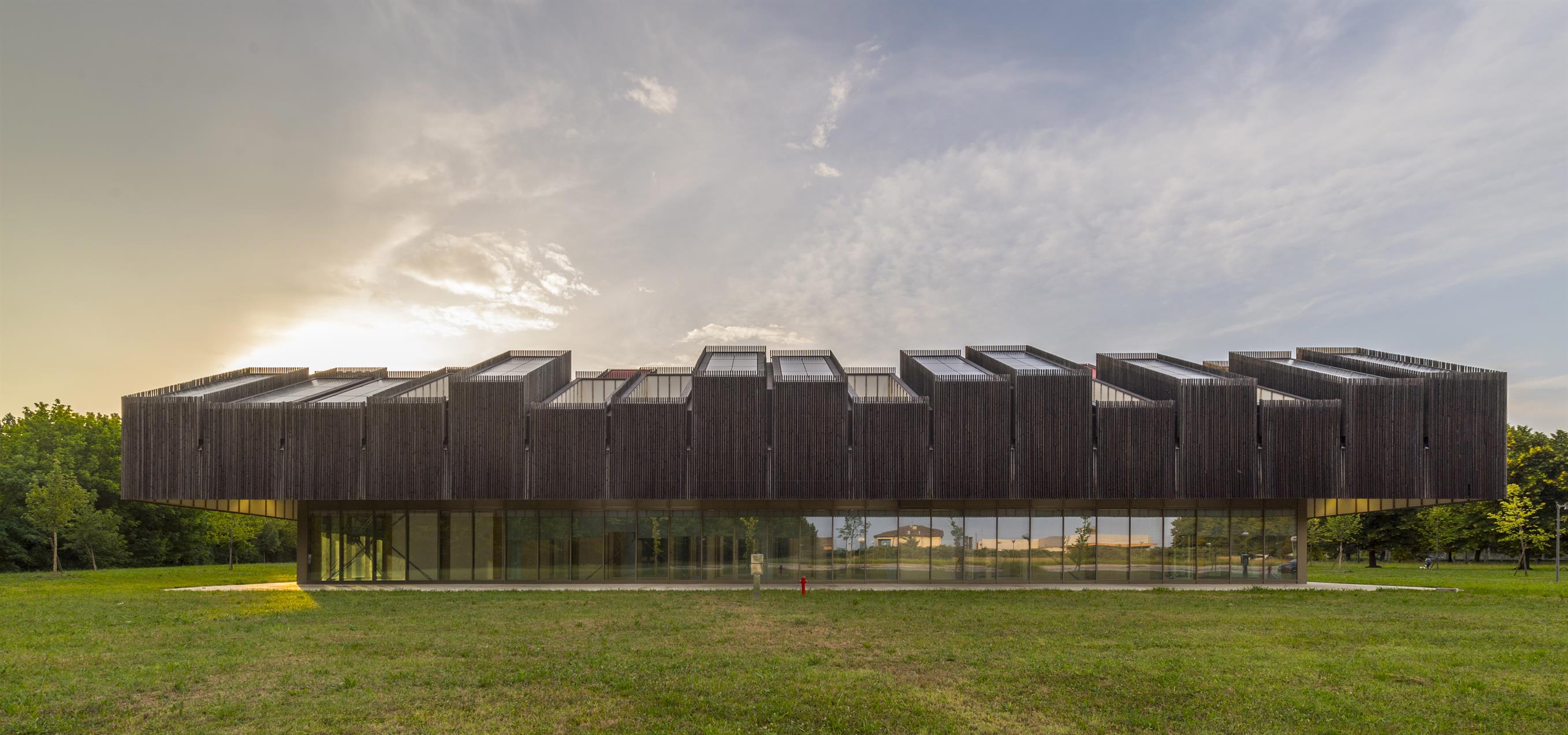

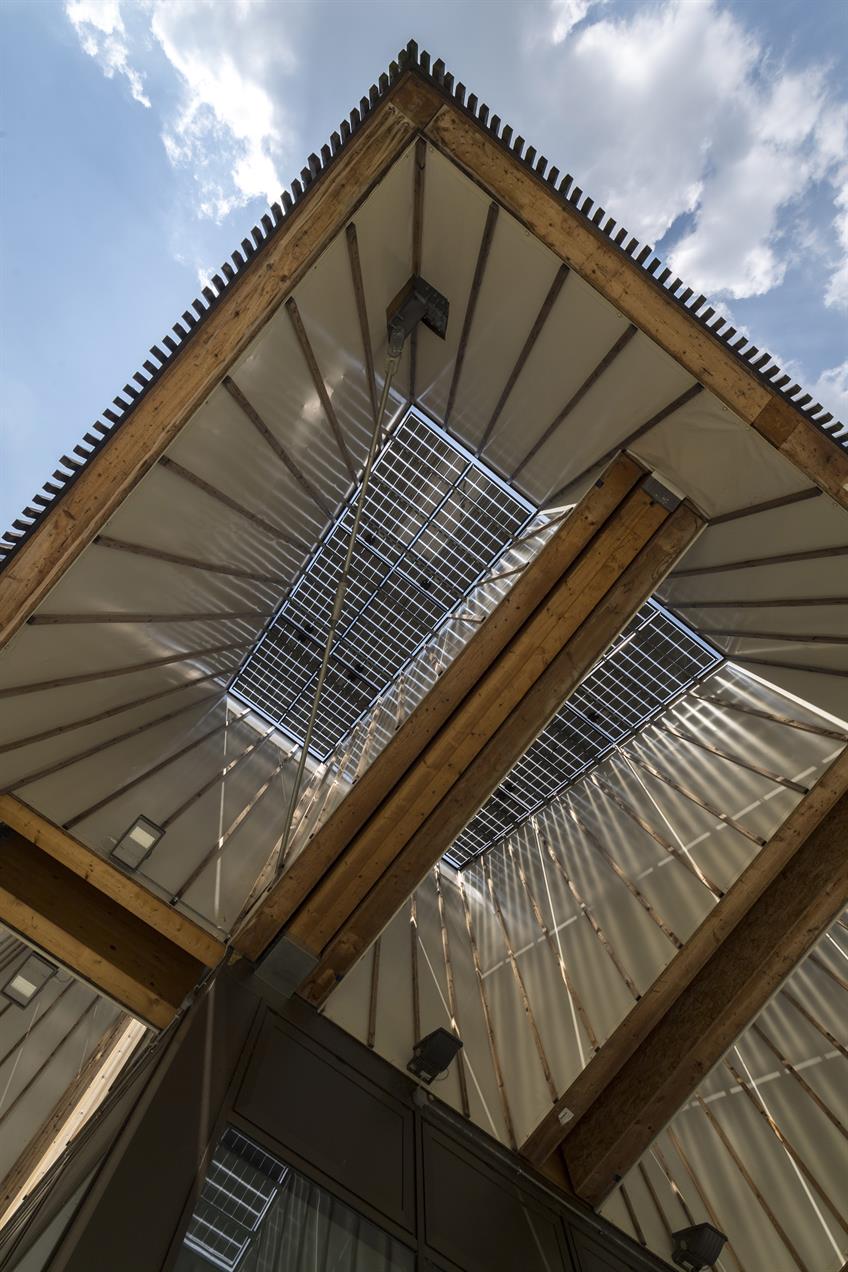




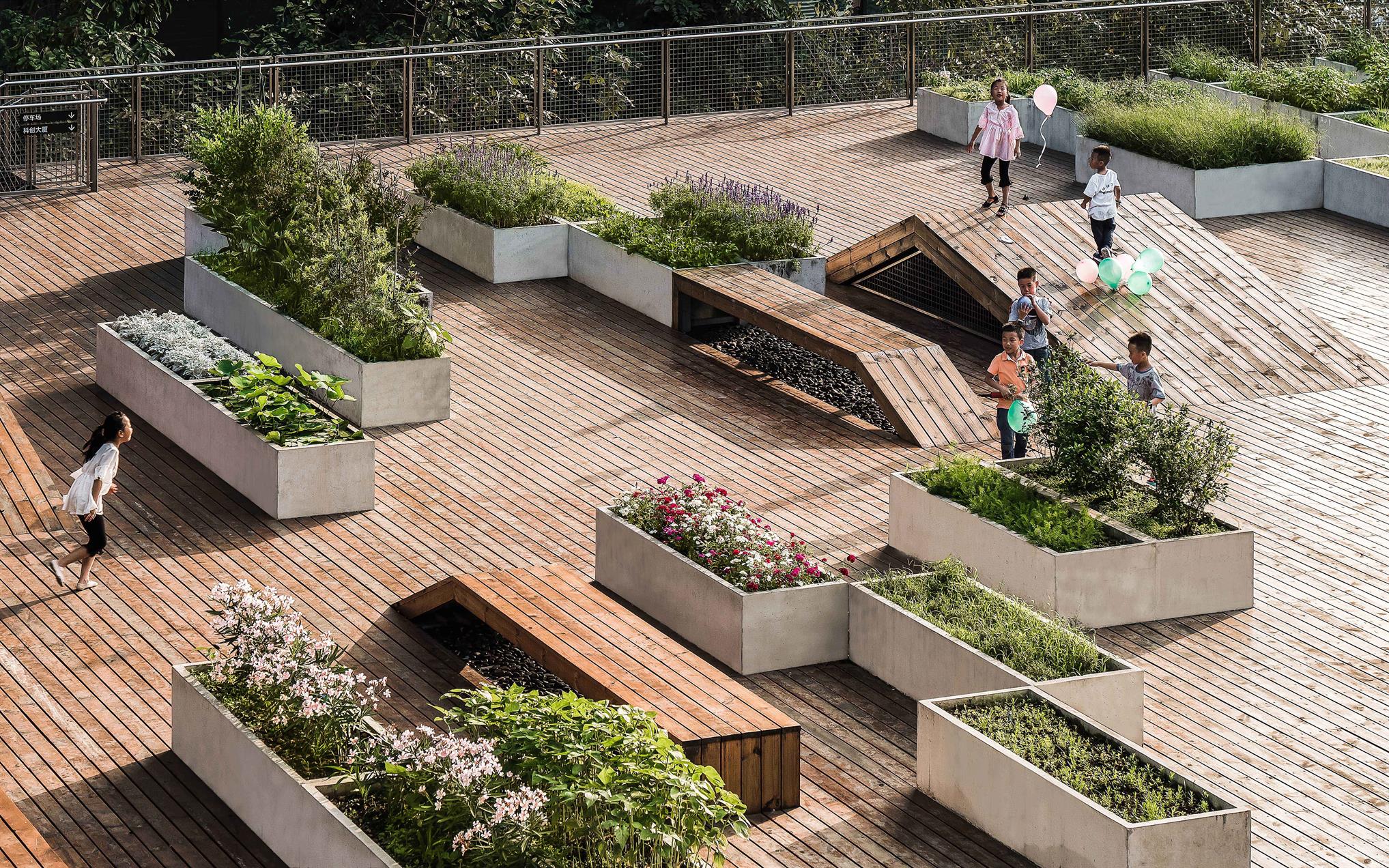
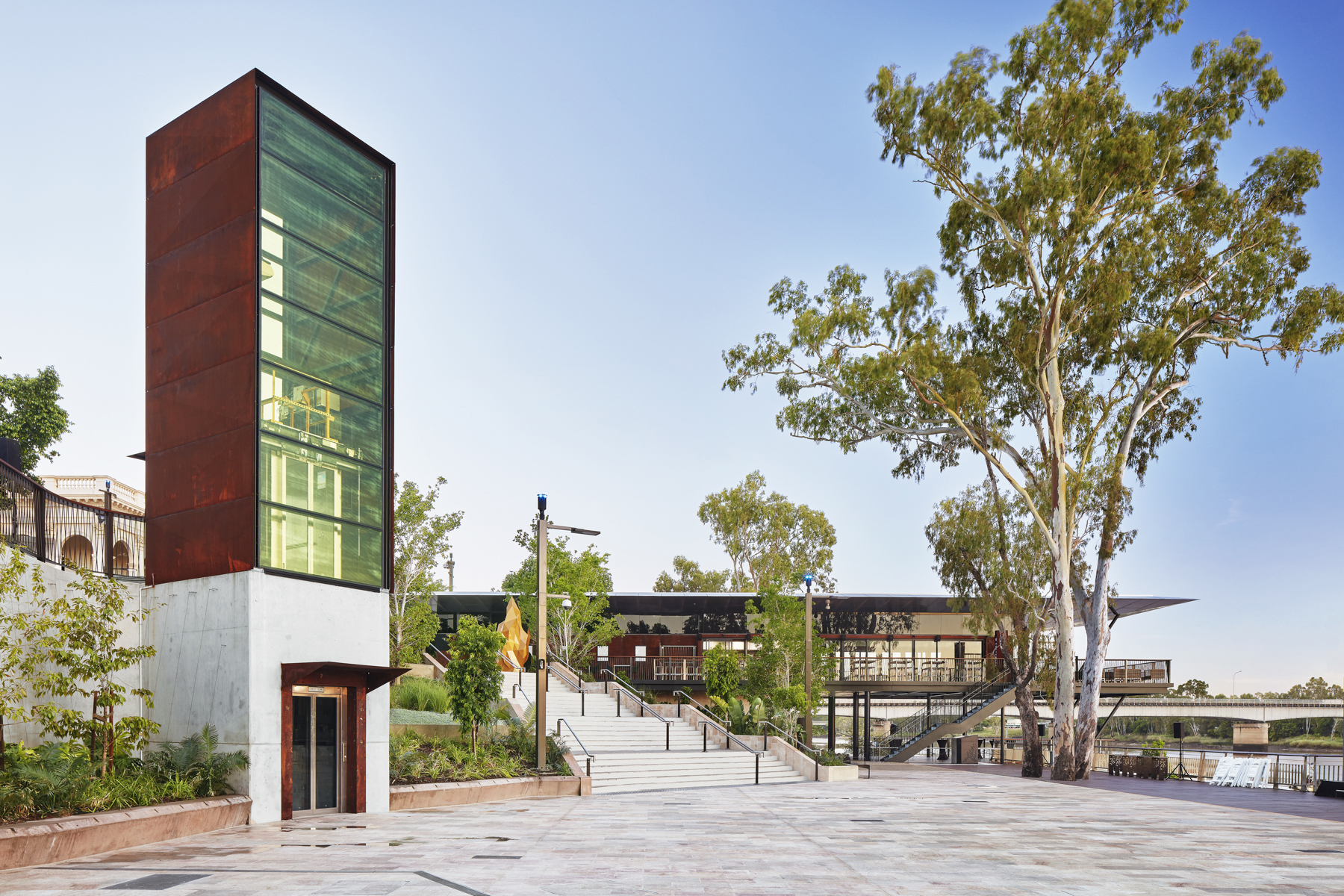
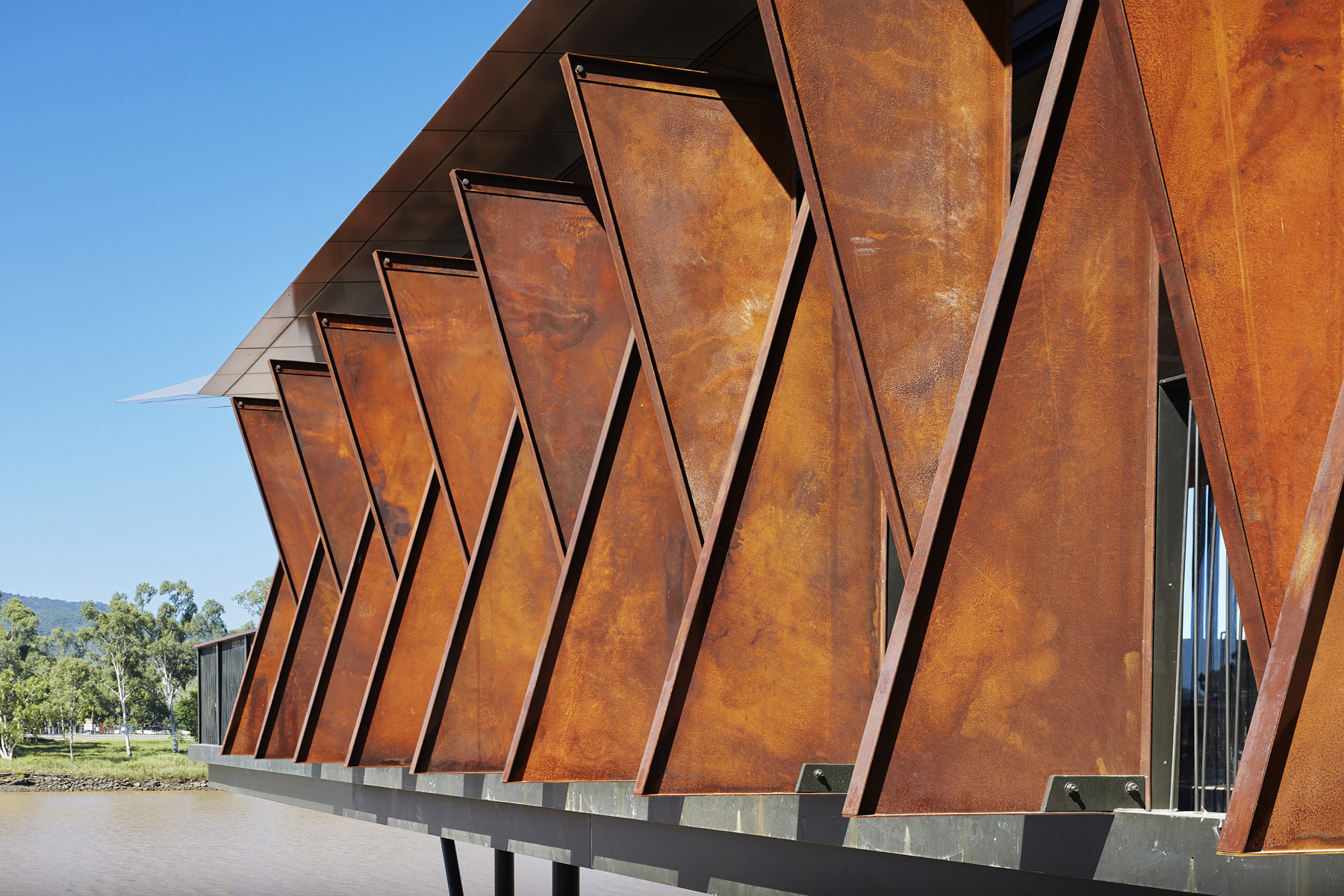



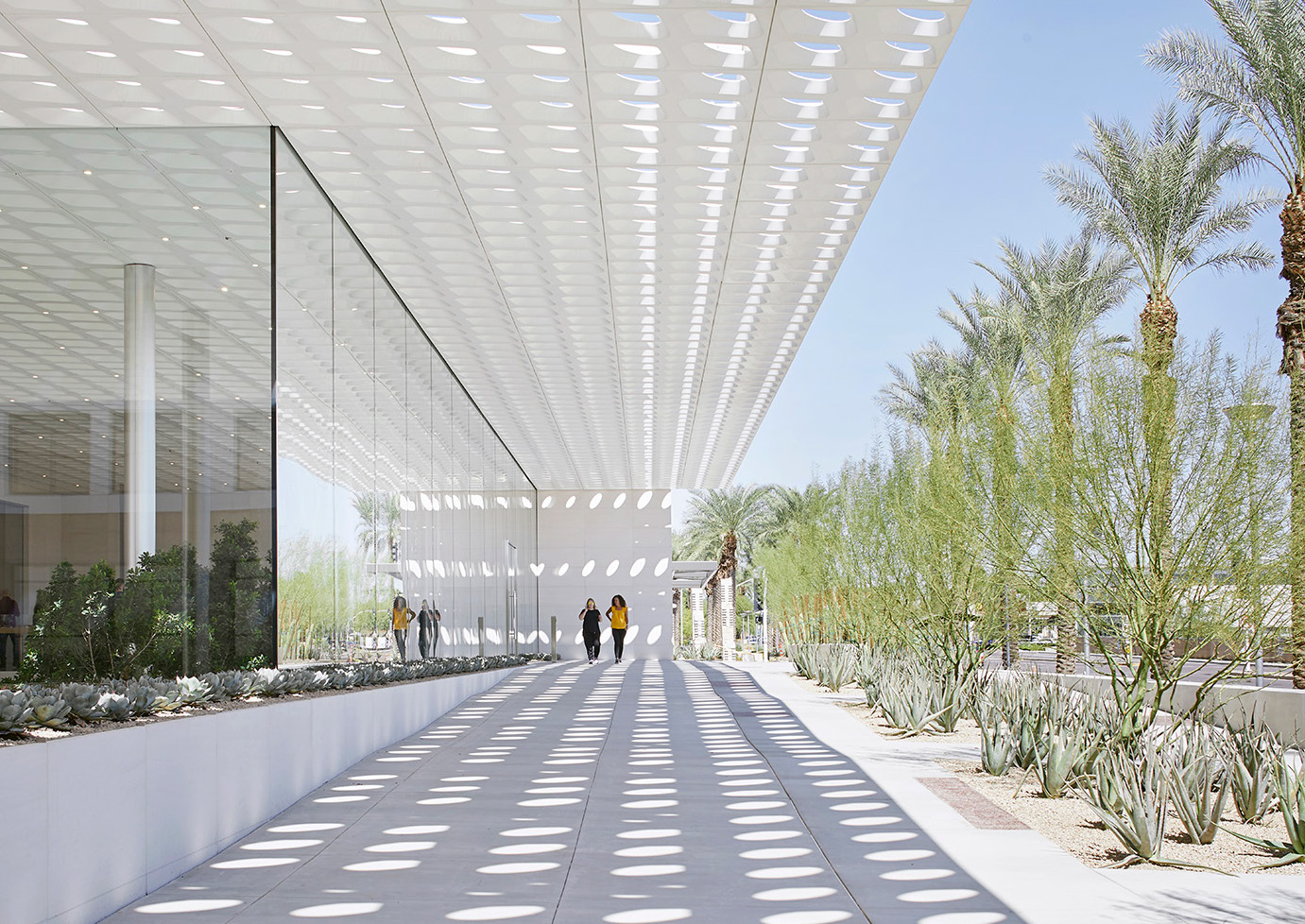
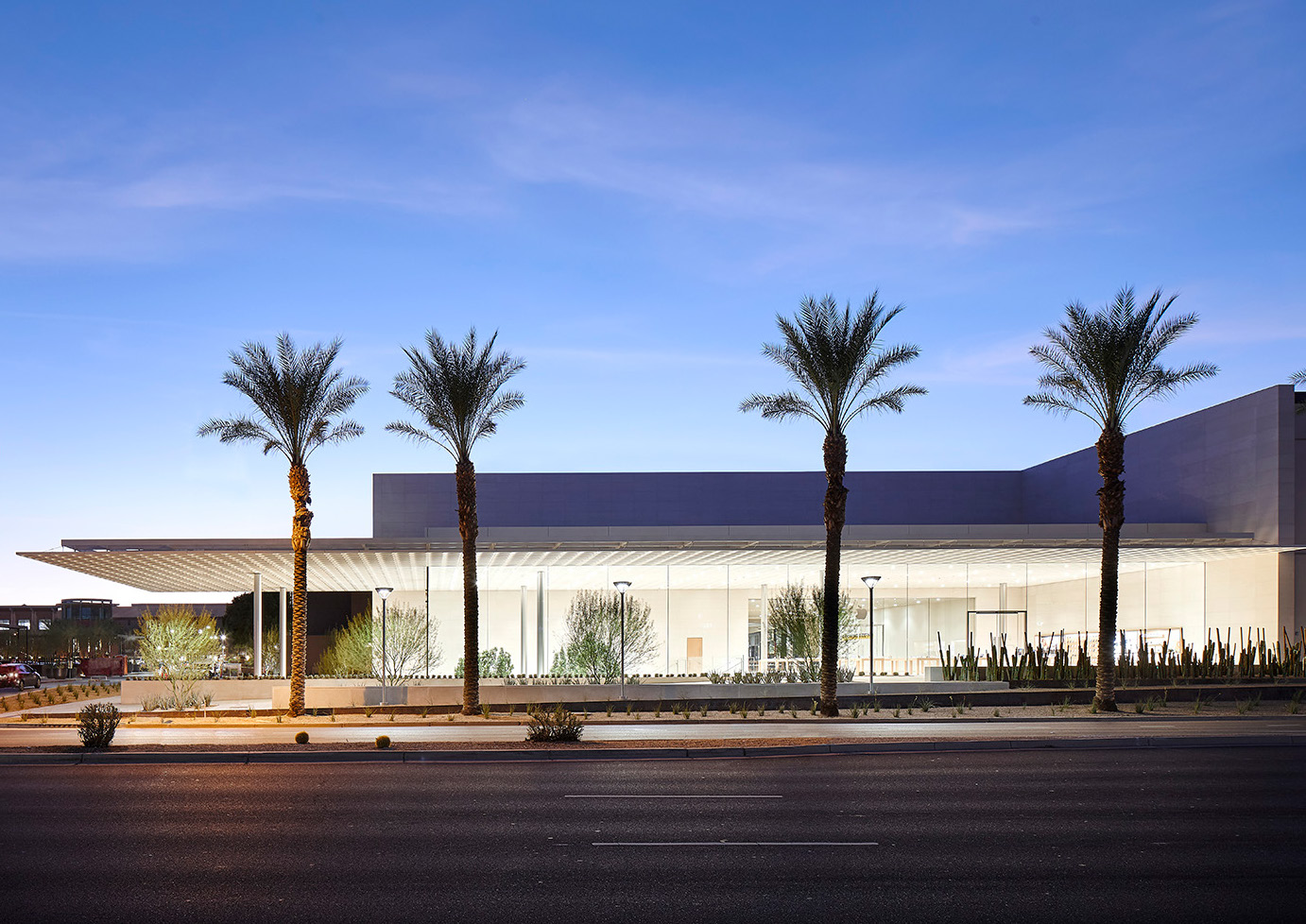
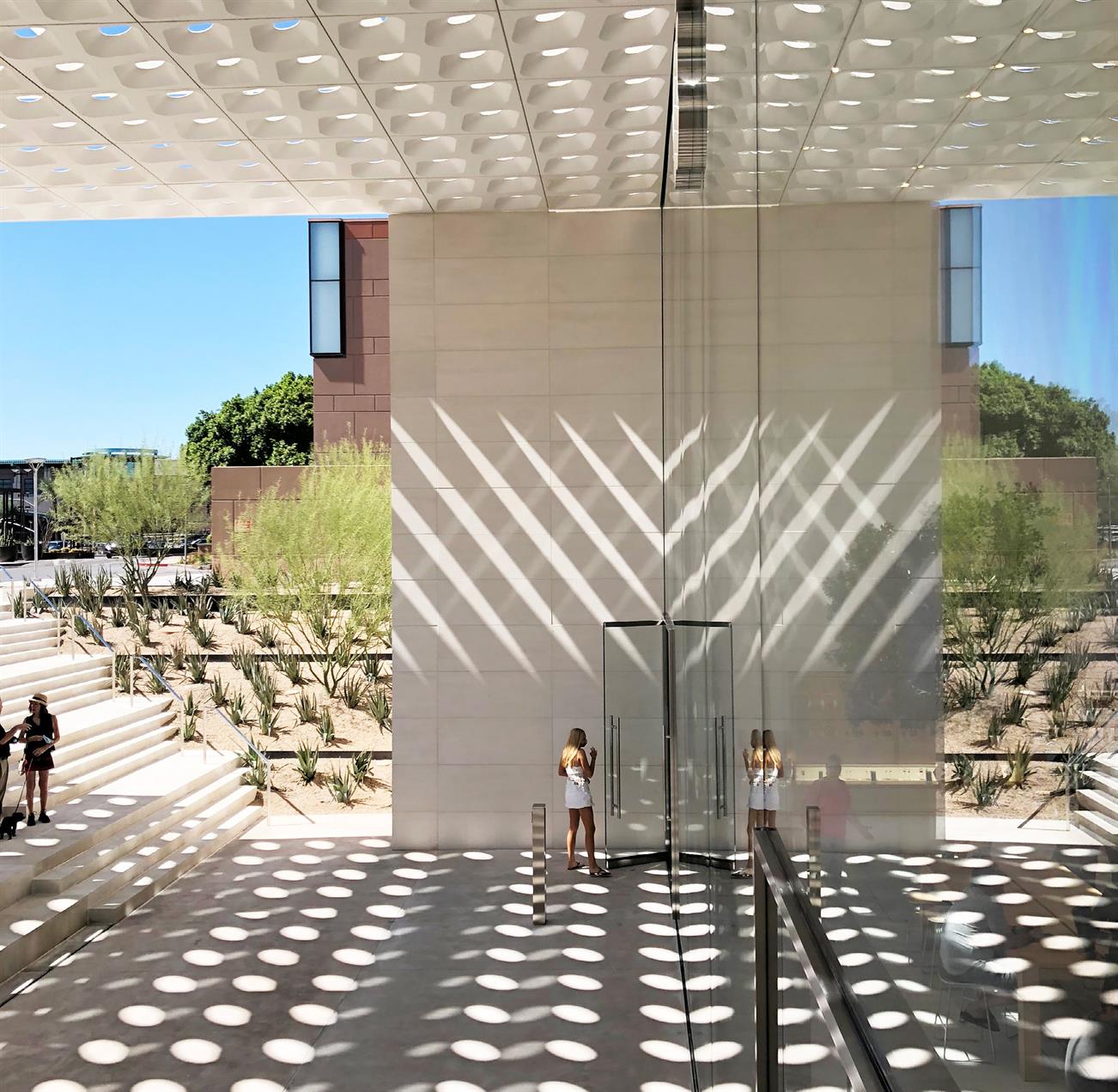
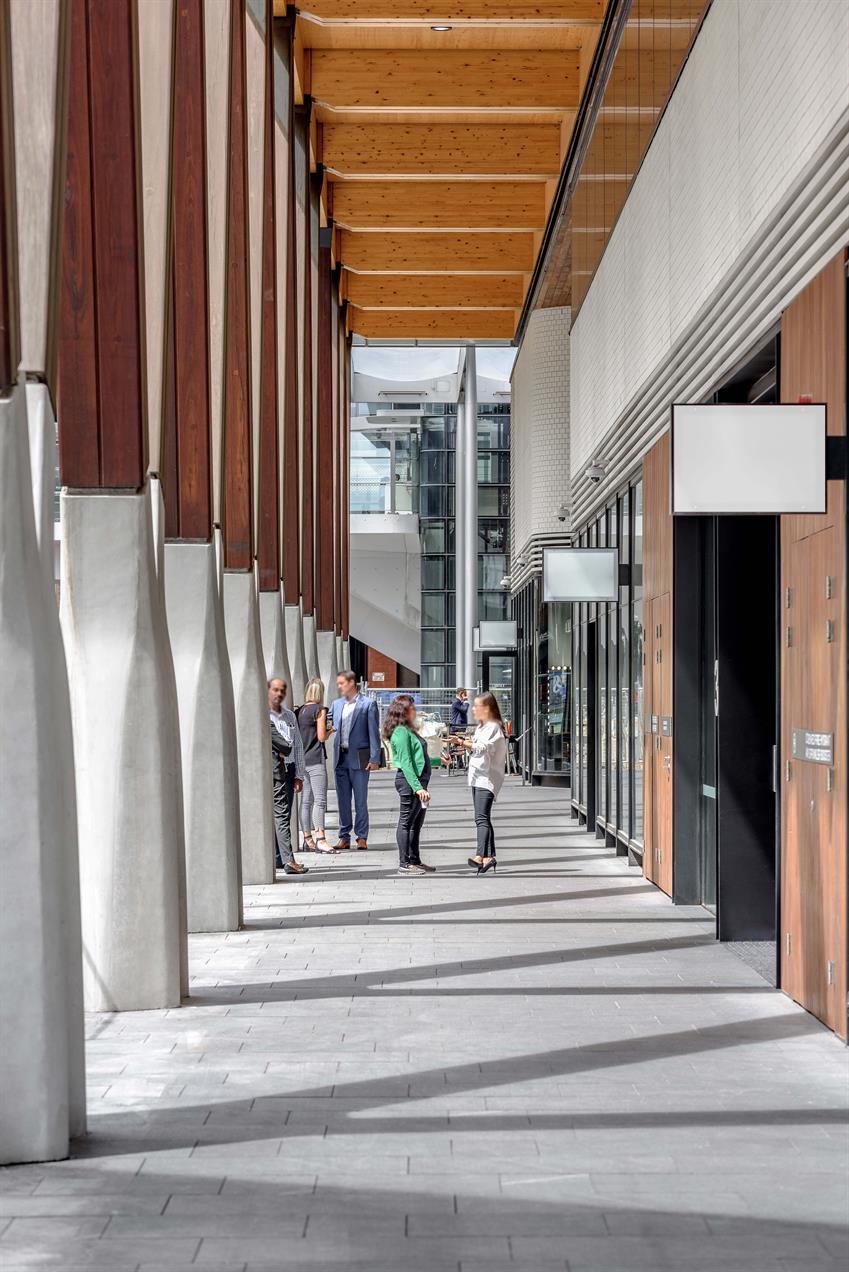
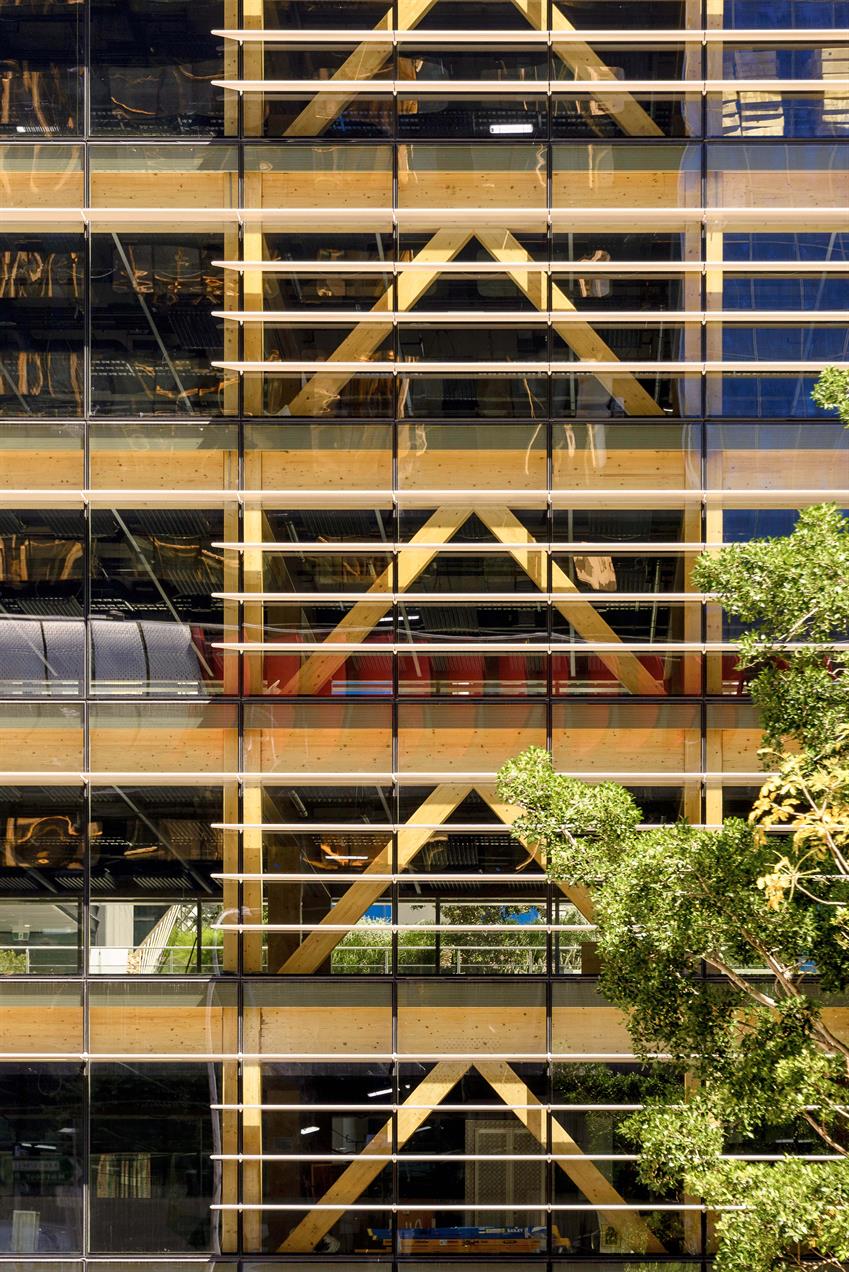


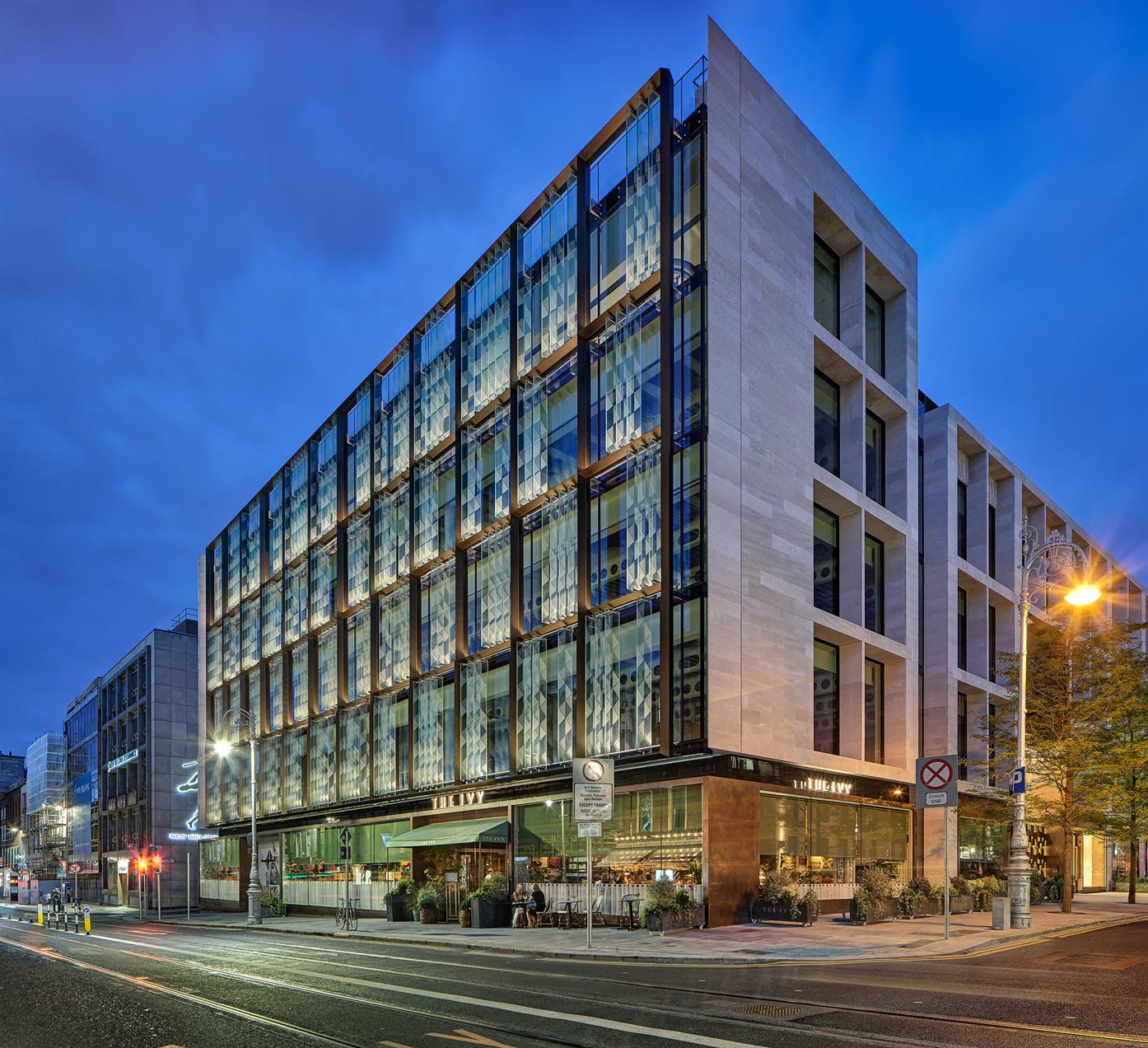



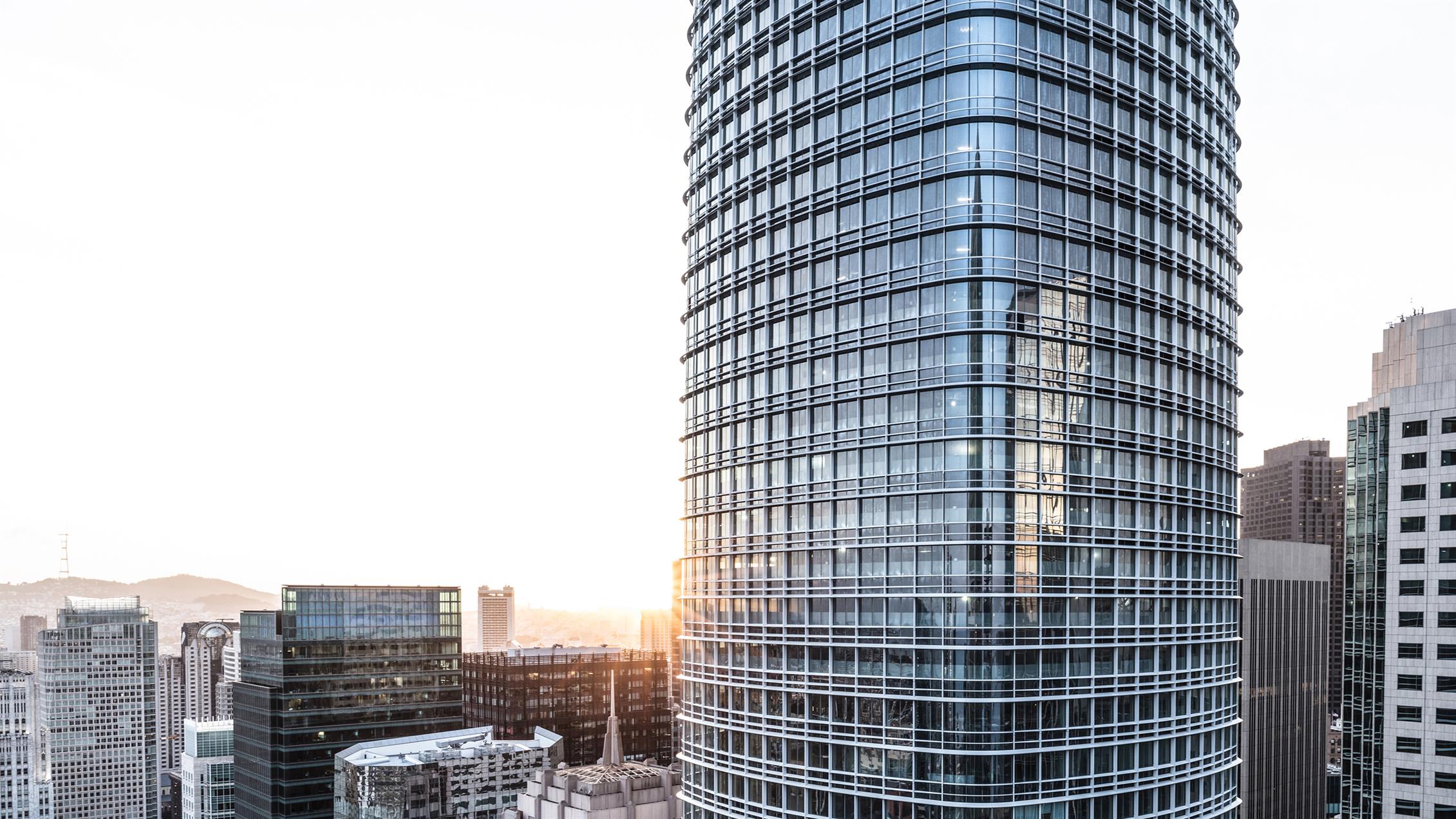
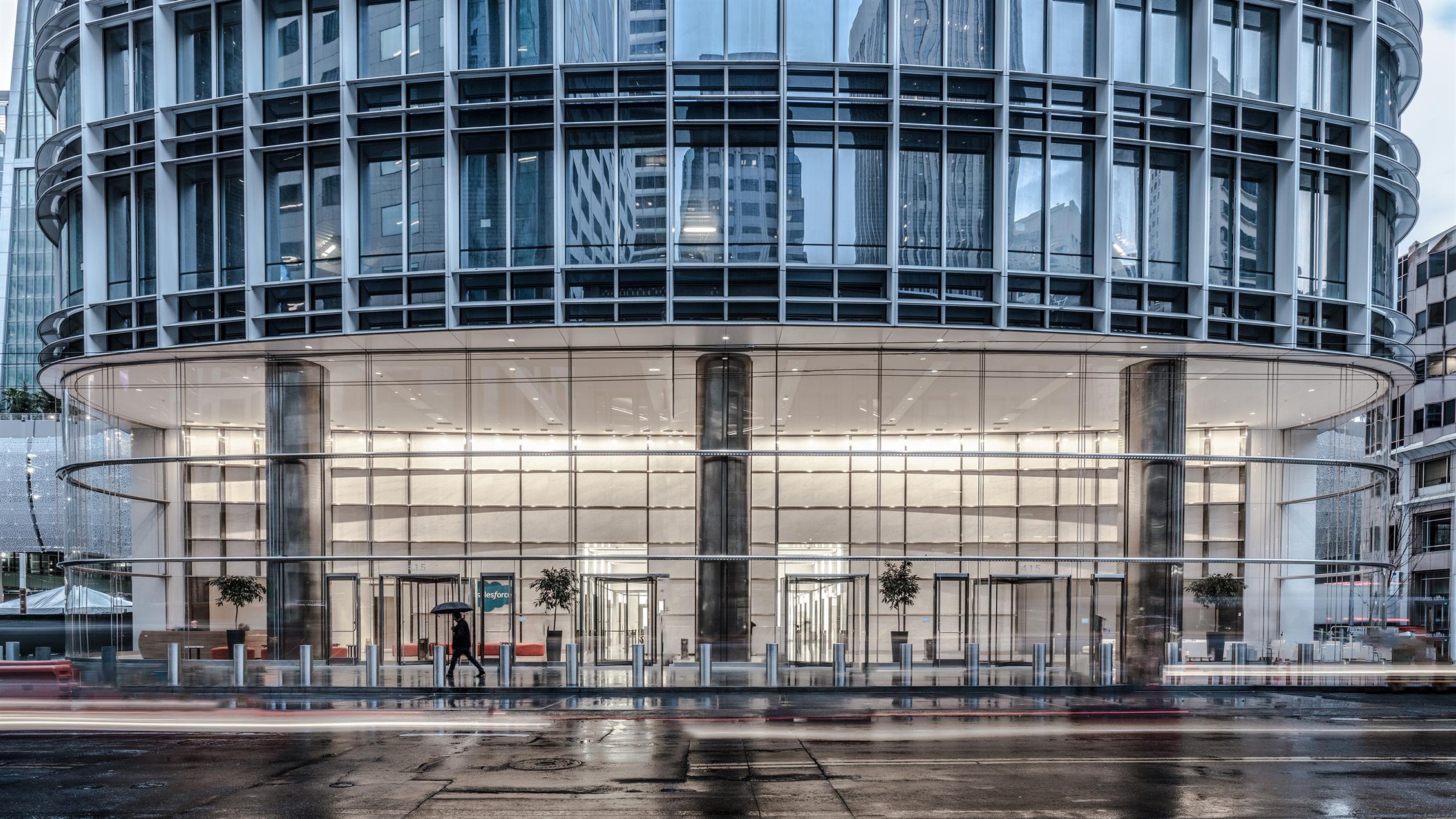
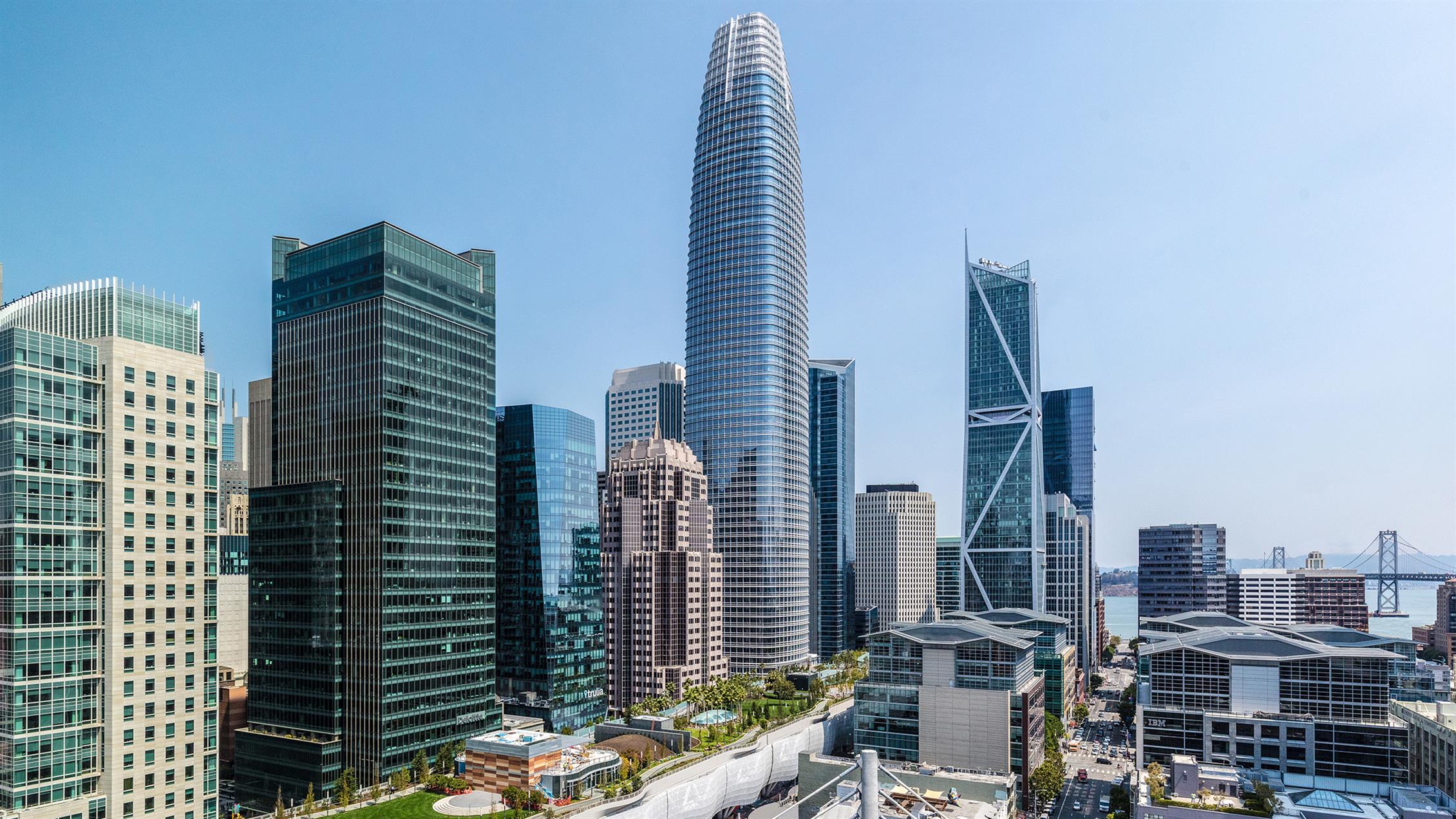
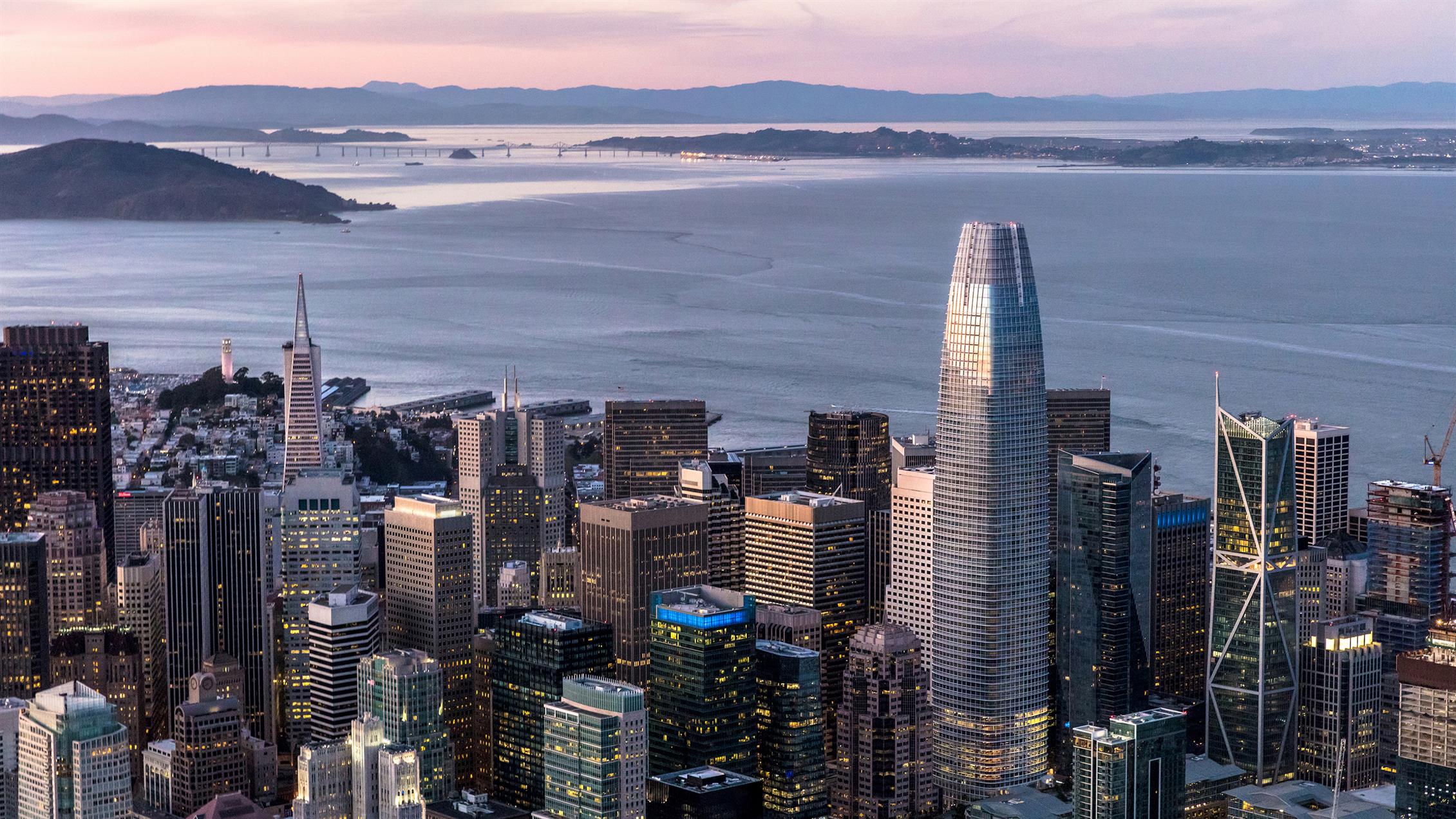
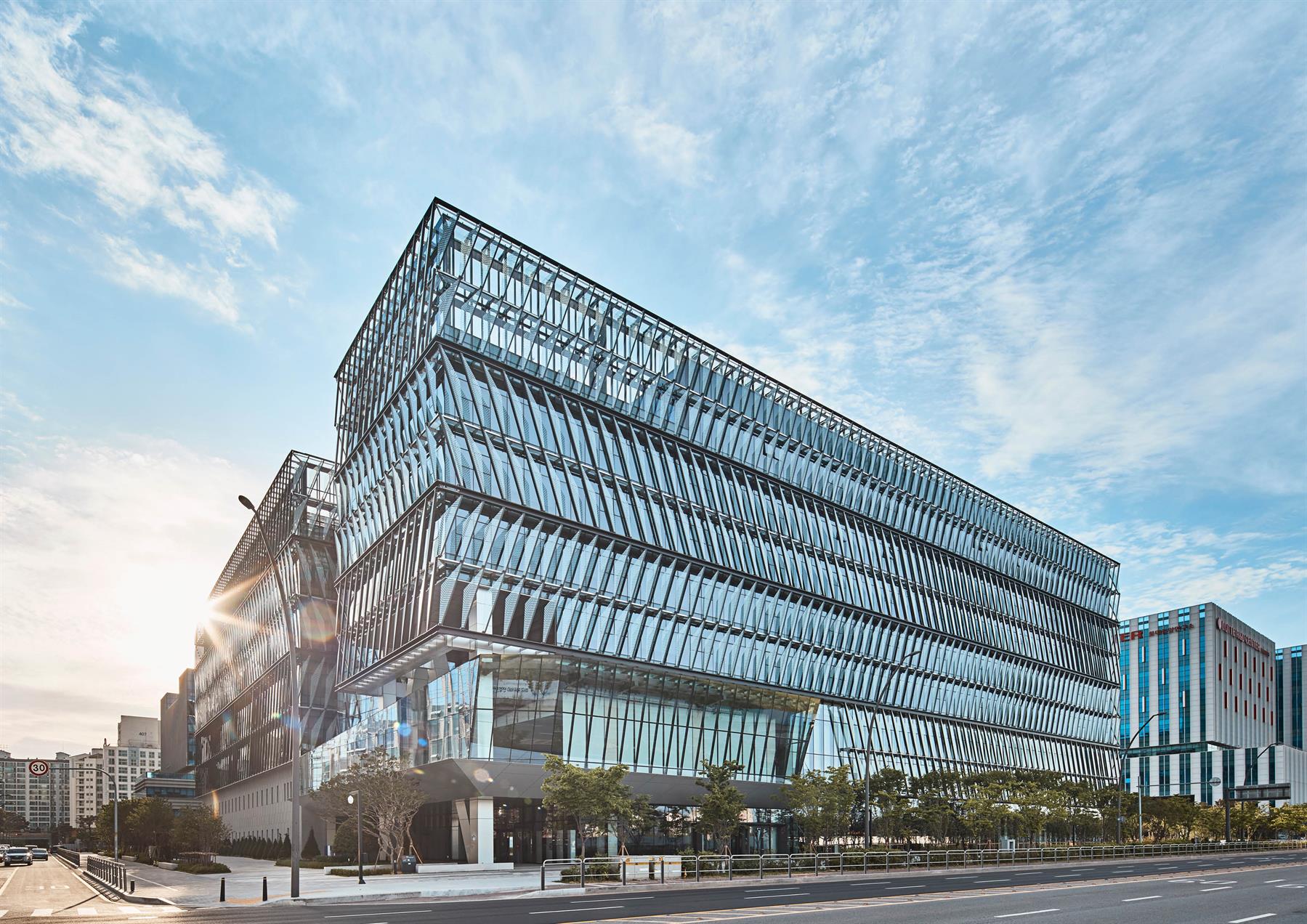
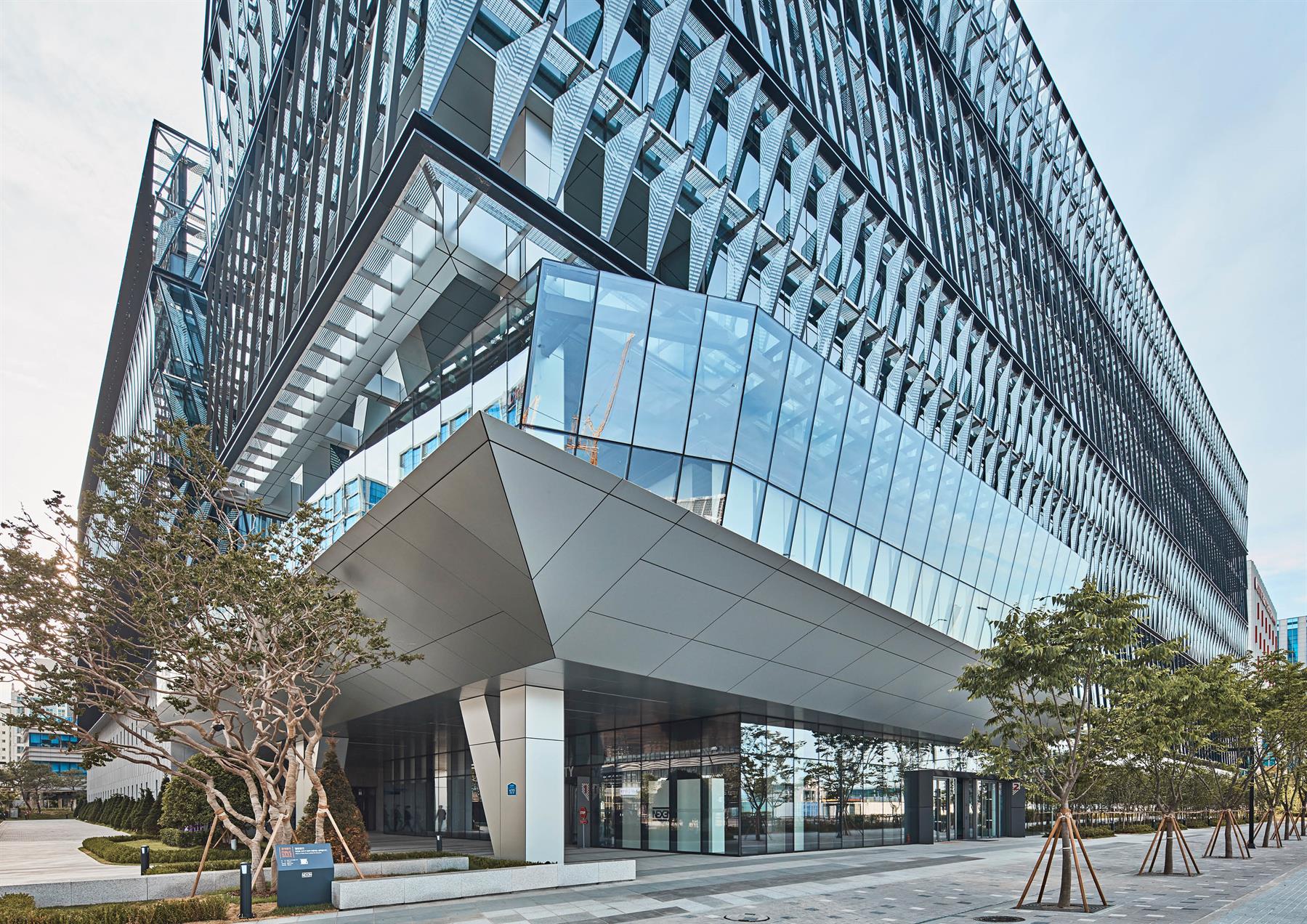



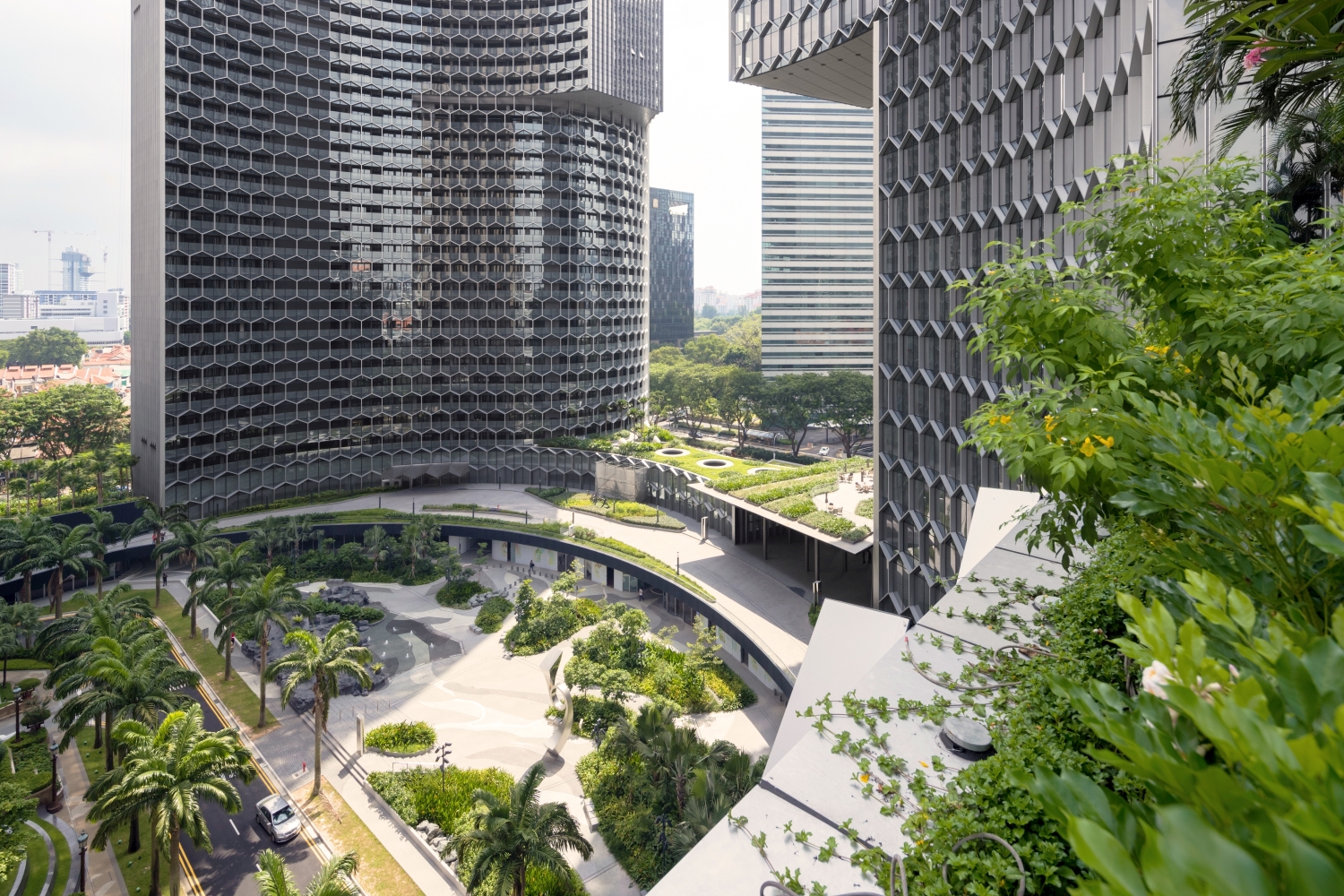
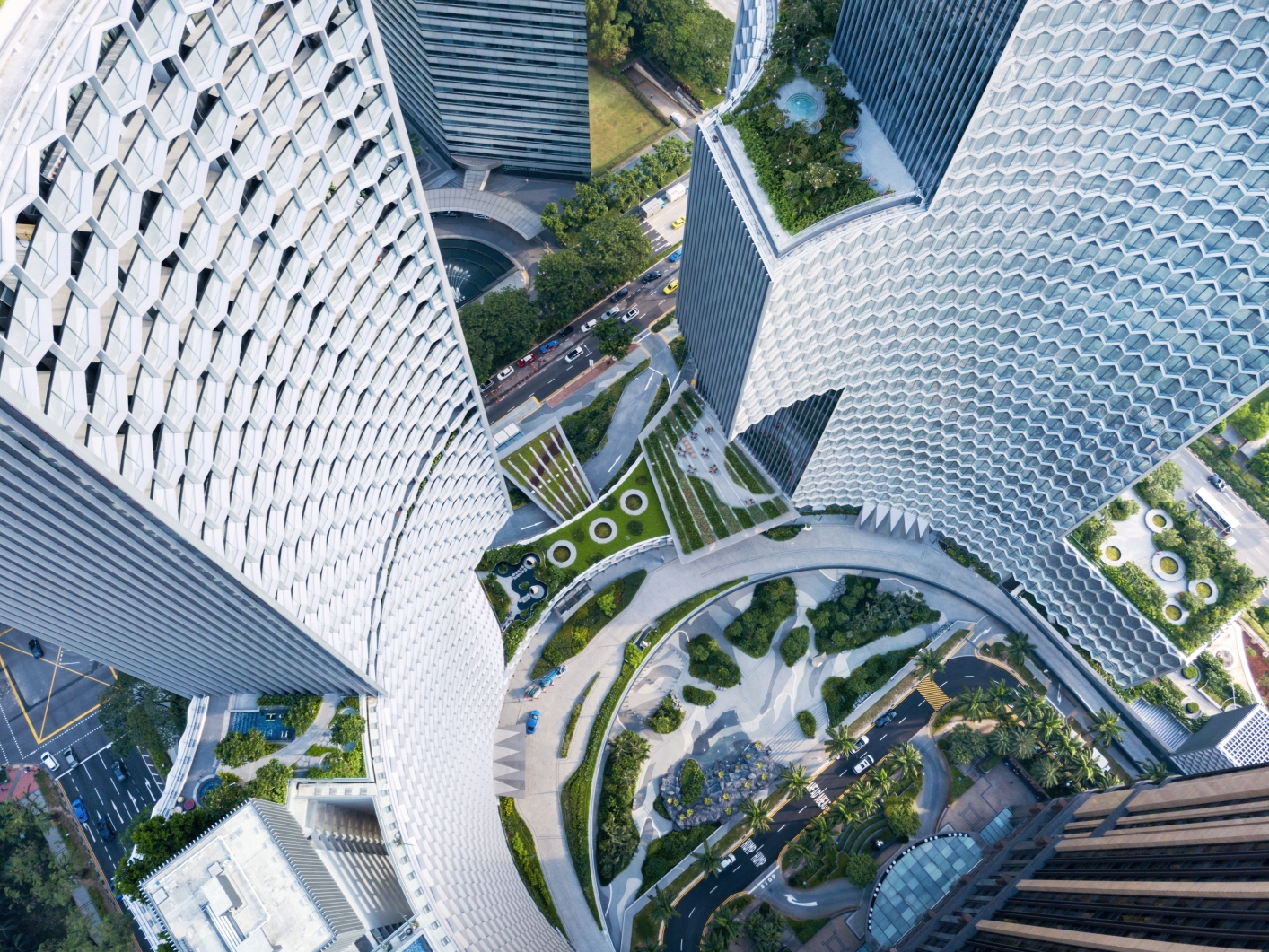
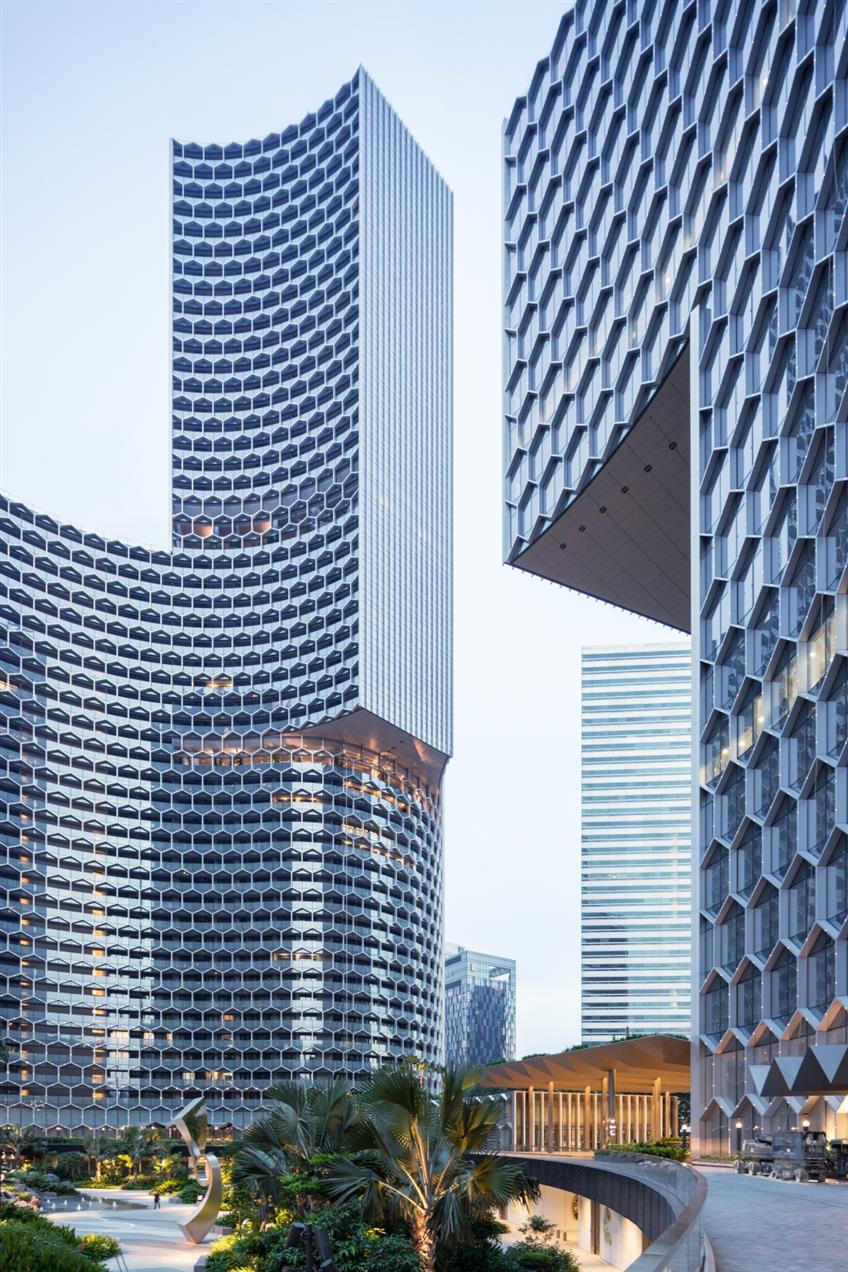

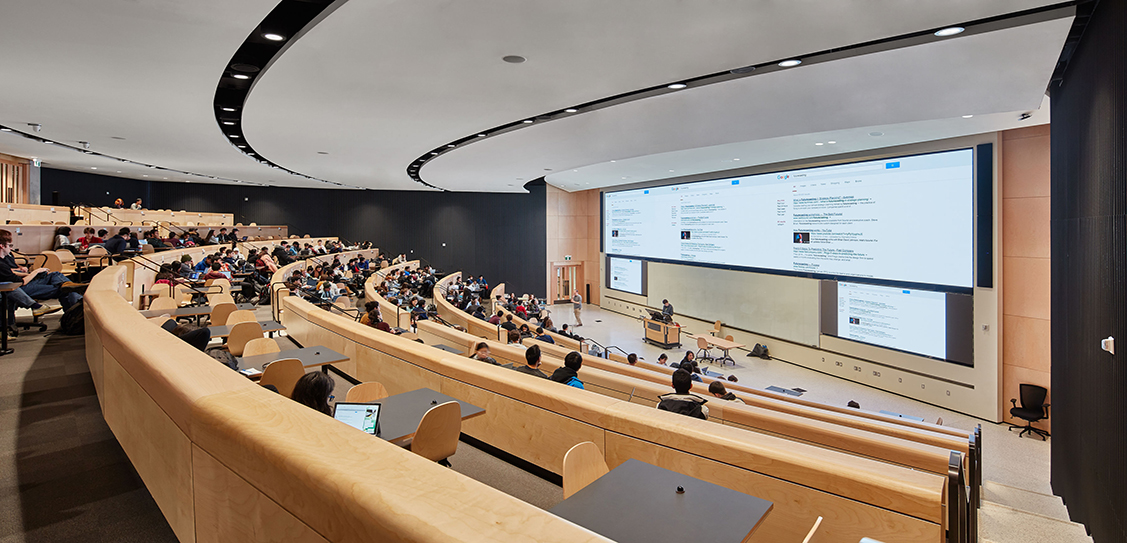


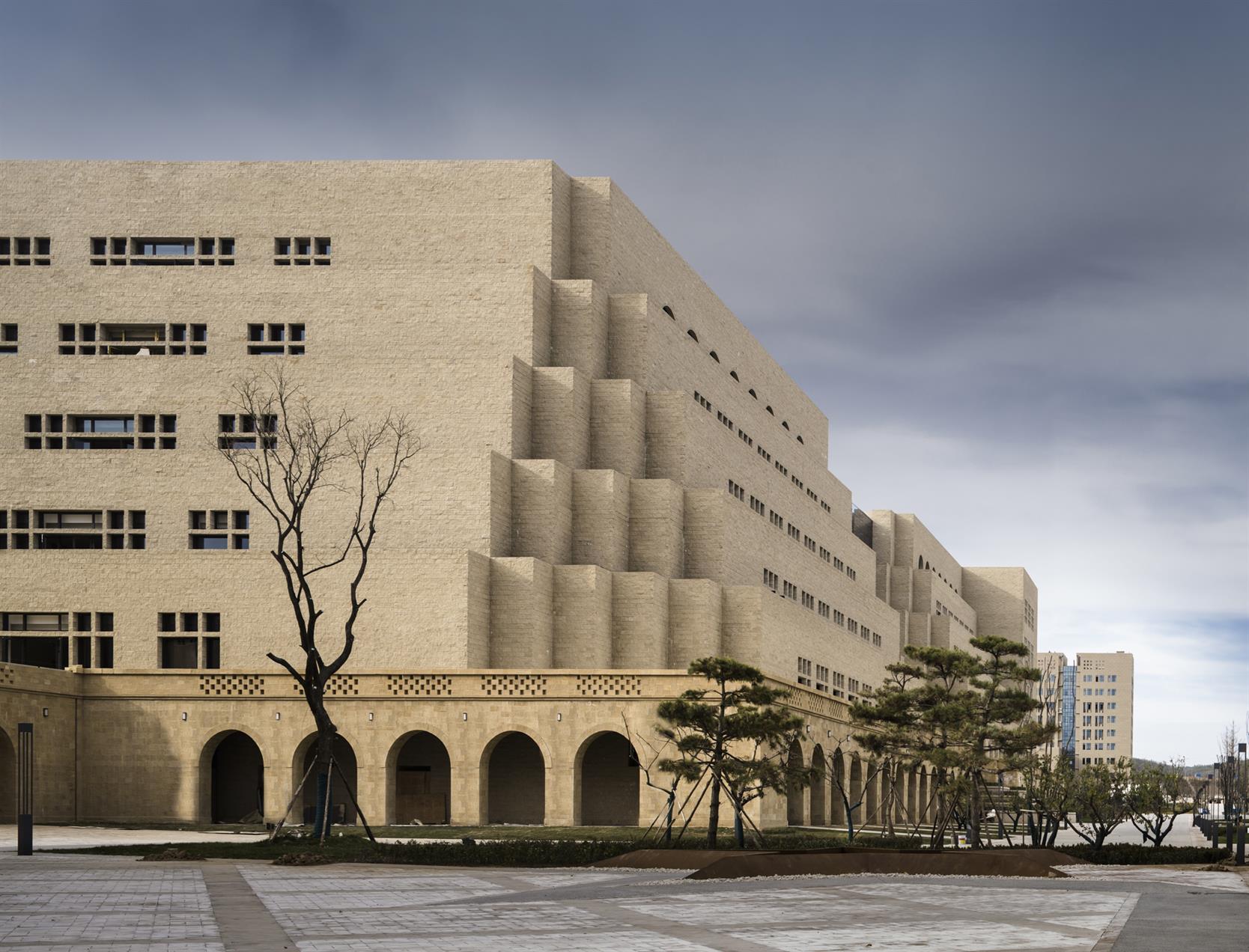
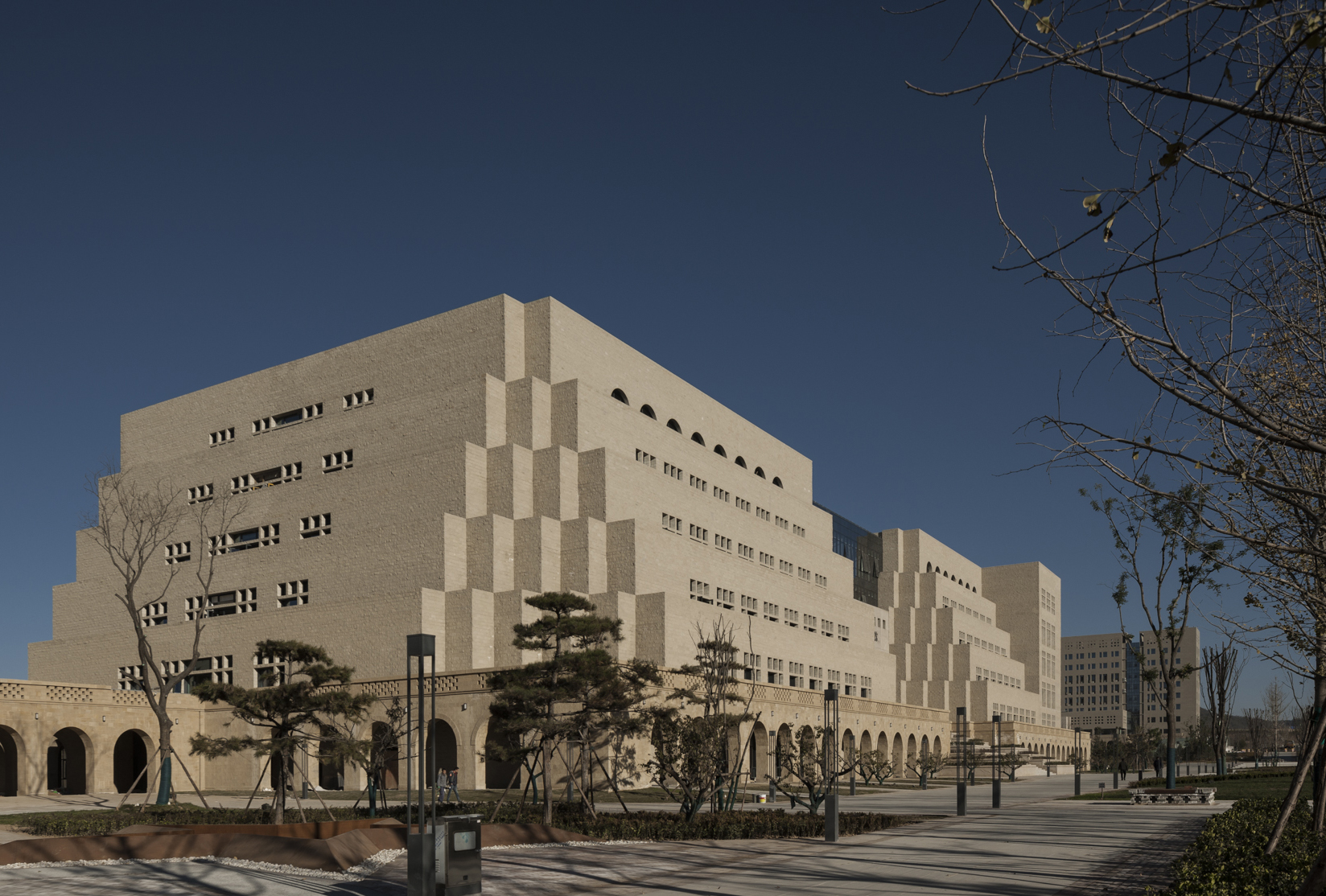
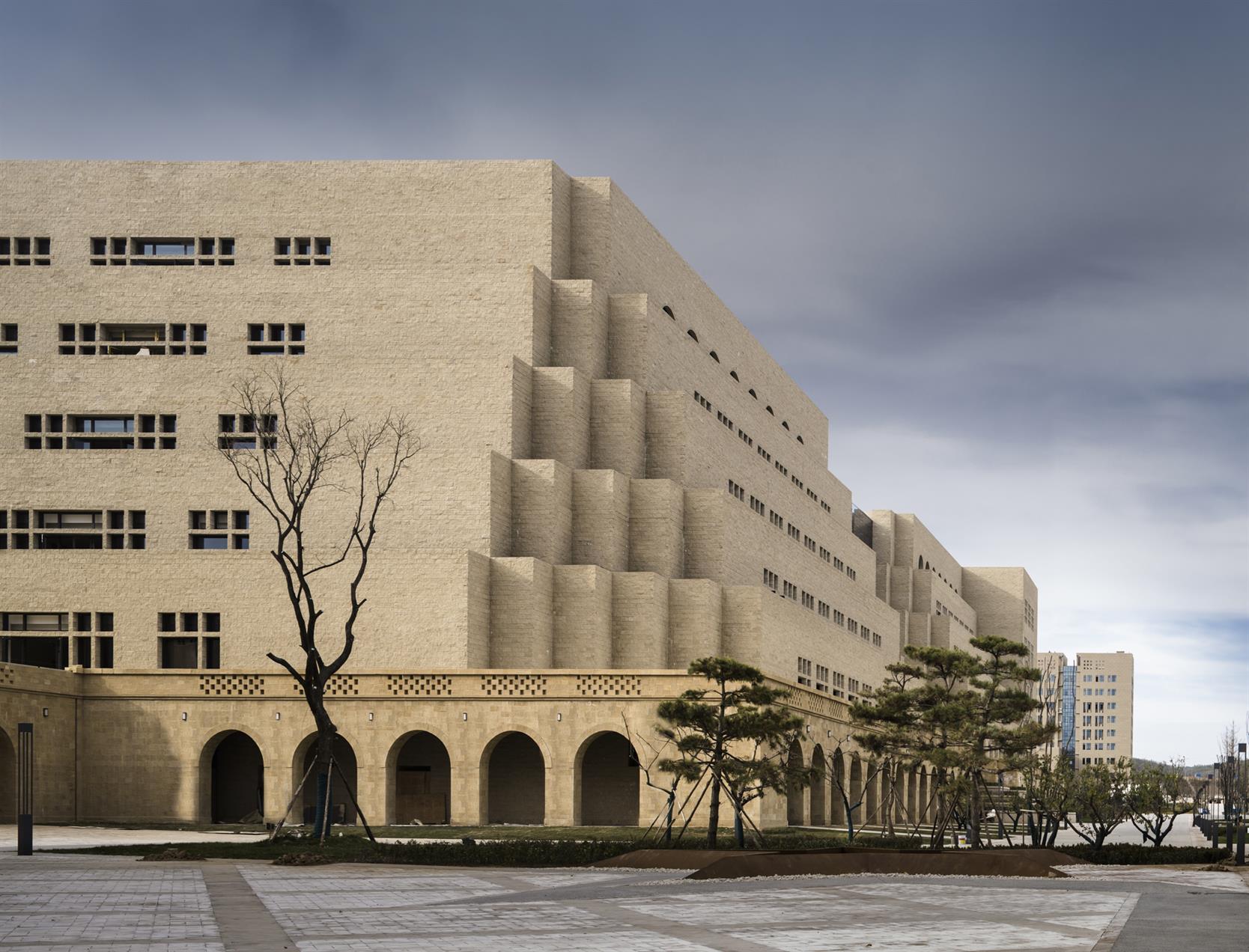
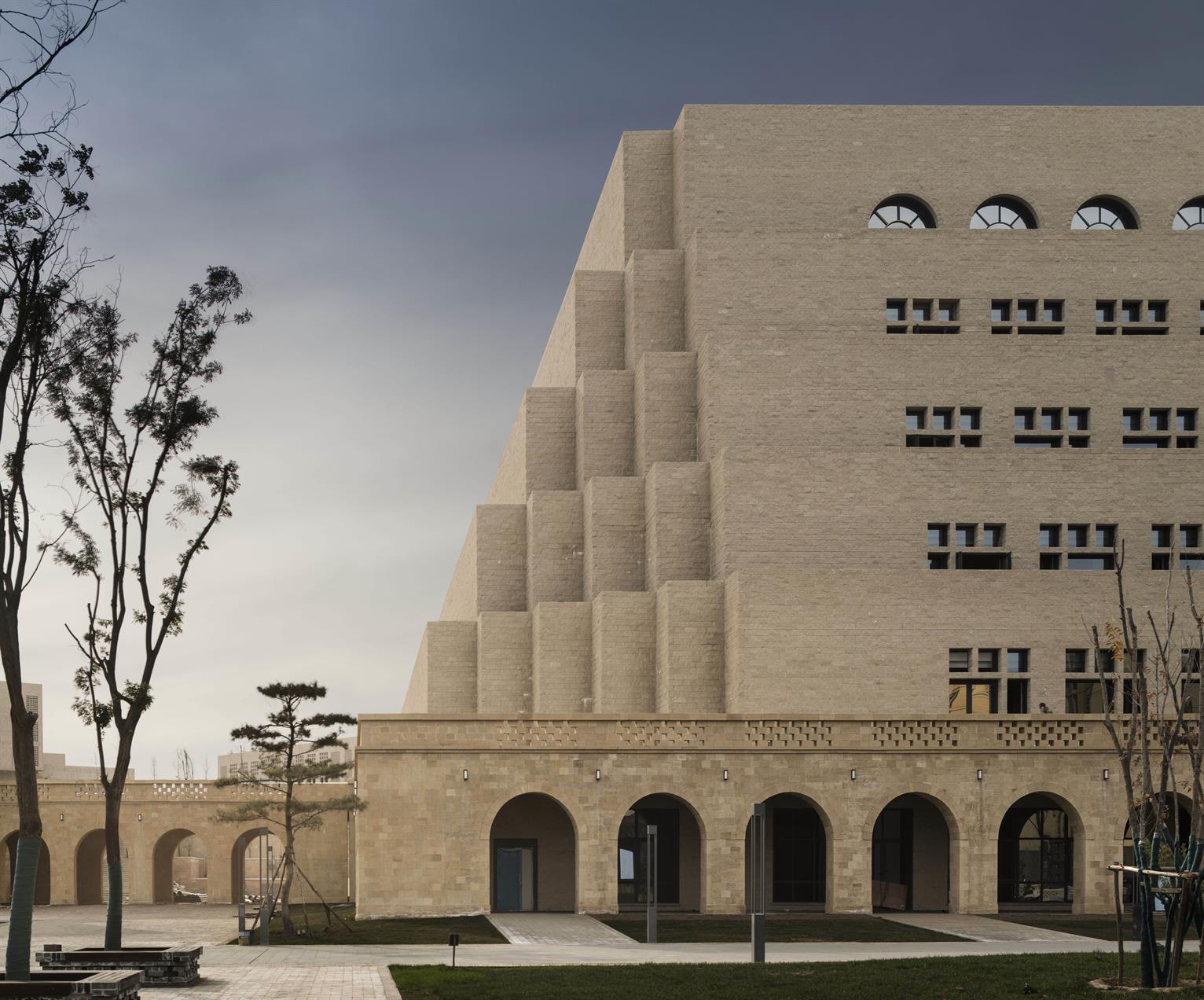

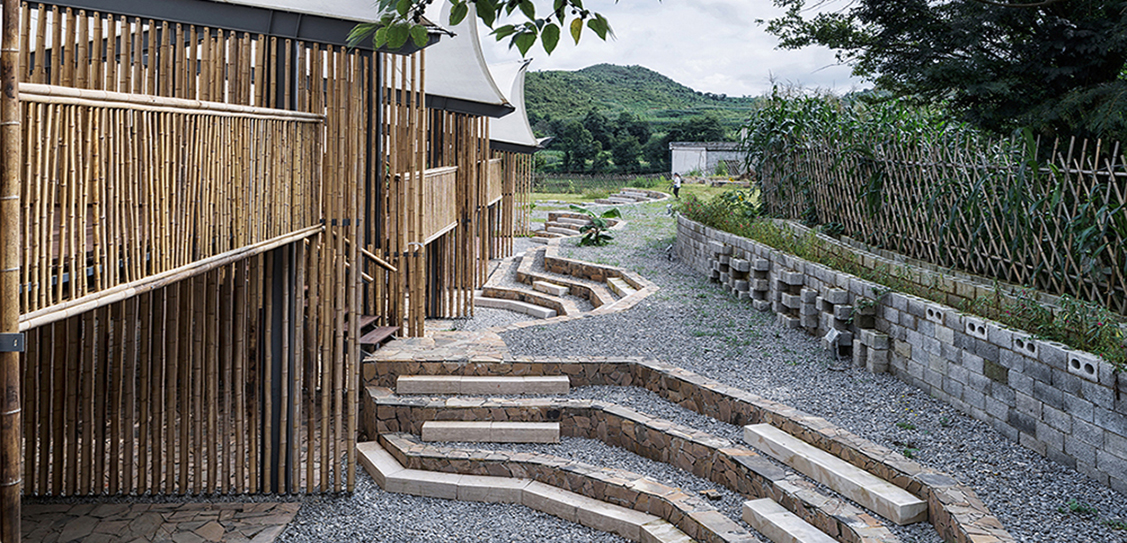
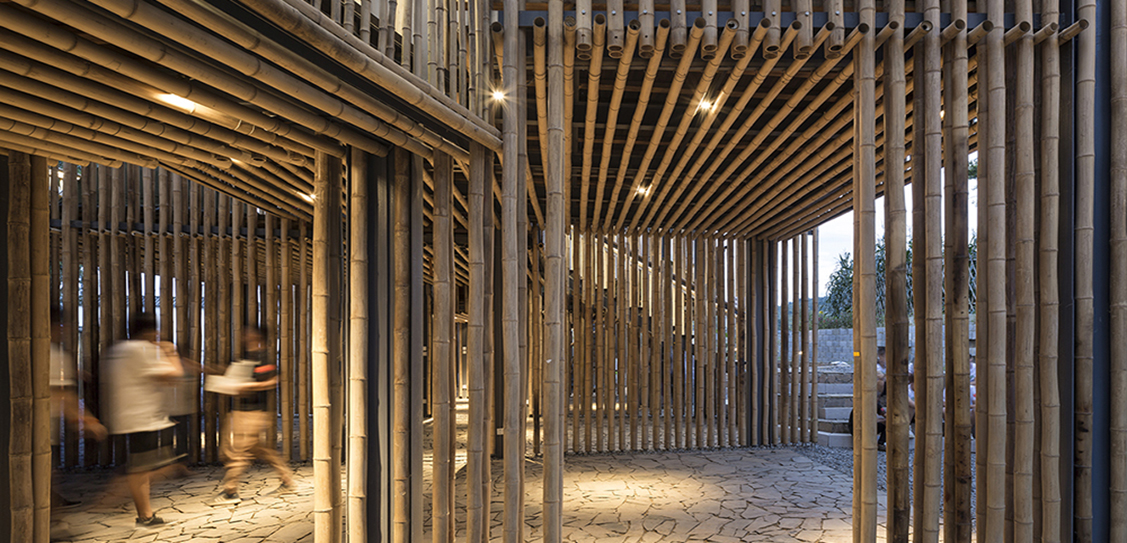



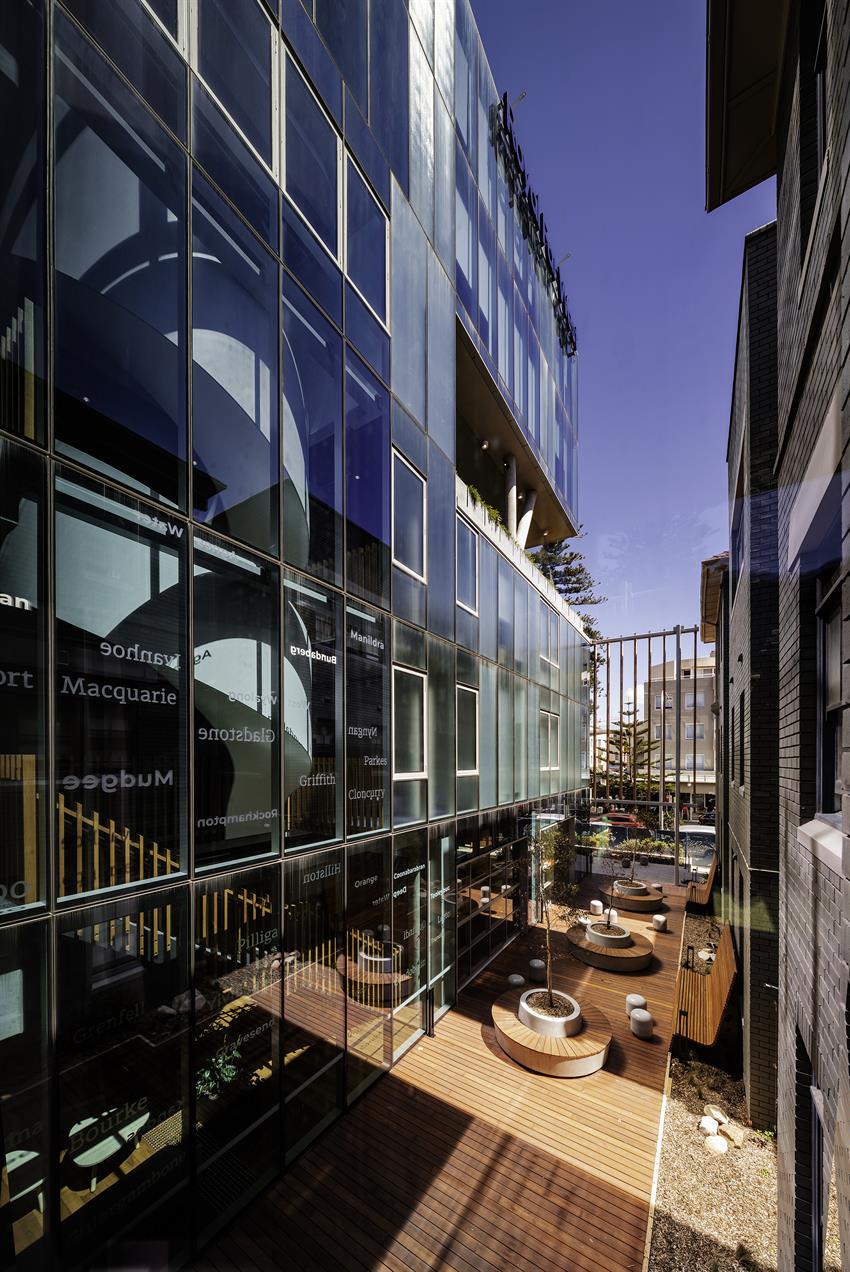

.jpg)
.jpg)
.jpg)
.jpg)

